船員の事件 海運関連業界
UNDER-PERFORMING SHIPS (1年間に3回以上出港停止を受けた船舶) TOKYO MOUのHP
|
★外国の事件及び外国人の事件 3
★ (問題) 2
★ (問題) 3
★ (問題) 4
★ (問題) 5
★Casualty Investigation Code(海難調査コード)2010年1月1日から適用 (USCGのホームページより) 第2回パリMOU・東京MOU合同閣僚級会議の結果について (国土交通省のHP) (サブスタンダード船の排除に向けた我が国の決意を表明) |
|---|
日本(海保)のチェックは甘い!
海保は
サブスタンダード船
問題を理解しているのか疑問に思うことさえある。
映画「海猿」のように体を使うことも重要だが、頭を使うことも必要。頭がないと不適切な書類や問題がある検査会社が発給する検査で証書を発給する証書を持っている
サブスタンダード船
の問題指摘は無理。
一部のPSC(外国船舶監督官)を
除けば、日本のPSCの検査は甘い!!
海保はPSCの現状を知っているのか!
サブスタンダード船排除 (社団法人日本船主協会のホームページより)
と書かれているが、日本の多くの企業が
サブスタンダード船
を理解していないのが現実だ。
荷主や船主も、
サブ・スタンダード船
に係わっているところがある。また、
検査会社
、船主、及び造船所の癒着もある。
やはり顧客確保や利益を考えると、いけないことと分かっていても
問題は起きる。これらの結果が、
サブ・スタンダード船
になる理由である。
最先端経営とクオリティシッピング(日本海事新聞)に「世界の海には
サブ・スタンダード船
がうようよしている。
いや船が
サブ・スタンダード船
なのではない。船を所有する者、運航する者、そして
海上輸送サービスを利用する者が
サブ・シッピング
なのだ。」と書かれています。
ピンポイントで現状を把握していると思います。
ベトナム人船員達による韓国人船長、機関長そしてその他の船員を殺害を殺害した件でいろいろと書かれているが、書いた記者は問題をあまり理解していない、
又は、取材で多くの人々が事実を語らなかったと言う事だろうと思う。
「国に帰れ」と言われ極端な行動に走る
遠洋漁船の非人格的待遇がまた船上殺人呼ぶ 07/01/16(聯合ニュース 韓国語)
By Kim Rahn
Victoria Seychelles
2016年6月20日、韓国・聯合ニュースによると、インド洋を運航していた韓国の遠洋漁船で、ベトナム人の船員2人が韓国人の船長と機関長を殺害する事件が発生した。
6.1 会社は、船長が次の要件を満たすことを確保しなければならない。
6.2 会社は、各船舶に、旗国及び国際的要件に従った免状、資格を有し、か
つ、身体適正な者を配乗することを確実にしなければならない。
6.3 会社は、新たな要員及び安全と環境保護に関する職務に新たに配置転換さ
れた者が、その職務に習熟することを確実にする手順を確立しなければなら
ない。また航海前に示されるべき重要な指示は、明確にし、文書化されて出
航前に乗組員に供与しなければならない。
再発防止策
・・・
「事故当時、ジィア・フイを操船していた当直責任者の中国人男性(37)は、中国近海を航行する免許しか持っておらず、中国の運航会社との連絡や物品購入を担当する「実習生」として乗り組んでいたことも明らかにした。」
運輸安全委員会は上記を事実として信じるのか?
外国で操船することはできない船員資格しか所持していない船員が乗っている外国籍船は存在する。
韓国のPSCは2007年1月5日にパナマ籍船舶「RUI YANG」号を船員の免状 「Captain, chief engineer, 2nd officer & 1st engineer's licence not applicable for world wide trade. (valid only chinese greater coastal, coastal & near coastal vayage)」 に問題があるとの理由で出港停止命令を出した
件では士官の船員は全て「見習い」ではなかったと言う事か?
運輸安全委員会が衝突事故前に寄港した港の代理店から船員リストをチェックしたのか?船員リストには
船員のランクが記載されている。Deck Cadetと記載されたいたのか?また、本当に「実習生」で当直に関与しないのであればMinimum safe manning certificate(最少安全人員証書)の要求
を満足するだけの船員が乗船していたのか?
運輸安全委員会は26日、平成25年9月に東京・伊豆大島沖で貨物船「第18栄福丸」の乗組員6人全員が死亡した衝突事故についての調査報告書を公表した。衝突した西アフリカ・シエラレオネ船籍の貨物船「ジィア・フイ」が、中国人船長の指示で第18栄福丸の船体に刺さった船首を引き抜いたために転覆が早まった可能性が高いことを明らかにした上で、「転覆までに時間的余裕があれば、乗組員は脱出できた可能性があった」と指摘した。
Stephanie Chao The China Post/ANN
クリアハイト203cmについて新ILOと表現されているが、これは新ILOではない。
1949年の船員設備条約(改正)(第92号)のは条約発効日:1953年1月29日。2006年の海上の労働に関する条約によって改正され、現在は批准に開放されていない条約 (ILO)ILO第92号では190cm、そして
1970年の船員設備(補足規定)条約(第133号)のは条約発効日:1991年8月27日。2006年の海上の労働に関する条約によって改正され、現在は批准に開放されていない条約 (ILO)ILO第133号では198cmが要求されていた。日本が批准してこなかっただけで、批准していた国々は存在する。日本の国土交通省が適用の必要のない内航船に対して適用を決めただけで、ILOを非難するのは勘違いで間違っている。推測であるが、日本(国土交通省や外務省)の見えで内航船にも適用したと思う。加えて言うのであれば内航船を使う業界や大手企業、又は、船主が船員の労働環境を犠牲にすることで出来るだけ安く荷物を多く運びたいと思ったから国土交通省が2006年の海上の労働に関する条約の一部を内航船に適用するまで過去の基準が適用されて来た。同じ投資額で運べる荷物が減ったので安全性を犠牲にしても載貨重量を増やそうとするから、安全性が落ちる船の設計及び建造となるのである。安全や環境のためのコストアップを受け入れるのであれば問題ない。消費税アップで下請け企業が負担を強いられたケースと同じである。業界や大手企業が負担を受け入れないからシワ寄せが船主に行くのである。同じ499GT貨物船でも平水だけ、沿海だけそして近海区域までの要求を満たす船では、要求される条件により載貨重量などが違ってくる。平水区域を満足するだけの条件で建造された499GT貨物船は近海区域の資格を取れない事も多くある。全てはどのような基準を適用するかである。
苦情を言うのであれば相手は国土交通省である。いっそのこと、外売された平水区域で建造された499GT貨物船が載貨重量3000トンとなり遠洋区域で航行されているのだから、それぐらいの承認がほしいと訴えれば良い。外売された499GT貨物船が載貨重量3000トンで遠洋区域で運用されている事実は、平水や沿海区域ではもっと安全である事は証明されている。安全係数や安全基準次第である。安全係数や安全基準を下げれば事故発生率は上がるが、経済的負担は減る。
2006年の海上の労働に関する条約は船員のバックグラウンドの人達よりも、弁護士や法関係者達が条約に関わっているで、技術的な事は考慮していないと思う。日本政府(国土交通省)がどれだけ発言権や関与出来たのかは知らない。手を打つのであれば国際条約として採択され、発行される前に行動に移すべきだった。これも非難するのであれば相手は国土交通省。一番影響を受けるのは多くのILO条約が適用されずに建造された国籍の船。大きなインパクトがあるのは常識で考えればわかること。
The International Transport Workers’ Federation (ITF) reports that crewmembers aboard a Korean bulker docked in Mackay, Australia, were literally starving. The ITF says the conditions aboard the flag-of-convenience (FOC) ship are a stark reminder of the risks that mariners can face in the unregulated world of FOC shipping. The Conservative Australian government is seeking to repeal that country’s version of the Jones Act and open the domestic trades fully to FOC vessels.
オリョン号 (Oryong 501)と思潮産業 (Sajo Industries)で検索したら思潮産業 (Sajo Industries)は過去に船員の給料未払いや漁船の沈没による船員死亡事故を起こしているようだ。それらを考慮すると、今回の事故は起きても不思議ではない背景があると思われる。下記の情報が本当であれば想像した以上に、ブラック企業。2年間働かせて4000アメリカドルは破格に安い。
Oyang 70が沈没した時に船主のSajo Oyang Corporation と用船社の Southern Storm Fishing (2007) Limited は次のようなコメントをしている。
「The FV Oyang 70 underwent a full Maritime New Zealand safety inspection in July 2010 and was equipped with a full complement of life saving equipment, life rafts and cold water immersion suits as required by both International and Maritime conventions. The vessel had a full and current Maritime NZ Safe Ship Management certificate at the time of sinking. In addition the vessel was surveyed to Korean survey standards in Lyttleton in December 2009. Korean survey standards comply with the requirements of IMO conventions and are consistent with the standards required in respect of NZ owned vessels.」(08/18/10 Scoop News)
2010年8月に沈没した「Oyang 70」号の事故調査報告書で船員が「It is disputed whether a siren alerted crew to abandon ship and they described a poorly maintained ship filled with cockroaches and lax safety standards.」と証言している。
2014年4月に起きた韓国客船 Sewol沈没とは関係が無いようで関係がある。船主、用船社及び船員の証言に辻褄が合わない事。つまり検査を通っても安全である根拠はない。船、船が登録されている旗国そして検査会社が適切に責任を果たしていないと船は安全でないと言う事。検査に合格した事実は、書類上そして規則上、船を運航できると言う事である。悲しい事であるが、PSC(外国船舶監督官)が存在し、適切に監督としての機能しないと問題のある船は運航され、海難を起こすと言うとだ。韓国客船 Sewol沈没は最悪の結果として多くの人々や国に注目された一例にすぎないと言う事であろう。
MICHAEL FIELD
A South Korean fishing boat that sank on Monday in the Bering Sea with the loss of at least 52 men is owned by the same company that lost a ship in New Zealand and has had two more convicted here and forfeited to the crown.
Story is that the Korean company that owns this boat and / or the captain became aware that they were about to be investigated and decided to flee for open water. In the belief that the NZ Navy was chasing them, they returned to Port and very quickly paid off there crew and bussed them to Christchurch International Airport for a quick departure paying them $4000 for 2 years work.
New Zealand government alleges range of worker abuses, and weak Korean government response
An investigation of how six fishermen died after the trawler they were on sank in the Southern Ocean has heard how the Korean captain valued the catch over the crew of the ship.
Joint Media Statement
The Oyang 70 sank around 4.40am this morning Wed, 18 Aug 2010. The three men whose bodies were recovered after a Korean fishing vessel sank in the Southern Ocean today are all Indonesian. The crew took to life rafts when their 82-metre fishing factory ship, Oyang 70 sank about 800km southeast of Dunedin about 4.40am. The vessel carried a crew of 51.So far 45 have been rescued from life rafts by New Zealand fishing vessel Amaltal Atlantis. The ship also found three bodies, all Indonesian, but the Korean skipper and two other crew members were still missing. The National Rescue Coordination Centre in Wellington said the search would continue and the air force Orion which arrived shortly after 9am today could stay in the search area for most of the day. The survivors were all in good condition though the Amaltal Atlantis skipper said some had mild hypothermia, Talleys deep sea fleet chief executive Tony Hazlett said. Amaltal Atlantis was within five or 10 nautical miles of the Oyang 70 when the alarm was raised and there was no hesitation about heading for the stricken vessel as fast as it could, Mr Hazlett said. "We do everything we can to assist. You are 400 (nautical) miles off the coast of New Zealand and your first priority is to assist a vessel in distress." It was very cold but the seas were calm. The Amaltal Atlantis skipper could not give clues about why the Oyang 70 sank. He said there was also no indication the missing six crew members had made it into liferafts or were in the water. "But as time goes on it is looking worse." Amaltal Atlantis did not have accommodation for so many extra people but they were being looked after well. "The skipper said for what they have been through everyone is in pretty good condition. Obviously it is very stressful, the water was very cold so we are doing everything to look after them," Mr Hazlett said. There was plenty of room on the Amaltal Atlantis, he said. "Everyone has got blankets and everyone is as comfortable as they can be. We have got enough food for a crew of 40 people for 50 days." Once the Amaltal Atlantis had been released by the search centre it would head to Dunedin or Christchurch with the survivors. The centre said six boats, and not five as it earlier indicated, were searching for the missing men. Representatives of the Korean and Indonesian consulates visited the rescue centre earlier today and were briefed on the search.
マレーシアで出港停止命令を受けたモンゴル船籍INAI MERAH (IMO: 8662452)は問題のある曰くつきの船のようだ。
マレーシアの英字新聞THE STAR ONINEが5月23日、マレーシア海事当局はケンディ島沖で作業中のサルベージ船を発見し不法行為を行っていたとして乗組員を逮捕したと報じています。
発見時このサルベージ船は日本の特設砲艦「長沙丸」の引き上げ作業をしており、中国国籍の船長と乗組員9名を逮捕し引き上げられた残骸や取引先の調査、余罪の洗い出しを行っているとのこと
※引用先(1)
おなじくマレーシアの英字新聞THE STAR ONINEが5月22日付で
ペナン島沖で、サルベージ業者が今年に入り少なくとも5隻以上の沈船を鉄くず回収目的で当局に無許可で引き上げたと報じています
同紙によると不法引き上げの被害にあった沈船の中には旧日本海軍の軍艦、重巡洋艦「羽黒」、軽巡洋艦「球磨」、特設砲艦「長沙丸」が含まれています
•業者がマレーシア当局に無届でサルベージ作業を行っている
※引用先(2)(3)
8月14日NHKニュース9で、この件について特集が組まれ流されましたが、マレーシア現地業者と誤解しそうな表現を使われていましたので気になり調べてみました。
元ソースであるマレーシア紙THE STAR ONINEを読み、鮮明が記されているので海事ポータルからこの当該船について調べました
HAI WEI GONG 889
•IMO:8662452
この違法サルベージ作業船は乗組員や船歴からして地元の業者ではなく中国の業者と見るのが妥当なようです
地元漁業者の生活の糧であり、大戦の慰霊の場であり、ダイビングスポットとして観光資源になっているペナン島沖の戦没艦船を無許可で鉄屑として転売しようという業者の行為は許されることではありません
戦時中に海没した艦船が違法サルベージ業者に狙われる事案が他にも
バタビア沖海戦で沈没した豪海軍軽巡洋艦「パース」
マレー沖海戦で沈没した英海軍戦艦「HMSプリンス・オブ・ウェールズ」「HMSレパルス」
などでも起こっており英国政府もこれら海の墓標を荒らされることに深い懸念を発しています
※引用先(6)
THE STAR ONINE紙の一連の報道に注目が集まるにつれてマレーシア当局も取り締まりに本腰を入れはじめたようですが、これ以上死者の眠りを妨げるような事のないよう願っています
by eddie chua
今月4日、全羅南道麗水市(チョンラナムド・ヨスシ)の巨文島(コムンド)から南東34カイリ(約63キロ)の公海上。北朝鮮船員16人が乗ったモンゴル国籍の4300トン級貨物船「グランドフォーチュン1号」が沈没した。
捜査が終了するにどのような事実が出てくるのか?悪質な会社ほど事故が起きると検査会社の責任にするか、
検査に合格している事を強調する。検査会社に責任がある場合もあるので何とも言えないが、運が悪ければ旅客船「セウォル号」のような事故は起きても不思議ではない。
By FOSTER KLUG and YOUKYUNG LEE
「この訴訟で、賠償命令が出ても日本の判決は中国国内での効力はない。賠償金を得られる見込みは低いが、夏被告を雇う船主側にも責任があると示し、交渉のテーブルにつかせるのが狙い。代理人は『交渉が進まないなら雇用会社側などを相手に中国で提訴するのも選択肢だ』と話した。」
かわいそうだけど中国で提訴してもお金を時間を無駄にするだけだ!日本の政府だって中国政府相手に適切な対応が出来ていいない。外国では賄賂や不正が横行している国も多い。正しければ勝てるとは思わない方が良い。損害賠償が必要ならば国土交通省を訴えるべきだ。
PSC(外国船舶監督官)が国外での操船免許を持たない船員が躁船する船が日本に入国していたのを知っていた。
STCWにより問題ないと当時の名古屋のPSC(外国船舶監督官)が多くの人達の前で発言したのを覚えている。
国土交通省が問題を放置したことが間接的に事故に繋がったと主張するほうが良いのでは???当時の神戸のPSC(外国船舶監督官)もこの問題を知っていたはずだ!「中国船員の免状(制限の定義)について」とのタイトルで神戸のPSC(外国船舶監督官)に2009/02/18にメールしているから間違いない。
PSC(外国船舶監督官)及び室長にいろいろと質問とか事実を報告したけど、現状はあまり変わらない。無視しているのかと思うぐらいだから、仕方が無い。JR北海道のレール計測データ改ざん問題だって20年近く放置されていた。その間、監査は定期的に適切に行われていたとのこと。これが日本の現状だ。サブ・スタンダード船で入港したら、出港させないような検査もおこなっていない。中型及び小型外国船籍船は危険なサブ・スタンダード船と指示を出して避けるように運航するしかない。
今後のために、日本に入港する外国船籍船舶の最低保障額を上げる働きかけを行う事も良いだろう。
◆中国人当直責任者 14日判決
韓国のITFコーディネーター、キム・ヘキョン(金 恵璟)
Tom Seaman
平成21年6月、長崎海上保安部は、管下の各港における放置船舶の状況調査及び所有者の割り出
しを行い、長崎県からの再三にわたる撤去指導に応じず合計19隻の廃船を不法に放置又は投棄し
ていた中古船ブローカー等3名を漁港漁場整備法違反(禁止行為)及び海洋汚染等及び海上災害の
防止に関する法律違反(廃船の不法投棄)の容疑で検挙しました。
名古屋海上保安部は、船舶代理店取締役が通報する国際航海・港湾保安法に基づく船舶保安情
報(事前通報)について、通報時点における船舶の位置が不正確であることが多かったことから
、同取締役に対し適正な通報を実施するよう、その都度指導していたにもかかわらず、平成20年1
0月に韓国から名古屋港に入港したツバル籍貨物船(1,845トン)の入港に際し通報時点における
船舶の位置、本邦の港に入港する直前の寄港に関する事項等、事実と異なる船舶保安情報を名古
屋海上保安部に通報したことから、同取締役及び当該船舶代理店を同法違反で検挙しました。
日本人船長の中には、サブ・スタンダード船や能力や訓練に関して問題のある船員が操船する船舶が
海難や重大な事故を引き起こす可能性をブログやホームページで指摘している。いくら指摘しても、
PSC(外国船舶監督官)
に問題を問題として指摘できる能力や知識が欠如していれば検査しないよりは良い程度の結果した期待できない。
公開されている情報やデーターが現実の状態を反映しているとは限らない。データの集計を操作しなくとも、(評価)データが正確でなければ
データが集計されたものの信頼性は低いと考えられる。データの集計が正しいと仮定して方針や活動しても、データの集計に信頼性がなければ
仮定の下の方針や活動も効果的に結果として現れないだろう。
外国で操船することはできない船員資格しか所持していない船員が乗っている外国籍船はこの船だけではない。他の船でも同じような問題を抱えた船を知っている。
中国政府も日本の特定の領海で操船出来ない事を認識している書類を見た事がある。しかし日本のPSC (外国船舶監督官)がそのような問題を指摘した事実は聞いたことがない。直接、日本のPSC (外国船舶監督官)達にこれは問題ではないのかと指摘した事がある。回答は、「外国籍船が日本の近海や沿海区域に既に入っていれば問題ない」だった。「中国から外国船籍船がどのようにして日本の沿海区域に来れるのか?違反ではないのか。」との質問には、「どのような航路で来たのかは確認出来ないので違反だと断定できない。」だった。
アフリカ・シエラレオネ船籍「JIA HUI(ジィア・フイ)」の船主責任保険(PI保険)会社は喜んでいるだろう。外国で操船することはできない船員資格の船員が躁船していたとなると保険金を支払わなくて良いはずだ。
上記の件について興味がある新聞記者は国土交通省に問い合わせをして確認すれば良い。
参考までにこれが問題として指摘した中国船員のライセンスのコピー
これが下記の記事と同じ問題であれば、現在も同じようなライセンスを持った中国船員が躁船している外国船籍船が日本の港に入港しているはずだ。
東京・伊豆大島沖で九月、名古屋市港区の丸仲海運が所有する貨物船「第18栄福丸」が中国企業所有の貨物船と衝突し、栄福丸の乗組員六人が死亡した事故で、中国側の貨物船を操船していた中国人乗組員、夏紅波被告(35)=業務上過失往来危険の罪などで起訴=が船の運転資格を持っていない「無免許操船」だったことが分かった。事故回避の国際ルールを熟知していなかった可能性があり、中国企業側のずさんな運航管理が事故を招いたとみられる。 (上海支局・今村太郎、名古屋社会部・谷悠己)
四国新聞の記者の調査不足であるが、「四国内での航行停止命令は過去10年で2例目。」は間違い。もっと多くの
が四国で出港停止命令を受けている。しかしながら、他のエリアと比べると
出港停止命令を受けるサブスタンダード船は少ない。
「中国籍の船長らが他国籍船に乗船するための許可証明書を所持しておらず、汚水処理装置やコンパス、窓の故障・破損も判明した。
是正と中国での修理を命じられ、8月13日に中国へ出港した。しかし、今月14日に再入港した際の立ち入り検査で、
改善されていないことが分かった。」
船主、船舶管理会社及び検査会社が日本の
PSCをなめているのがよくわかる。TOKYO MOU
のデータ(下記にコピー)から判断しても「グアン・シアン3」(GUAN XIANG 3:IMO8974996)はサブスタンダード船
であり、サブ・シッピングであることがわkる。
船主、船舶管理会社及び検査会社にサブスタンダード船の
ままでは日本に入港することができないし、サブスタンダード船の状態で出港停止命令を受ければ、
不備の是正や修理が中国で行う以上に費用が掛かることを理解させるために、全ての不備が是正され、完全な修理が行われるまで宇和島港から出港させる
べきでない。
ある問題のある検査会社の検査官が言っていた。検査会社
が検査した船舶が不備で出港停止命令を受けたら、日本での修理費用はすごく高いことをアピールして、反省したフリをすれば簡単に出港させてくれる。
日本のPSCは検査も甘いが、対応も甘いので馬鹿にされているのがよくわかる。
日本人として恥ずかしいがこれが公務員達の現実なのである。彼らの上司であるキャリア官僚達も馬鹿にされても自分達の出世や給料に影響がなければ
穏便にする方が良いと考えているのかもしれない。外務省の税金泥棒職員は外務省にはFAXが無いと平気で言うのだからタチが悪い。そんな言い訳など
通用すると思っているのか、よほど国民を馬鹿にしているとしか思えない対応を取る。名前を聞くと名前を名乗らない。一度、総務省に電話して
公務員は自分の名前を名乗る義務はないのかと抗議したことがあるくらいだ。その時は、少なくとも苗字は名乗る必要があると言っていた。
こんなことだから領土問題ないど解決できるわけもないし、まともに仕事をするわけがないと思っている。話は元に戻るが、
PSCは3日に一度は「グアン・シアン3」(GUAN XIANG 3:IMO8974996)を訪船して更なる
不備があれば指摘して出港前に是正させるべきである。
四国運輸局は23日、冷凍イカナゴ荷揚げのため中国から宇和島港に入港したカンボジア船籍の冷凍運搬船「グアン・シアン3」(448トン、10人乗り組み)に対し、設備や乗組員の海技資格に重大な不備があるとして、航行停止命令を出した。改善するまで出港できない。
イタリア中部沖で豪華客船コスタ・コンコルディアが座礁した事故では、乗客への避難誘導がほとんどなされないなど船会社側の危機管理上の問題点が乗客の証言から浮き彫りになっている。
豪華客船コスタ・コンコルディアが座礁事故
で「乗員は救命ボートの降ろし方も知らず」と書かれている。一般の人は船員であれば救命ボートの
降ろし方を知っていると思うだろう。しかし、救命ボートの降ろし方を知らない船員はたくさんいる。救命ボートの降ろす担当でなければ
商船学校や船員養成所の実習で経験するぐらいだろう。国際条約やISMコードで
毎月、退船訓練及び火災訓練の実地が要求されています。訓練で船員の役割が書かれた「Muster List」で救命ボートを降ろす担当でなければ知らないと思う。
担当でなくてもしっかりした管理会社であれば教育や訓練のそれなりのレベルを要求するので問題なく救命ボートを降ろすことが出来るかもしれない。
担当者達であっても救命ボートが降ろせるかデモンストレーションを見せてほしいと言ったら、なかなかボートを降ろせない船もあった。記録上、
訓練を行ったことにしてある船もあった。一般に客船だから一般商船よりは厳しくやっていると思う。。
日本にも日本-韓国及び日本-中国で客船が運航されているが実際に退船訓練及び火災訓練の実地されているのか疑問だ??
日本のPSCが検査する権限を持っているので検査したことがあれば、事実を把握している
はずであろう。ただ、退船訓練及び火災訓練(船員の訓練)に問題を抱えている船は日本のPSC
及びアジアのPSCが出港停止命令を出した船の3から5倍ほどいると思うので、氷山の一角だと思っていたほうが良い。
【ウィーン=末続哲也】イタリア中部ジリオ島の沖合で13日、大型クルーズ船「コスタ・コンコルディア号」(乗客乗員約4200人)が座礁した事故で、在イタリア日本大使館は14日、乗っていた日本人43人のうち連絡が取れなかった1人についても無事であることを確認し、全員の無事を把握した。
訓練で船員の役割が書かれた「Muster List」は一般に船長が指示を出すようになっている。船長が先に逃げたのであれば責任放棄である。
まあ、それでも一等航海士又は安全担当士官(一等航海士が兼任の場合もある)がしっかりしていれば、それなりの指示は出せたと思う。
DP(船を運航する会社の最高権限者)に連絡を速やかに取り、対応に当たることも出来る。ただ、一等航海士又は安全担当士官も
しっかりしていなければ運が悪かったと天に祈るしかないと思う。大事故は様々な要因が重なった結果。それぞれの要因のいくつかが
同時に起らなければ大事故にならない。大事故にならないから大事故を防げたと思われる要因が存在しても問題の解決しようとしない。
大事故が起こると防止策のために必要以上に過度の要求が義務付けられる。このような負のサイクルもある。防止策のとして過度の要求を
義務付ける前に、問題がある船舶を徹底的に取りしまることを検討する必要もあると思う。しかし、サブ・スタンダード船
の排除の目的で行われているはずの日本のPSCによる検査
を見ると、そんな検査では排除できないと判断できる検査を続けているPSC(外国船舶監督官達)が存在する。システムだけでは
防止策は期待される効果はでない。人材や人事も重要なことを理解しなければならない。ISMコード
と呼ばれるシステムについて少し書く。大型クルーズ船「コスタ・コンコルディア号」が沿岸に近過ぎる航路が慣例のようになっていたと言う記事をよんだ。
事実であれば、会社の内部監査で内部監査を行った人間は船長や士官達とのインタビューでそのような事実を把握できなかったのか。出来なかったので
あれば、ISMコードで定義されている重大な不備があったことになる。船長に問題があると思われる
場合、士官達による会社への報告手順はマニュアルに記載されていなかったのか。オリンパスのように一部の人間達で隠蔽されていたのか。
ISMコードが国際条約の一部なので一部の人間達で隠蔽されていた事がなければ
会社は船長だけの責任とは言えない。もっとひどい会社はたくさんあると思うので日本のPSC
は問題(不備)として指摘してほしい。
中国新聞(2007年2月17日)より
サブ・スタンダード船を利用するもの
が日本側にいなければ、ビジネスは成立しない。つまり、
サブ・スタンダード船
は入港する理由がないのである。
ポートステートコントロール(PSC)
の検査や処分が厳しければ、
サブ・スタンダード船
は利用者から敬遠されるであろう。安いけれど、問題が多いと言うこと
になるからだ。見つからなかったら、安いので
サブ・スタンダード船
を使うと考える利用者が多いと言うことは、ポートステートコントロール(PSC)の検査や処分が甘く、
サブ・スタンダード船
の出港停止命令の頻度が低いことを裏付けることになるだろう。
三菱自動車を見ればわかる。
大手でも結局は、金やコストなのである。虚偽報告でやり過ごせるのである。
誰かが公にするか、誰かが犠牲者になるまで何も変わらない。牛肉偽装も同レベル
である。人が死んでいないだけである。
国際会議だけで、サブ・スタンダード船撲滅を唱えるだけでなく、実際に、日本に
おいても行動するべきであろう。ヨーロッパが活発に活動するから、後に続くのではなく、
日本の問題にも注目すべきであろう。
日本から
サブ・スタンダード船
が輸出されている事実は、
サブ・スタンダード船の出港を許している行政が存在し、
それらに関わっている日本人が存在すること意味しています。
また、
サブ・スタンダード船
に関係している人達のモラルの問題、
それを許している行政の問題の存在
が現在の問題と深い関係があることも理解できると思います。
ポート ステート コントロール(PSC)
の検査も行政問題の一部として改善されることが必要でしょう。まだ、
その他の問題
もあるので本気で問題に取り組まなければ、
サブ・スタンダード船
問題は解決されないでしょう。
下記の記事を参考にしてください。
今まで放置船や座礁船問題が起こっていも
不思議でない状況であったことがわかります。
国土交通省もこれらの解決策を北朝鮮貨物船「チルソン」問題で
注目を受けるまで先延ばしにして来たことがわかります。下記の記事で300トンとか299トン
の数値が使われていますが、日本トン数で300トンと国際トン数で300トンの場合、大きな
違いがあります。国際航海に従事する船は、国際トン数証書を持っているはずです。日本から売却
された時のトン数を使用している場合、認めるのは間違いです。もちろん、国土交通省のポート・
ステート・コントロールは、知っていると思います。漁船の場合、トン数のごまかしが横行していたので、
この事実を含めて国際トン数をチェックすると、上部構造を変更しても299トンにならない
漁船改造貨物船も存在するはずです。
下記の記事で注目するもう1つのポイントは、国土交通省の調査で「経済に悪影響」と答えたのが8割と
なっている点です。繰返すようですが、
これらの日本側の体質がこれまでの放置船や座礁船問題の原因の
ひとつであると言うことだと思います。「大半の管理者は保険義務化に賛成だが、
「規制は千トン以上に」「中小船は除外すべきだ」「放置歴のある国から規制を」-など、
中小船への配慮を求める声が目立った。」の部分に注目していただきたい。
国土交通省海事局総務課
外国船舶監督業務調整官に講演会
によると
多くのサブ・スタンダード船の特徴の1つが総トン数1500トン未満の小型船舶なのです。
他の情報からですが、一般的に、これらの多くの小型船舶は運輸省時代に日本国籍として建造
されたものなのです。皮肉な現状です。
以前は簡単に日本から外国籍に変えるだけで出港できたのでこのような状況に
なったようです。
国土交通省のポート・ステート・コントロールの活動も以前はこれらの問題にはたいした影響を
与えなかったと言うことでしょう。
保険が掛からないような船は問題があると考えても不思議でないでしょう。
そのような船が簡単に
日本を入出港できる。保険に加入できる状態の船しか入港させない条件とすると困る人達がいる事実は、
ポート・ステート・コントロールの検査の未だに効果的でないことを示していると推測できる。
皮肉なことに、多くの問題のは元日本国籍の船舶である。これらの船を利用してきた業界とこれらを許してきた
国土交通省の体質を改善し、サブ・スタンダード船問題を解決するべきであろう。
船主の責任
前回のコラムでは、改正油濁法の施行により原則として一定の保険に加入していない船舶は、日本国内の港に入港することが出来なくなる、ということをご紹介しました。
ヨーロッパ(Paris MOUエリア)では、今後、船舶の状態に対して融資する銀行、
保険会社、及び荷主が情報提供に協力するようになるだろうと「Fairplay」
に書かれている。現在は、ISMコードで定義されているDOCと呼ばれる
管理会社が船舶の責任を負うことになっている。将来、融資する銀行、保険会社、
及び荷主にも責任を負わすことも出来ると提案している。日本はこのような
発想がないのが残念である。国土交通省は、船主責任保険(P&I)の義務化に
ついてアンケートを取った。かなりの温度差である。日本は海運国であるの
思うのであれば、不良船を利用する業者に対して毅然とした対応をしなければ
ならない。また、不良船(サブスタンダード船)の出港(輸出)に対しても
厳しい対応をするべきであろう。下記は「Fairplay」からの記事である。
BANKS, insurance companies and cargo owners will have a greater role to play in providing information on ships’ physical condition in future, according to Carien Droppers, assistant secretary of the Paris MoU on Port State Control. “The company nominated on the Document of Compliance is the company responsible for the ship,” she told delegates today at the Tanker Operator conference in London. “Then come flag and class, with Port State Control fourth on the list. But cargo owners, insurance companies and bankers could move up the order of responsibility in future,” said Ms Droppers, herself as master mariner. The Paris MoU, which has 20 member states and a further five waiting to join, is the oldest PSC MoU region, set up in 1982. A new MoU region, covering the Arabian Gulf waters, is expected to enter force in the middle of this year, at which stage almost all of the world’s coastlines will be covered by MoU regulations. Paris MoU states have clear guidelines on inspection procedures. Tankers and gas carriers of more than 3,000gt and over 15 years of age are most likely to be inspected, as are ships on the Paris MoU flag state blacklist.
15:51 3 Feb
Fairplay International Shipping Weeklyより
一般に
日本籍内航船
は国際条約を満足しない規則で建造されており、日本領海内(平水、沿海、非国際近海)
でしか運航できない。国際近海(外国港への入港が可能)は国際条約を満たすように
建造されている。このため、日本籍内航船(国際近海として建造された船舶は除く)が外国籍になった時点で
サブスタンダード船となる。
PSC(外国船舶監督官)
がこの事実を理解し、予習をして元
日本籍内航船
の外国船を検査すれば、出港停止に値する不備を簡単に見つけることが出来る。
しかし、現実は一部の
PSC(外国船舶監督官)
以外は見つけていない。
これは
日本のPSC(外国船舶監督官)
を含むアジアのPSCが問題点を指摘していない(出来るだけの知識と能力がない)現状が存在するから成り立つ。
国際船級協会連合(IACS)の
船級規則で遠洋区域(Ocean Going)の要求を満足する内航船などほとんどありません。
内航船として使われている「フェリーよなくに」に関して国境の離島における短国際航海(与那国−花蓮間60 海里)の貨客船あるいは貨物船の航行許可に関する要件緩和もしくは地域の実情をふまえた規制適用等
(財団法人都市経済研究所より)
からも推測できるが、内航船を改造することなしに国際航海に従事することは不可能だ。
「わが国はIMOとともにASEAN諸国の国内フェリー復原性ガイドラインを策定する等の協力を進めており、本年4月にもマニラで開催されたIMO内航フェリー安全セミナーに参加している。フェリー全体の安全性向上には、アジアという視点が必須である。」
コスト優先の意識や公務員の腐敗や賄賂問題が存在する限り、問題の解決は難しいであろう。コストを優先するからこそ、沿岸エリアを考慮してIMOの規則が
日本の内航フェリーに適用されないのである。安全を考えればIMOを適用しても問題ないが、コストや採算の問題がある。日本でもコストや採算を無視できないのだから、
発展途上国や国民の所得が低いアジアの国々では無理と思える。
[KEYWORDS] フェリー事故/SOLAS条約/水密扉
The Volgo-Balt 199 disaster once again focused industry’s attention on a problem of substandard shipping safety in general, and in Black sea in particular. River-sea type, general cargo vessel Volgo-Balt 199 sank in Black sea on Dec 4 last year, 9 crew died, and 4 survived the disaster. Vessel loaded with 3,300 tons of coal was en route from Mairupol, Ukraine, to Turkey, got caught in storm and broke in two, sinking in just minutes, some 20 miles off Turkish coast. On Jan 31 of the same year, another river-sea type vessel Vera sank during the storm on Eregli road, roughly in the same area where Volgo-Balt 199 sank. Vessel was en route from Rostov-on-Don to Izmir, Turkey, loaded with scrap, and anchored on Eregli road to outwait the storm. 4 crew were rescued, 7 died.
8月16日、セブ港近くで1万1千トン余の大型フェリーと1万トン弱の貨物船が衝突し、フェリーは40m下の海底に沈没(貨物船は前部大破のみ)。既に一か月経過したが、今日現在で死者116名、行方不明21人となった。
ロシア沖のベーリング海で操業していた韓国の遠洋トロール漁船「第501オリョン号」(501オリョン号 IMO: 7388504)の沈没事故に関してインターネットで検索しているうちに、韓国が欧州委員会(E.C.)から違法操業国に指定される理由や背景に辿り着いた。とても興味深く思えたので調べてみた。
Brussels, Belgium: Illegally caught fish comprise a significant portion of both the global catch and of seafood imports, including to the world’s leading fish-consuming markets. To counter this, the EU enacted strong fisheries laws and in 2012 began issuing warnings to – and imposing sanctions on – states which are accused of failing to comply with those regulations. The European Commission issued warnings to four states – St. Kitts and Nevis, St. Vincent and Grenadines, Solomon Islands and Tuvalu – for alleged shortcomings in fighting illegal, unreported and unregulated (IUU) fishing.
SEJONG, Nov. 25 (Yonhap) -- South Korea is moving to significantly strengthen its penalties against illegal fishing by its vessels in high seas that include more than doubling its minimum fine for pirate fishing, a government official said Tuesday.
日韓の間で漁業交渉が暗礁に乗り上げている。2014年7月から、お互いに相手の排他的経済水域(EEZ)で漁船が出入りできない状態が続く、異例の事態が起きている。
下記の情報は思潮産業 (Sajo Industries)についてグリンピースが公開している資料である。グリーンピースの資料であるから誇張して書いている部分もあるかもしれないが他の情報を見ると事実無根の情報ではないように思える。
Sajo Group by Jie-Hyun Park(ASOC Korea advisor, Green Peace Korea)開けない人はここをクリック
Atuna reported that the South Korean government, Dongwon Industries, and other tuna fisheries companies are under fire for failing to take pre-emptive steps to prevent the European Union (EU) preliminary listing of Korea as a country engaged in illegal, unreported, and unregulated fishing (IUUF) (see Gov’t Subsidized IUU Fishing By Korean Fleet?). On 26 November 2013, the European Commission handed South Korea a formal warning for failure to keep up with its international obligation to fight IUUF (see GFBF post: J’accuse!! eNGOs point finger pointed squarely at South Korea as the main IUU tuna fishing nation in African waters on the back of EU accusations). Though the preliminary listing by the EU will not, at this stage, entail any measures affecting seafood trade, if Korea is designated as a full IUU fishing nation, all fish and fish products caught or manufactured by Korean fleets and their owner companies will be precluded from entering the EU market. According to Atuna this warning came as a “shock to Korea, which prides itself as being a fishing powerhouse with 344 registered vessels in 2012.” Yet the article implies that this shock cannot be all that ‘unexpected’, noting that since 2010: “[T]he E.U. urged the Korean government to actively engage in stopping illegal fishing, after a number of international environmental organizations disclosed fishing illegalities by Korean ships. Rumors that the E.U. could issue a warning to the country were common place.” The South Korean Ministry of Oceans and Fisheries claimed that it was talking with the E.U. and Korea would not likely face any penalties. I wrote earlier in this blog that in furtherance of this; South Korea amended their Water Fisheries Act: “For South Korea the possibility of being blacklisted by the EU is not only embarrassing; it could have real economic impact. Atuna points out, that in July (2013), the Korean National Assembly amended its Water Fisheries Act to help curb illegal fishing. One of the amendments includes an increase in penalties for illegal fishing from a fine of USD 5,000, to a significant maximum fine of three times the value of the fish caught.” But According to Atuna the EU reportedly did not accept the legislative amendment, maintaining that “the revision lacks control over IUUF.” In the face of the ‘shock’ as a consequence of being stigmatized as an IUUF nation, the South Korean Ministry of Oceans and Fisheries, in addition to the legislative amendment, instead of fortifying compliance measures, recently suspended the introduction of a compulsory Vessel Monitoring System (VMS), which tracks a fishing vessel’s whereabouts, until July next year. Interestingly China has already made VMS compulsory. It is said that this suspension of compulsory VMS is one of the justifications for the preliminary IUU blacklisting. The Korean Ministry claimed that enforcing the system which will cost millions of won for each vessel could be a financial burden to companies. However Atuna notes that according to a fishing industry insider, who asked for anonymity, it may be burdensome for some small companies, but it was not a big deal for large companies such as Dongwon, Korea’s largest canned tuna provider. South Korea’s fishing industry receives yearly a high amount of government subsidies, of which also tuna fishing companies are profiting, some of them directly or indirectly being associated with IUU fishing. Park Ji Hyun of Greenpeace added that “large companies (like Dongwon and Sajo Industries) take about 80 percent of the ministry’s subsidies to the fishing industry amounting to 300 billion won a year.” According to Seafood Source the EU is facing a backlash from Korean fishermen’s organizations over its 26 November decision to preliminarily add the country to its illegal, unreported, and unregulated fishing (IUUF) list. The Korea Overseas Fisheries Association (KOFA), a group of operators of fishing vessels in international waters, claimed the EU applied a double standard when blacklisting countries. Yi Whan-woo wrote in the Korea Times that KOFA is criticising the EU for its silence with respect to China, and acknowledged the potential for the EU decision to be at least partly bases on a premise that Korean fishing boats compete with Spanish ones in seas off West Africa. The association criticized the E.U. for keeping mum about China, saying its decision came partly because Korean fishing boats compete with Spanish ones in seas off West Africa. According to a spokesperson from KOFA (on condition of anonymity in a telephone interview with The Korea Times): According to Seafood Source the EU is facing a backlash from Korean fishermen’s organizations over its 26 November decision to preliminarily add the country to its illegal, unreported, and unregulated fishing (IUUF) list. The Korea Overseas Fisheries Association (KOFA), a group of operators of fishing vessels in international waters, claimed the EU applied a double standard when blacklisting countries. Yi Whan-woo wrote in the Korea Times that KOFA is criticising the EU for its silence with respect to China, and acknowledged the potential for the EU decision to be at least partly bases on a premise that Korean fishing boats compete with Spanish ones in seas off West Africa. The association criticized the E.U. for keeping mum about China, saying its decision came partly because Korean fishing boats compete with Spanish ones in seas off West Africa. According to a spokesperson from KOFA (on condition of anonymity in a telephone interview with The Korea Times): “The EU’s measure is rational at all, although its true we have performed IUUF activities […] Chinese fishing boats have also been engaged in a number of IUUF activities but the EU is taking a lenient attitude […] The Ministry (Ministry of Ocean and Fisheries) has been making efforts to cope with the unions requirements, and it is inappropriate to blacklist a country without giving it sufficient time to meet the demands. According to the South Korean Ministry of Ocean and Fisheries, the EU has been demanding Korea equip its distant water fishing fleet with VMS, since 2010. It has also asked Seoul to set up a fisheries monitoring center (FMC) that oversees activities of vessels equipped with VMS through a satellite network. A revised EU regulation requires all distant water fishing vessels operating on the high seas who are selling product entering the EU, must be equipped with a VMS commencing July 2014 The Korean National Assembly approved a bill in July 2013 to require the Ministry and Korean fishing boats to respectively set up an FMC and install VMS by mid-2014. It would seem that South Korea may end up complying with EU regulations, and will overcome their preliminary black listing. They must. As I said above “for South Korea the possibility of being blacklisted by the EU is not only embarrassing; it could have real economic impact..“
Five of the crew of the South Korean charter fishing vessel Oyang 75 were found guilty of fishing offences last week and the Ministry for Primary Industry has seized another Oyang ship, the Oyang 77 berthed at Lyttelton, and charged its captain and factory manager with illegal dumping and misreporting the vessel's catch. (1) How are these South Korean ships connected to the New Zealand fishing industry?
【オークランド18日聯合ニュース】ニュージーランド周辺の海域で操業中だった韓国漁船「オヤン70」が18日未明、バウンティ諸島付近で沈没した。乗組員51人のうち7人が行方不明となっている。現地メディアが報じたところによると、乗組員は韓国人のほかインドネシア、フィリピンなどアジア人で構成されているが、現在のところ、行方不明者の国籍は分かっていない。
The New Zealand Ministry of Fisheries launched an inquiry into the use of FCVs in New Zealand’s waters. Its findings will be released on February 24.
Foreign-Chartered Vessels: The Controversy
NEW Banning of Foreign Chartered Vessels
New Zealanders are not the only people catching fish in the country’s Exclusive Economic Zone (EEZ), which extends between 12 and 200 nautical miles from the coast. Although most of the boats fishing in the EEZ are New Zealand-owned, 26 boats catching deepwater species bear other countries’ flags. These boats are called foreign-chartered vessels (FCV), and are foreign-owned but leased by New Zealand companies in order to fish in the EEZ. The vessels catch deepwater species at least 12 miles from New Zealand coast, beyond the country’s territorial sea. Key FCV catch species include: hoki, ling, hake, barracuda, squid, jack mackerel, southern blue whiting, white warehouse, and silver warehou. FCVs bring in more than 90 percent of New Zealand’s squid and jack mackerel. That catch is later labeled as a "Product of New Zealand," according to Bloomberg Businessweek. Of the 26 vessels, half are flagged to South Korea, seven to Japan, four to the Ukraine, and two to Dominica. The investigation by Schuster Institute for Investigative Journalism's Senior Fellow E. Benjamin Skinner and Bloomberg Businessweek focused on several Korean vessels, where crew members reported unpaid wages, violence, and threats, among other abuses. In the past two years, the use of FCVs has been called into question by some commercial fishing companies, human rights activists, and academics. Concerns range from removing fishing industry jobs from the New Zealand economy to worker exploitation of the foreign crews. In contrast, supporters of FCVs have declared them not only useful but also necessary for the New Zealand fishing industry to remain profitable. Much of the controversy began in August 2010, when the Oyang 70, an FCV owned and staffed by the Korean Sajo Oyang Corporation and operated by Southern Storm Fishing Limited, sank in New Zealand’s waters. In June 2011, 32 Indonesian crew members fled the Oyang 75 (owned and operated by the same companies), citing physical, mental, and psychological abuse, as well as non-payment of wages, according to a report from the University of Auckland Business School. Banning of Foreign Chartered Vessels On May 21, the New Zealand Industries and Labour ministers announced that foreign-flagged vessels will no longer be able to fish in New Zealand’s waters. Following the strongest recommendations of the ministerial report, the new rule places all vessels under the jurisdiction of New Zealand employment, health, and safety law. The rule effectively prohibits the arrangements between New Zealand fishing companies and foreign-chartered vessels discussed in “The Cruelest Catch” and other reports. Sources "Foreign Charter Vessels to be reflagged as NZ boats,” Checkpoint, May 22, 2012, Radio New Zealand “Ban on foreign fishing vessels not enough–Labor,” May 22, 2012, TVNZ “Crackdown on foreign fishing boats,” Paul Harper, May 22, 2012, NZ Herald “Foreign fishing vessels to obey New Zealand law,” Tova O’Brien, May 22, 2012, 3 News “Government action on foreign charter vessels welcomed,” Council of Trade Unions, May 22, 2012, Scoop.co.nz “Foreign flagged fishing boats to be banned,” Tracy Watkins, Danya Levy and Michael Field, May 22, 2012, Stuff In August 2011, the Ministry of Labour along with the Ministry of Fisheries (now part of the Ministry of Agriculture and Forestry) launched an inquiry into the use of FCVs. The inquiry asked if using FCVs protects New Zealand’s international reputation and trade access, maximizes economic return to New Zealand, and ensures that acceptable labor standards are applied on all fishing boats in the EEZ, regardless of the vessel’s flag. The inquiry’s report was released on March 1, 2012. As part of the inquiry, the Ministries invited the public to submit written testimony or appear at hearings held across the country in October 2011. The Schuster Institute has selected those submissions that may be of interest to our readers. All of the written testimony may be found on the Ministry of Fisheries website. Indonesia Human Rights Committee Ministry of Agriculture and Forestry New Zealand Fishing Industry Guild New Zealand Seafood Industry Council
漁業者が減っても、消費者は困らない 05/19/09 (勝川俊雄公式サイト)
漁業関係者の多くは、「水産物の安定供給のために、赤字の漁業者を救済せよ」と主張している。 科学的にはじき出された許容量を上回る漁獲を、国が認める不可思議。当然、「乱獲を公認している」との批判があるが、水産庁は「TACをABCに沿って激減させると、漁業者は操業できず、倒産する。すると、水産物の安定供給が困難になる」という。 これ、全くの嘘。むしろ赤字の漁業者を維持することは、水産物の安定供給にとって、マイナスでしかない。 まず、日本の漁業者は余っている。足りないのは魚だ。横浜国立大学の馬奈木准教授の試算によると、現状の漁獲量を維持するのに必要な漁業の規模は今の15%。要するに85%も過剰な漁船を保持しているのである。 漁業者多すぎ、魚がいない。というのは世界的に共通している。1989年にFAOは世界の漁獲能力は、現状の漁獲を維持するために必要な130%の水準であると推定した。また、Garcia and Newton (1997)は、世界の漁船規模を現状の53%に削減すべきであると試算をしている。世界中で、漁船も、漁業者も余りまくりなのだ。不足しているのは、魚や漁獲枠である。「日本近海に魚があふれるほどいるけれど、漁業者がいない」という事態は、まずあり得ない。もし、そのあり得ない事態になれば、暇をもてあましている漁船を海外からチャーターして、水揚げをさせれば良いのである。 たとえば、NZでは、ロシアや韓国漁船をチャーターして、自国で操業・水揚げをさせている。海外のチャーターは、日本漁船よりも圧倒的に安価である。韓国船は非常にマナーが悪いらしい。NZの操業違反の8割は韓国漁船だとか。一方、ロシア船は、操業規則も守り、魚の質も良いとのこと。日本の漁業者が絶滅をしても、ロシア船をチャーターすれば、水産物の安定供給は可能だし、その方が、魚の値段は下がって、質は上がる可能性が高い。 漁業者減ると、全漁連や、水産庁は、とても困る。我々、水産学の研究者も、存亡の危機だ。しかし、漁業者が減っても、消費者への悪影響はほとんど無い。それどころか、メリットが多いだろう。自国の漁船を維持するより、外国漁船を単年契約で利用する方が、資源が減少したときに、禁漁等の思い切った措置がとりやすくなる。結果として、資源の持続性が保たれ、水産物の安定供給に寄与する。繰り返すが、水産物安定供給の生命線は、漁獲努力量ではなく、資源なのだ。 日本漁業の生き残る路は、①生産性を高めて経済的に自立すること、②日本の漁業者に任せた方が、資源の持続的利用に寄与すると示すこと、の2点であろう。実際には、全く逆の方向に進んでいる。自給率ナイナイ詐欺で、非生産的な現状を肯定する。そして、「零細な漁民がいるから、資源管理はできません」などと開き直るのである。今のままでは、消費者から見捨てられるのは時間の問題だろう。俺としても、沿岸漁業が少しでも多く残ればよいと思っているが、このままではどこまでも淘汰が進むだろう。組合も、行政も、研究者も、漁業が自立した持続的な産業として発展していくのを助けるために全力を尽くすべきである。そのことが、長い目で見れば、漁業に寄生する我々が存続する唯一の道なのだ。
日本の船が参加できない北朝鮮の砂利運搬事業に参入するために、所有する船の船籍を偽装したとして、長崎の海運業者が海上保安庁に書類送検されました。
秋田市に停泊した貨物船の部屋に殺傷能力のある空気銃1丁と弾丸800発余りを隠し持っていたとして、ロシア人の船員が銃刀法違反の疑いで逮捕されました。
倉敷市・水島港で覚せい剤約6キロ(末端価格約4億2千万円相当)を密輸していたとして、岡山県警組織犯罪対策1課と
水島署は12日までに覚せい剤取締法違反(営利目的輸入)の疑いでナイジェリア国籍のオークワン・ゴズタイム・チディマ
容疑者(30)ら外国人船員の男4人を逮捕した。県警や神戸税関水島税関支署によると、同県内での覚せい剤押収量としては
過去最多。
昨年12月下旬、倉敷市の水島港に入港した外国貨物船の船員4人が覚せい剤約6キロ(末端価格約4億2千万円相当)を密輸したとして、岡山県警組織犯罪対策1課と水島署などは12日までに、ナイジェリア国籍の船員オークワン・ゴズタイム・チディマ容疑者(30)ら外国人の男4人を覚せい剤取締法違反(営利目的輸入)容疑で逮捕した。県警や神戸税関水島税関支署によると、県内での覚せい剤押収量としては過去最多。
倉敷市の水島港で入国しようとしたナイジェリア人の船員のリュックサックから覚醒剤およそ6キロが見つかりこの船員ら4人が覚醒剤取締法違反の疑いで逮捕されました。
ナイジェリアから岡山県倉敷市の水島港に、液化天然ガスを運んだバミューダ船籍のタンカーの外国人船員4人が覚醒剤約6キロ(末端価格約4億2000万円)を密輸。
金塊約4キロ(1780万円相当)を密輸入したとして、門司海上保安部は1日までに、貨物船乗組員で韓国籍のユー・ジュンギ容疑者(51)を関税法違反(無許可輸入)容疑で逮捕した。門司税関も同法違反容疑などで福岡地検小倉支部に告発。同税関によると、同容疑者は「依頼を受けてやった」と供述している。
千葉中央署は5日、事後強盗の疑いで、いずれも中国籍の男で千葉市中央区川崎町1の千葉港内に停泊中の運搬船員の男3人を逮捕したと発表した。
安定的な国際海上輸送の確保のための海事政策のあり方について
(中間とりまとめ)平成19年6月 交通政策審議会海事分科会 国際海上輸送部会(国土交通省)
参考サイト:
サブスタンダード船の日本海域における航行禁止にむけてPSC実施体制を強化すること
(私たちの考え方と具体的活動より)
「世界における安全かつ経済的で環境に優しい海上輸送を確保する観点から、サブスタンダード船排除
の推進努力を継続する」ことも付加えた。
漁船の一部が船外機の馬力数を実際より少なく偽装登録している問題
昔から行われていれば、それは良いことか?
造船・海運業界とは関係ありませんが、司法改革を目指している
団体があるようです。古い体質が強い世界ではやはり改革は必要だと思います。
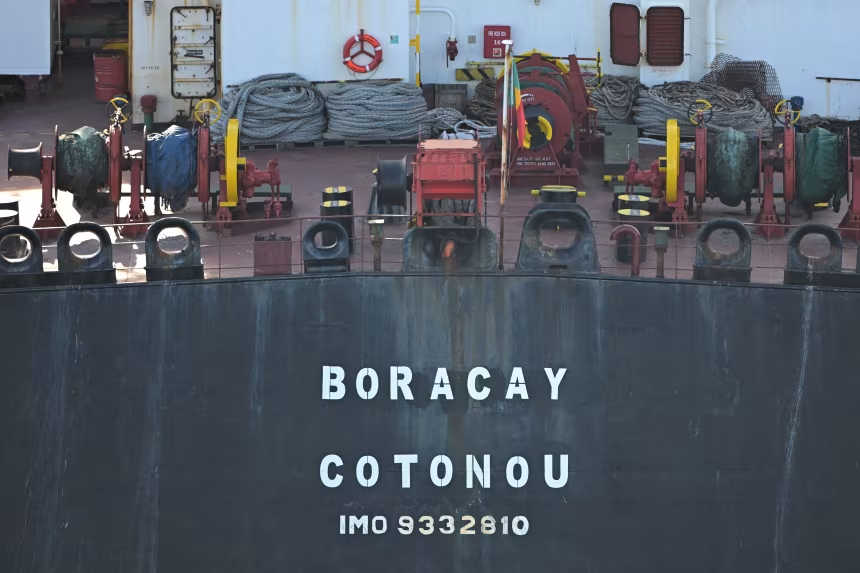
This aerial picture taken on October 1, 2025 shows the tanker Boracay from Russia's so-called "shadow fleet" suspected of being involved in drone flights over Denmark. Damien Meyer/AFP/Getty Images
Paris
(Reuters)
—
French police have arrested the captain and first officer of a sanctioned tanker suspected of operating for Russia’s “shadow fleet,” after the navy boarded the vessel, authorities said on Thursday.
“Thanks to our Navy commandos and to the crews of the French Navy who intervened this weekend on board a Russian shadow fleet tanker, currently anchored off Saint-Nazaire,” Prime Minister Sebastien Lecornu wrote on X.
“Their action contributed to the arrest of two members of its crew.”
Brest Prosecutor Stephane Kellenberger, whose office is handling the investigation into the Boracay, said in a statement the two people in custody had identified themselves as the ship’s captain and its first officer.
They are accused of failing to provide proof of the vessel’s nationality and failing to comply with orders, and their detention has been extended, he said.
Although President Emmanuel Macron has welcomed the probe into the vessel, estimating that Russia’s “shadow fleet” contains 600 to 1,000 ships, French authorities have been tight-lipped about the investigation.
The coast guard officers are now bringing the suspects to Korea.
It was approximately 50 nautical miles (90 km) south of Copenhagen, heading out of the Baltic Sea, when drone activity forced the closure of the city’s airport around 18:30 GMT on September 22, according to MarineTraffic’s data.
It was also observed traveling south along Denmark’s western coast on the evening of September 24, when drones were reported flying north of Esbjerg and near several nearby airports.
French and Danish authorities have declined to comment on whether the French probe is related to the drone incursions.
The Kremlin said on Wednesday it had no information about the vessel but added that the Russian military had to act sometimes to restore order when foreign countries had taken what spokesman Dmitry Peskov described as “provocative actions.”
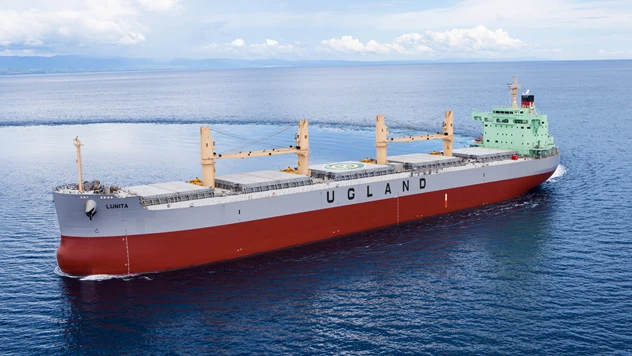 This aerial picture taken on October 1, 2025 shows the tanker Boracay from Russia's so-called "shadow fleet" suspected of being involved in drone flights over Denmark. Damien Meyer/AFP/Getty Images
This aerial picture taken on October 1, 2025 shows the tanker Boracay from Russia's so-called "shadow fleet" suspected of being involved in drone flights over Denmark. Damien Meyer/AFP/Getty Images
The J.J. Ugland Companies have now been informed that arrests have been made in relation with the drug seizure on board one of their vessels.
- It is with shock and sadness that we share the news that members of our crew have been arrested in connection with a recent drug seizure aboard one of our vessels. We are treating this matter with the utmost seriousness and gravity and remain fully committed to cooperating with the authorities as we await the further outcomes of their investigation, says CEO of the J.J. Ugland Companies, Øystein Beisland.
The arrests were made by South Korean police in connection with the company's ship M/V Lunita being taken into custody in the South Korean port city of Gangneung on 2 April. However, the scope of the case and details regarding the crew are not yet clear.
- The investigation is still ongoing, and we are kept up to date by our lawyers in South Korea, who have also assisted the crew during the police interrogations, concludes Øystein Beisland.
船員(英語ではratingsと呼ばれる船員)の給料が士官クラスの国の最低賃金よりも低い事は普通だ。人件費を下げるために外国人船員達を使うのは
商船では常識と思われるほど普通の事だ。食事も、部屋代も無料で、給料は自国で働く以上に貰えるから発展途上国の船員は働くのである。
発展途上国の船員だと、自国の労働賃金で働けば、外国の船主の船で働く場合と同じか、低い事が多い。だから外国の船主の船で発展途上国出身の船員が
働くのである。強制ではない。
漁船の世界はあまり知らない。しかし、一般商船の船員に漁船と商船とどちらで働きたいかと何度か質問した事がある。答えは、全て、商船である。
それでは、なぜ、漁船で働きたい、又は、働く船員がいるのかと聞くと、漁船で働く船員への資格や経験の要求が低いので、商船で雇ってもらえないが、
船員として働きたい船員が仕事を選ぶそうである。
一度だけだが、元日本の199総トン数の貨物船に乗っている韓国人船員が昔は漁船に乗っていたが、仕事がないから貨物船に乗っていると言っていた。
漁船に船員として乗っていたが、船員の免状は最低レベルなので中型や大型船には船長や一等航海士として働けないので、持っている免状で働ける
小型船しか選択肢はなかったと言っていた。
一度だけだが衝突事故の事故調査に関わった事がある。漁船の船員の多くが実際は働く資格を持っていないにもかかわらず、働いていた。
船の世界や漁船の世界はこんな世界である。グローバリゼーションと違反が横行する世界で競争しなければならない。日本のブラック企業など
まだ、レベルとしては良い方だ。責任感が強すぎて当事者が潰れて行ったように思える。転職や辞める選択は選べたと思う。
外航近海船や外航船の小型船で多国籍船員の場合、大型船と比べ物にならないほど労働環境はひどい。船が小さくなればなるほど、給料が安くなる。
日本も韓国もそうであるが、人件費が国際水準で見た場合低い時代であれば、船員になれば高給となる。しかし、経済が発展し、自国の最低賃金が
船員の給料よりもかなり上になると人件費が上昇し、競争力が失われる。同じような状況の国は、国の規則次第であるが、外国人船員を使用できなければ、
規則が緩和されている国に船の国籍を変えて、外国人を雇うようになる。同じような方法を取るか、我慢できるレベルまでは船員の給料を上げずに対応する
事も出来る。ただ、利益は減る事は避けられない。自国の領海のみを運航する船であれば、自国の法や規則で船員の給料は最低賃金以上となり、
外国の船との競争から守られるが、国際航路は自由競争なので人件費の高い先進国にとっては非常に不利で、船員にとっては魅力のない労働市場になる。
船員としての経験が長く、大型船のシニア士官(少なくとも一等航海士)の免状を持ってなく、船員以外の職を見つける事が出来なければ、小型の船に乗るしかない。
彼らが若い頃は同僚は同じ国籍で英語を話す必要もなく、英語は要求されなかったので英語が流暢ではない。船長であっても英語は下手な人は多い。
しかしながら人件費抑制のため外国人船員達と一緒に過ごさなくてはならない状況が普通となっている。小さな船でしか仕事がない船員(英語ではratingsと呼ばれる船員)は
が上手くはない。一応、国際条約のSTCW(船員の訓練および資格証明並びに当直の基準に関する国際条約)では最低限度の英語でのコミュニケーションが
資格を取る時に要求されているが、小型船には英語が話せなくても資格を持っている士官や船長も多くいる。だから部下の外国人船員に英語で説明できない、
的確な指示を出せない事も実際問題としてはあるのである。しかし、この件について業界(PSC(外国船舶監督官)や海上保安職員達)は大目に見てきたと思う。
業界に与えるインパクトも大きし、確実にコストアップとなる。
このように環境が悪くなりストレスが増える状況の船長や士官と英語又はその他の言語でコミュニケーションがうまく取れない部下の外国人船員のコンビネーション
で上手く行くのか?仕方がないと割り切るしかない。
コストを優先にして外国人船員を集めると、規則上、船員の免状は満足するが、実際に仕事が出来ない、又は、経験不足な船員が存在する。
日本では退職してかなり減ったが、外国人船員を同じレベルとして人間扱いしない船長や外国人船員を子供やペットのように起こる韓国人船長を見た事がある。
自分だったらこんな船では働きなくないと思うが、自分の問題ではないので、大変だなと思うだけである。
漁船は商船よりももっとひどいと聞くから殺したいと思う外国人船員がいても不思議ではない。漁船で台湾人船長によりインドネシア人船員が殴り殺されたケースがある(
Indonesian seafarer’s death highlights Taiwan interpreter shortage 01/24/17(The Jakarta Post))。
漁船関係でない多くの日本人、韓国人、そして台湾人はこのような問題は知らないであろう。良心的な漁船の人達も存在するけれど、極端なケースではコストや利益を
優先させるひどい環境が存在する。一般的に漁船はPSC(外国船舶監督官)の検査対象ではない。
環境は商船の比ではないだろうと想像する。
養殖魚でない限り、このような環境の漁船から取られた魚を多くの人達が食べている。だがあまりNPOが動くとか、支援団体が問題に光を当てる事はあまりないと思う。
なぜかは知らない。
まあ、これらの問題は極端なグローバリゼーションとコスト競争の結果である。誰かが犠牲になるから、安く魚が買える場合がある。
クジラとか、イルカが犠牲になっていると大騒ぎするニュースは時々見るが、これらの問題はクジラやイルカ以下なのかと思う事がある。
だから、日本で貧困とか、格差社会とか言っても、レベルが違い過ぎて甘ったれと思う事もある。
日本ではこのような事は起きていないと思うかもしれない。少なくとも何回かは関連する問題を日本の公務員達が扱う事があった。
しかし、見て見ぬふりをしたと個人的には思っている。つまり、深く調査をせずに、簡単な報告書で終わらせた。
これが現実で、権力や権限のない人間にはどうしようも出来ない事だと感じた。格差や貧困が存在するからこそ、その恩恵を受ける者がいる。
格差や貧困はなるならないし、なくなれば困る人達がいる。国内だけで判断するのか、特定の地域、又は、世界規模で判断するかで
答えは違ってくると思う。日本は甘いと思う。その一方で、税金を無駄に使う。これで良いのかと疑問に思う。
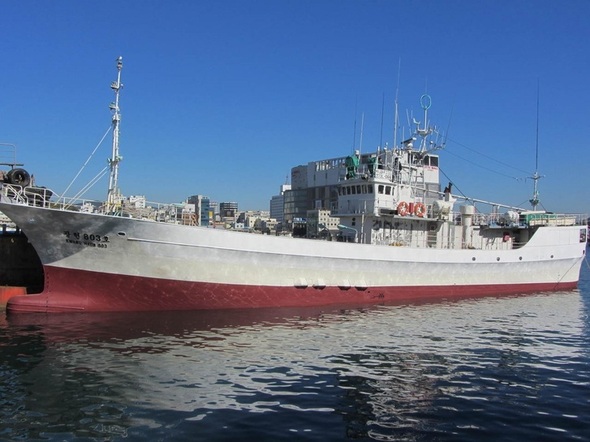
ベトナム船員が送出業者に払った保証金
4人家族の年間生活費に匹敵
事件になって下船すれば払い戻し不能
同じ仕事をしても最低賃金にも満たず
外国人船員の管理、韓国政府は傍観
先月インド洋で操業していたマグロ延縄遠洋漁船で発生したベトナム人船員による韓国人船長などの殺人事件は、言語の違いで発生した誤解と外国人船員に対する「自国に帰れ」という言葉から始まったという調査結果が出された。
釜山海洋警備安全署は4日、「クァンヒョン803号のベトナム人船員K(32)、N(32)が酒の席で行ったケンカに恨みを持ってヤン船長(43)とカン機関長(42)を凶器で刺し殺害した」と明らかにした。
ヤン船長は先月19日午後10時頃、会食の席を用意して船員たちと洋酒5本を一緒に飲んだ。酒に酔ったKとNがヤン船長に「ヨー」と言った。「ヨー」はベトナム語で乾杯を意味するが、ヤン船長は悪口だと誤解した。ヤン船長はK、Nが先月初めに船が入港した時に自身に報告せずに携帯電話を修理しに行った事実などの勤務態度を指摘して「そんなことをするなら自国に帰れ」と言い、Kはヤン船長の喉首を掴んで小競り合いをした。
さらにヤン船長が操舵室で船内放送によりベトナム人船員7人を呼び集めると、KとNが船長と機関長を凶器で刺し死亡させ、後にこの事実を知ったイ航海士(50)が二人を制圧した。
なぜベトナム人船員は「自国に帰れ」という言葉を聞いて極端行動に走ったのだろうか。
外国の民間送出業者は自国で船員を募集し、韓国の民間受入業者を通じて遠洋船社に船員を就職させ、操業現場に投じている。送出業者は船員から身元保証のために紹介費と担保を預かるが、船員が問題を起こした場合には担保を払い戻しされないケースが大部分という。KとNも300万ウォン(当事のレートで約32万円)を渡して昨年2月にクァンヒョン803号に乗船した。この金額はベトナムでは4人家族の年間生活費に当たるという。
今年基準で韓国船籍の遠洋漁船は220隻だが、そこでは韓国人船員1492人、外国人船員3374人が働いている。船会社のある関係者は「狭い船内で韓国人と外国人船員が一緒に生活するので、文化の違いによる軋轢とコミュニケーションの問題が発生する懸念が高いが、船員の統率は船長の裁量に任せられている」と話した。釜山地方海洋港湾庁の船員海事安全課関係者は「遠洋漁船に乗船した外国人船員は、船会社などが自主的に管理する。遠洋漁船の外国人船員を別途管理する機関や制度はないと承知している」と話した。
外国人船員の賃金差別問題も犯罪につながる可能性がある。海洋水産部が定めた今年の韓国船員の最低賃金は164万1000ウォン(約15万円)だ。外国人船員の最低賃金は船員法により船主協会と労組が団体協約を通じて決める。遠洋船会社が設立した韓国遠洋産業協会は、今年基準で36カ月以上の経歴の外国人船員について月平均最低賃金を614ドル(約6万2千円)、それ未満の外国人船員は457ドル(約4万7千円)と決めた。船社ごとに給与は異なるが、遠洋漁船の外国人船員の月間給与は100万ウォン前後(約9万円)だという。
労働時間に制限がなく、時間外手当が認められない遠洋漁船の特性上、韓国人船員は漁獲量に応じて成果給として支給される歩合制(生産手当)の適用を受けるが、外国人船員には最低賃金水準の月給しか支払われない。韓国人船員と一緒に仕事をする外国人船員が不満を抱くことになる構造がある。
釜山/キム・ヨンドン記者 (お問い合わせ japan@hani.co.kr )
韓国語原文入力:2016-07-04 19:19
http://www.hani.co.kr/arti/society/area/750849.html 訳J.S(1660字)
広い海で長期間操業する遠洋漁船の劣悪な環境と非人格的な扱いなどがまた船上惨事を呼んだ。
先月19日、インド洋のセーシェル群島北側640マイルの海上、マグロ漁の遠洋漁船『クァンヒョン803号(138t)』でベトナム船員B氏(32)、V氏(32)が船長と機関長を凶器で残忍に殺害した。
B氏らは普段仕事が下手で作業速度が遅いという理由で船長と機関長から頻繁に暴言を言われて虐待にあったことに恨みを抱き、酒を飲んだ後、操舵室と寝室に訪ねて行って犯行を犯したと見られると海上警察は1日、明らかにした。
遠洋業界では1996年8月にサモア島付近の海上で発生したマグロ漁遠洋漁船『ペスカマ15号(254t)』事件以来、20年が過ぎたが、船上では相変らず暴言など外国人船員に対する上級船員の非人格的な待遇が絶えることなく続いていると指摘した。
ペスカマ号事件は劣悪な作業条件と強制下船に反発した中国僑胞(海外在住韓国人)船員6人が、韓国人船員7人を含む船員11人を無惨に殺害して死体の一部は海に捨て、外国人船員4人を冷凍倉庫に閉じ込めて凍死させた衝撃的な事件だった。
以後、政府は事故再発を防ぐため外国人船員の福祉水準と教育強化、固定給の他に成果給の支給などの総合対策を出したが、遠洋漁船の劣悪な環境は相変わらずだ。
きつくて苦しい遠洋漁船の操業過程で少しでもよそ見をすれば安全事故の危険が大きく、悪口と暴言が行き交う場合が多い。
船長など上級船員は外国人船員とコミュニケーションが自由でない状態で操業実績に追われながら緊急の場合には悪口が先に飛び出すのが現実だ。
外国人船員が我が国の言葉は分からないが悪口はよく分かるという自嘲混ざった話が出る理由だ。
遠洋漁船内に並んでいる漁具はいつでも凶器に変わりかねず、ささいな言い争いや暴言、悪口はややもすると船上犯罪につながりうる時限爆弾であるわけだ。
去る3年6か月間、外国人船員によって発生した船上犯罪は67件に達した。
犯罪類型別には傷害と暴行が21件で最も多く、殺人(11件)、その他(10件)、致傷(4件)の順だった。死傷者は死亡11人を含む57人だった。
昨年4月にはアフリカ,ギニア国の沿岸で操業中の釜山船籍の遠洋トロール漁船A号(491t)の食堂で、言い争いが原因になってインドネシア船員Y氏(33)が機関長イ某氏(51)を凶器で刺して死亡させたこともあった。
私たちの遠洋漁業は20~30年前、韓国船員が日本の遠洋漁船に乗って学んだことが基本になった。
当時、日本の遠洋漁船に乗った韓国船員は苦しく働きながら日本人船長などから悪口と共に非人間的な扱いを受けたという。
そのように成長した私たちの遠洋漁業は、もう国内船員が乗船を避けながら外国人船員に受け継がれている。
釜山のある遠洋船会社関係者は「孤立した空間である遠洋漁船内で上級船員と下級船員との葛藤は葛藤は起きざるを得ない」とし「だが、それを適時に解くことができなければ船上殺人のような凶悪事件が発生しかねない」と話した。(機械翻訳 若干修正)

Korea Coast Guard officers have taken into custody two Vietnamese crewmen who allegedly killed the Korean captain and chief engineer of a fishing boat.
The detention was made at Port of Victoria in Seychelles, in the Indian Ocean, Thursday night, as the Korean vessel arrived there four days after the alleged killings.
The coast guard officers are now bringing the suspects to Korea.
According to the coast guard, seven of its officers boarded the vessel, Kwang Hyun 803, with local police when a pilot was boarding around 10:10 p.m. local time. The coast guard gained control of the ship and had the vessel steered to the pier.
The surprise boarding was aimed at preventing the suspects from attempting to escape, the coast guard said, adding that all other crew members were safe.
The two Vietnamese sailors did not resist when officers detained them, the coast guard said.
Four of the officers left the island country with the suspects, taking them to Korea on planes via United Arab Emirates. They are expected to arrive at Incheon International Airport on Saturday afternoon and be taken to the coast guard's investigation base in Busan.
"We concluded it would be better to bring them to Korea as soon as possible and investigate them here than to confine them in a cabin and question them there," a coast guard official said.
The other three officers checked the health of the crew and have been questioning them about the circumstances of the incident.
A Korean navigator, surnamed Lee, earlier told the coast guard that the Vietnamese sailors stabbed the captain and the chief engineer after the crew had shared two bottles of liquor provided by the captain as a present for their hard work. The officers are examining how the drinking session took place and whether the alleged murderers had an accomplice.
Lee was sent to a local hospital because he sustained a minor injury while disarming the assailants.
The coast guard officers also conducted postmortem examinations on the victims and examined the crime scene on the vessel. The vessel operator, Kwangdong Shipping, will bring the bodies back to Korea soon.
The incident happened early Monday when the two Vietnamese crewmen, both 32, allegedly stabbed the captain, Yang, 43, and the engineer, Kang, 42.
Lee said the alleged assailants were usually hardworking and obedient, and the coast guard suspects the killings were impulsive.
Since the incident, Lee, the only remaining Korean of the 18-member crew, has been the acting captain and led the vessel to the Port of Victoria, 640 miles from where the incident occurred. Eight Indonesians and seven Vietnamese made up the rest of the crew.
(Seychelles News Agency) - Investigators from South Korea are in Seychelles probing the deaths of the captain and chief engineer of a South Korean fishing vessel, the island nation’s police said Friday.
The deep-sea fishing boat arrived in Port Victoria at around 11 p.m. on Thursday carrying the bodies of the two men and a 16-member crew of Vietnamese, Indonesian and South Korean nationals.
“Investigations into the killings on board South Korean fishing Vessel Kwang Hyun 803 is being carried out by South Korean authority [and] facilitated to a certain extent by the local partners,” the police spokesperson Jean Toussaint said in a statement.
“While formalities are being done to repatriate the body of the Korean Captain and his chief engineer, the investigation team has arrested two Vietnamese, suspected to have murdered them,” Toussaint added.
According to the KBS World, a South Korean online news service, a seven-member special investigative team of the South Korean Coast Guard is currently in the 115-island archipelago in the western Indian Ocean.
“According to South Korea's Coast Guard, the two suspects did not resist arrest and cooperated with investigators. All the remaining crew members were also known to be safe,” KBS World said.
According to the report the two accused are incarcerated on board the ship, which is under the surveillance of the Seychelles police.
The two Vietnamese men are said to have been intoxicated when they committed the crime reported by an Indonesian crew member – although the motive of the killings are unknown, reported KBS.
The Seychelles police said initial investigations have established that the vessel was not in the Seychelles’ territorial waters at the time of the killing incidents.
“Kwang Hyun 803’s last port of call was Victoria on the 21st of May 2016 and the incident is reported to have happened on the 19th of June,” concludes the police statement.
20日午前2時ごろ、インド洋セーシェル付近の海上を運航していた釜山広東海運所属の「クァンヒョン803号」で、30代のベトナム人船員2人が韓国人のヤン船長(43)とカン機関長(42)を刃物で刺して殺害した。
酒に酔っていたというベトナム人船員2人は現在、他の船員らに取り押さえられ、船の中で隔離されているという。漁船には船長や機関長など韓国人船員3人、ベトナム人船員7人、インドネシア船員8人が乗っていたという。釜山海洋警備安全処は捜査本部を設置し、現地に捜査チームを派遣する方針だ。
この報道に、韓国のネットユーザーはさまざまなコメントを寄せた。
「現在の船内の雰囲気はどうなっている?恐怖や不安でいっぱいだろう。これ以上何も起こらなければいいが…」
「船員の半数以上を韓国人にしなければならない。戦争や危機的状況が発生した時、船舶を奪われてしまう可能性がある」
「国外で殺害される韓国人が多いのはなぜ?韓国人は世界中からなめられる民族になってしまった…」
「ベトナム人は愛国心が強く、プライドが高いから、自分たちより豊かな国に住む人に対する劣等感も強い。ベトナム人と接する時には注意が必要だ」
「韓国人は『恩恵は必ず返す』と言うが、ベトナム人は『恨みは必ず返す』と言う。ベトナムには復讐文化がある」
「外国人労働者を受け入れ過ぎた結果。船に1人残された韓国人船員が心配だ」
「殺されたのには何か理由があったはず。そんなに外国人船員らを苦しめていたのか?」
「船長らが安い給料で過酷な労働を強いて、日頃から暴言を吐いていたに違いない」(翻訳・編集/堂本)
.1 船舶を指揮するための適切な資格を有すること
.2 会社の安全管理システムに十分精通していること
.3 職務を支障なく遂行できるように必要な支援を受けられること
船長は、適法で有効な海技免許を有していない乗組員を職員として船
橋当直につかせてはならない。
・・・
今後必要とされる事故防止策
船長及び船橋当直者は、次の事項について徹底する必要がある。
(1) 船橋当直者は、船首方に船舶を認めた際、方位変化の観察、レーダープロッティング等を行うなど、見張りを適切に行うこと。
(2) 船長は、適法で有効な海技免許を有する職員を船橋当直につかせて適切な船橋当直体制を維持すること。
(3) 船橋当直者は、船舶と接近し、相手船の動作に疑問をもったときは、直ちに警告信号を行うとともに適切な時機に衝突を避ける動作をとること。
運輸安全委広報室の高橋守室長は上記等を確認した上で調査報告書を公表したのだろうか?
運輸安全委員会が不適切な調査報告書を公表する事はないか?個人的には疑問であるが!
報告書によると、事故は25年9月27日未明、伊豆大島西方沖で発生。南西方向に進んでいたジィア・フイは、栄福丸とほぼ正面で向き合った後、海上衝突予防法の規定とは逆の左に向けてかじを切り衝突。一方、栄福丸は同法の規定通り右にかじを切ってわずかに方向転換して航行していた。
衝突で船首が栄福丸の左舷中央部に刺さったジィア・フイは、危険を感じた中国人船長の指示で後進し、離脱。船体に開いた穴(幅約3・5メートル、高さ約5・5メートル)から浸水した栄福丸は約3分40秒後に転覆したとみられ、船長の大川信悟さん=当時(62)=ら6人が死亡した。
安全委は、ジィア・フイが離脱せずに船首を押しつけた状態を保っていれば栄福丸の急激な浸水を防ぎ、約10分経過後でも「姿勢が大きく変化したとは考えられない」と指摘した上で、「転覆するまでに時間的余裕があれば、(栄福丸の)乗組員は船外に脱出できた可能性がある」とした。
また、事故当時、ジィア・フイを操船していた当直責任者の中国人男性(37)は、中国近海を航行する免許しか持っておらず、中国の運航会社との連絡や物品購入を担当する「実習生」として乗り組んでいたことも明らかにした。
静岡地裁沼津支部は昨年3月、業務上過失致死罪などで、当直責任者の中国人男性に禁錮3年を言い渡し、その後確定した。
“It is difficult to leave this place ... I’m often insulted by the captain, too. Here is a victim of violence on this ship,” Indonesian seafarer Mualip said in his recorded video of fellow seafarer Supriyanto, who is shown sitting dazed on deck of a ship that left Pingtung’s Dong Gang harbour in May.
In his narration, Mualip describes Supriyanto as having been beaten by crew members of the ship before recording the video. Supriyanto was sporting swelling and bruising on his face. “Thank you, Supriyanto. I hope you will recover soon,” Mualip said.
It would be one of the last visages of Supriyanto. In another video, he was shown at the brink of death in late August.
With the 580,000 foreign blue-collar workers living in Taiwan (as of 2015, the Interior Ministry’s figures showed there were approximately 630,000 foreigners in total) and a vast number of foreign spouses, with those coming from Southeast Asia making up almost 90 per cent (149,213 out of 165,902), one would assume that Taiwan would have already set up a comprehensive system in place to address the needs of a vast population.
A recent probe into the case of Supriyanto's death suggests otherwise.
In November 2015, the Pingtung District Prosecutors’ Office deemed the death of Supriyanto, who died onboard a fishing vessel in August, an accident. Prosecutors found that he died from illness caused by an untreated knee wound after falling from an elevated point on the ship while hanging clothes.
However, the prosecutors office did not completely close the case. Prompted by petitions from non-government organisations upholding seafarers’ rights, who found details of the case and Supriyanto’s death suspicious, the Control Yuan ombudsman Wang Mei-yu relaunched investigations into the case last December.
Misinterpretation or lack of interpretation?
Wang found critical evidence in the case -- three videos of Supriyanto recorded by Mualip --- to be controversial. After bringing in an interpreter who was familiar with Supriyanto’s language, an obscure Javanese dialect, the Control Yuan revealed that his statement in the video vastly differed from the translation recorded by the prosecutors’ office.
A factor neglected by prosecutors was misinterpretation of the videos: the two interpreters brought in by the prosecutors’ office in charge of the court translation did not understand Supriyanto and Mualip’s language and could not translate vital parts of the former’s statement, revealing that he had been beaten by crew members as well as the Taiwanese captain.
The Control Yuan’s probe concluded that the captain’s negligence in providing medical assistance to treat Supriyanto’s wounds had resulted in his death; as well as government negligence from the Executive Yuan’s Council of Agriculture and the Fisheries Agency to oversee foreign seafarers’ working rights and working environment.
The Pingtung Prosecutors’ Office, prompted by Wang’s report, has relaunched a probe into Supriyanto’s case.
The nuances of language
Supriyanto’s death refocused attention upon the poor working conditions of foreign seafarers, who are not fully protected under Taiwan’s labour laws. However, his case also turned attention to an overlooked factor, equally important to bringing about more equal treatment in court for blue-collar foreign workers or foreign spouses in Taiwan: language.
Prompted by Supriyanto’s case, a January 10 public hearing was held to discuss Taiwan’s community interpretation problems. It urged the government to consider directing more investment toward community interpretation talent training and certification in order to uphold constitutional rights for Taiwanese and foreign workers.
“I once saw a case that unfolded like this: a Filipino seafarer spoke in a long-winding sentence in his local dialect, however the interpreter, translating through a video conference, only said two sentences,” Lennon Wong, Serve the People Association Service Center and Shelter for Migrant Workers, told The China Post.
“That’s a definite misinterpretation of the truth.”
He added that foreign workers or spouses seeking medical treatment often ran into similar problems when their English or Chinese proficiency was not sufficient to accurately describe their symptoms.
Awakening Foundation, a women’s advocacy group, legal department director Chin Chi-fang said during the public hearing that addressing language barriers were often the pivotal point for foreign workers to receive their due at court.
“The impression among foreigners in Taiwan is that they don’t get their due diligence in Taiwanese courts. Language is one issue, but there is also prejudice,” interpreter Priya Lalwani Purswaney told the China Post, saying that foreigners try not to get into trouble here, but if they do, they try to get their cases heard elsewhere.
“Foreigners should be able to understand what’s going on” regarding the Taiwanese court system and constitution, and translation should be provided, but that is not always the case, she said.
Compiling the resources
A unanimous consensus among NGO’s and lawmakers was the urgent need to address the talent gap in Taiwan, despite government agencies’ ongoing efforts to train interpreters and hosting talent banks.
The government set up an interpreter talent bank back in 2009 which provided legal interpretation services, Immigration Affairs Deputy Director Yin Yu-hua said.
The job bank currently boasts 1,431 interpreters and provides translation services for 18 different languages, ranging from Vietnamese, English, Indonesian and Thai, he said.
However, Yu conceded that while the number of interpreters was sufficient, specific and lesser-known languages or dialects were much harder to find, citing a smaller talent pool and demand.
He also addressed the quality discrepancy of interpretation since government training did not adhere to any sort of certification, and citied lack of legal regulations and insufficient budget. Yu promised to direct efforts and training to increase quality.
In spite of the government’s confidence in providing adequate quantity interpreters, TransAsia Sisters Association, Taiwan (TASAT) executive secretary general Hsieh Shih-hsuan said otherwise, citing unequal resource distribution nationwide.
A case in Hualien County involved an interpreter who could not understand a local Indonesian dialect, Hsieh said. “You can’t say that (the government) has a sufficient number of Indonesian speakers, but should, consider whether there are enough resources to provide services for dialects of the language, and whether local agencies could obtain such resources in time.”
In the association’s view, “the government hasn’t achieved that,” Hsieh offered. In the end, the prosecutors or lawyers managed to reach out to them, and they provided a suitable interpreter.
“There are so many new immigrants and legal interpreters in eastern Taiwan, yet (we) couldn’t find suitable resources, and we still had to look back to the capital for assistance,” Hsieh said, calling out on the gaps in talent distribution and training.
Democratic Progressive Party lawmakers Yu Mei-nu and Tsai Pei-hui agree that the government should lead efforts to take stock of existing resources, specifically interpreters and second-generation offspring of new immigrants from Southeast Asia, who cpuld become Taiwan’s critical talent pool to draw from.
Speaking to The China Post in a joint interview with Yu, Tsai said on top of coming up some sort of certification programme to ensure interpretation quality, creating an usable platform to aggregate talent must be considered.
She suggested that the government could set up regional centers to provide professional interpretation around Taiwan: for example, centres overseeing services in eastern, central, northern or southern Taiwan, which would help relieve the burden from interpreters who might have to travel long-distances from their homes to work on cases in far-flung parts of the country.
Yu said that criteria and compilation of data should be considered, ranging taking stock of interpreters who could provide services for certain languages, the ratio of foreign spouses, country of origin, the number of second generation offspring who could leverage their bilingualism.
After the public hearing, both Yu and Tsai asked the Executive Yuan to consider assigning a minister without portfolio to oversee such undertakings, which they believe would require cooperation between multiple government agencies.
“There should be a schedule in place; like what we should do in two years, or a monthly agenda,” Tsai said, in order to push the administration to carry out related work.
Improving interpreters’ conditions
However, both Hsieh, Purswaney and lawmakers echo similar sentiments that working conditions for interpreters must be addressed as well, specifically low pay, in order to motivate talents in the industry.
Hsieh proposed at the public hearing that a “special law” should be drawn up to guarantee interpreters’ working pay and environment.
Lawmaker Tsai pointed out that a price floor should be drawn up to ensure that interpreters of southeast asian languages can receive “adequate and reasonable” pay, who cited numbers mentioned at the public hearing of only a few hundred New Taiwan dollars per hour, compared to higher wages for English interpretation.
A joint effort
A silver lining in Supriyanto’s case was government attention from not only Taiwan, but also in his home country, Indonesia.
Control Yuan’s Wang, before the interview wrapped up, brought up that when accompanying with Control Yuan President Chang Po-ya’s delegation to Indonesia, they received a positive feedback from Indonesian government’s BNP2TKI, which oversees safety and protection for Indonesian workers abroad, when they expressed concern about cracking down on local illegal employment agencies that exploit migrant workers.
Efforts to prevent illegal employment agencies in Indonesia and Taiwan should be carried out to ensure protection and basic human rights for foreign workers, Wang said, pointing out that joint efforts should be made.
韓国客船 Sewolの沈没事故のように過載であっても指摘しない韓国国土交通省を考えると、内航船である以上、どのような規則を適用させるのかはその国又はその国の国土交通省次第である。韓国のように業界寄りのスタンスであれば、利益追及も許される。あと、天下りの指摘をするべきでしょう。国土交通省の承認がないだけで、品質はほとんど変わりないのに、内航船には使えない製品が多すぎる。国土交通省の天下りを受け入れることによりメーカーは製品の型式承認を取りやすくなるようです。外国製品だと外国の検査会社に承認されていても品質がひどいものがあるが、同じメーカーの同じ製品でも外国で買う方が圧倒的に安い。何が違うのか、日本籍船で使えるのかどうかだけである。サブ・スタンダード船の検査の場合、スクラップになった船に搭載されたイマーションスーツを安く買って、検査に通す事も出来る。日本船籍船では無理。再整備したり、補償を付けたりすると、新品の方が良いとなる。
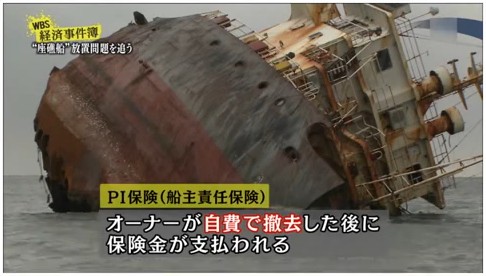
”座礁船”放置問題を追う 2015 02 11(Youtube)
ワールドビジネスサテライト,2/11,WBS経済事件簿,"座礁船"誰が撤去する?
A spokesperson for the ITF said one crewmember aboard the Korean bulk carrier, the C. SUMMIT, was diagnosed by a doctor as suffering from malnutrition. Four members of the crew fled the ship in Mackay, claiming they feared for their lives. ITF Assistant National Coordinator Matt Purcell said the men, all of whom were from Cambodia or Burma, had been victims of “the worst kind of bullying” he had ever encountered in his work as an inspector.
“The crewmembers claim they have received no wages for several months,” he said. “They have been locked in hatches and have survived on what I can only describe as a starvation diet.” Purcell said two contracts were found by inspectors, one signed by the workers before boarding and the other, “which doesn’t meet even the most basic international standards,” signed shortly after joining the ship.
The C. SUMMIT is owned by South Korea-based Chang Myung Shipping Co. The ITF said its many deficiencies had been repeatedly noted by inspectors in a number of different port state control areas.
ITF President Paddy Crumlin said although the ship was an extreme example, many ships calling at Australian ports have poor records on safety, pollution and crew welfare. “The sea is a largely unregulated environment in which greedy shipowners and operators are allowed to get away with egregious breaches of human rights, and the Australian government is regularly turning a blind eye to the breaches happening in our waters,” Crumlin said. The country’s prime minister, he added, “seems to want these awful breaches to increase by wiping out the Australian merchant navy fleet through complete deregulation.”
The country’s Conservative government is attempting to dismantle the Coastal Trading Act, which stipulates that ships trading between Australian ports must be crewed by Australian workers or else paid comparable wages.
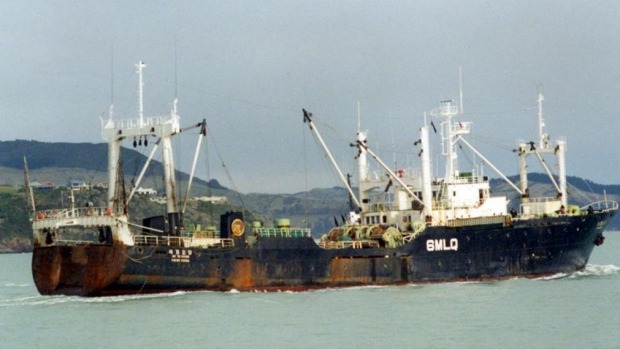
OYANG 70: Pictured in June 2006, it sank in the Southern Ocean more than 200 nautical miles off Dunedin.
Sajo Industries' 36-year-old trawler Oryong 501 sank on Monday while fishing for Alaska Pollock which, with New Zealand hoki, is the main fish used worldwide in McDonald's Filet-O-Fish.
Sajo also owned the 38-year-old Oyang 70, which sank in New Zealand's exclusive economic zone in August 2010 while hauling in a big bag of southern blue whiting, killing six men.
Sajo has been convicted in New Zealand courts over the boats Oyang 75 and 77 for the abuse of environmental, fishing and labour laws, and both boats have been ordered forfeited to the Crown.
South Korean media today highlighted Sajo's role in New Zealand and the allegations of appalling labour abuses aboard the foreign charter fishing vessels that were used to take Maori Waitangi Treaty quota.
The Korea Times says families of the men from the 1753 ton Oryong 501 believe the sinking was a man-made disaster caused by reckless fishing in bad weather.
They said Sajo pushed ahead with fishing despite high waves and strong winds.
"It seems the vessel tried fishing in bad weather conditions with high winds and waves four metres high," Kim Cheon-sik, a family member of one of the missing fishermen, told the Korea Herald.
Ships should return to port in such conditions, he said.
Sajo director Lim Chae-ok said it was the captain's decision.
"People at the head office in Seoul cannot know weather conditions at sea, so the captain usually decides."
Oryong 501 sank at around 2.20pm local time on Monday, with 60 seamen onboard. Eight people were rescued but one of them, a Korean, later died of hypothermia, while 52 others are still missing, according to the Korean Ministry of Oceans and Fisheries.
There is little hope now in appalling winter conditions that the missing men will be rescued. Four empty lifeboats have been recovered.
Like the ships used in New Zealand, Oryong was mainly crewed by low wage Asian men.
There were 35 Indonesians, 13 Filipinos, 11 South Koreans and one Russian inspector.
The Korea Herald said families believe it took four hours from the ship's first listing to its eventual sinking, but the company failed to order the crewmembers to evacuate and prepare for rescue measures at a proper time.
One family member claimed that when he talked to one of the missing sailors over the phone before the accident, he said that the company had ordered them to do additional fishing, although they already had the assigned amount of catch.
Lim Chae-ok denied the ship had an excessive amount of fish.
"Due to bad weather, we suspect too much water came into a fish container and the container became waterlogged."
His claims are strikingly similar to those made around Oyang 70 after it sank off the Bounty Islands, east of Otago.
It pulled in a large catch of whiting in calm seas but its captain, who went down with the ship, lost control of it and water flooded the fish factory and engine room.
The sinking of Oyang 70 had little impact in Korea at the time, but the new disaster comes less than eight months after the sinking of the Sewol ferry off South Korea's south-western coast in April left more than 300 passengers dead, mostly teenagers on a school trip.
Oyang 75, which was bought in to New Zealand to replace Oyang 70, has been ordered forfeited over fishing and environmental violations. It is currently under bond in the Indian Ocean and is likely to be auctioned in New Zealand.
Oyang 77, convicted for misreporting its catch and fish dumping, is also to be forfeited. It is currently squid fishing near the Falkland Islands in the South Atlantic. It has been renamed by the Koreans to Jille.
- Stuff
NZ Govt is currently investigating a number of Korean charter fishing boats over allegations of poor and slave like working conditions, little or no pay, abuse of crew etc.
__________________________________
Additional information about this ship and others from the The Christchurch Press 12.March.2012
A Korean fishing boat is under High Court arrest over claims its owners owe $2.335 million in unpaid wages over two years.
Agents for 36-year-old foreign charter vessel (FCV) Oyang 77 tried before dawn on March 3 to get its crew on a Singapore Airlines plane from Christchurch but Ministry of Fisheries enforcement officers intercepted them.
Six agreed to help in official "investigations into whether the Oyang 77 has breached fisheries regulations" and have been kept in hiding in Christchurch.
Industry sources told the Sunday Star-Times that conditions are so appalling on Oyang 77 that six Korean officers tried to leave. Oyang fishes iwi quota in a charter operated by Southern Storm Ltd, a shell company for Korea's Sajo Oyang Corporation.
On March 1 a ministerial inquiry warned Korean FCVs mistreated crews and damaged New Zealand's international reputation. It made a series of recommendations for tighter control.
Oyang 77, one of 13 Korean-flagged ships out of a 21-strong FCV fleet, has become the cause celebre for campaigners fighting the slave-like conditions aboard the boats first exposed a year ago by the Star-Times. Last month it was refused a licence to fish here.
Already held under a High Court warrant over $160,000 in damages to Talley's Fisheries, Oyang 77 moved on March 3 to get its crew out. Tauranga lawyer Craig Tuck, founder of Slave Free Seas group, says Southern Storm threatened the crews and said if they did not go they would not get bonuses of around $4000.
They were told agents in Indonesia would make their lives even harder. "It was very threatening and the men felt very intimidated," he said.
On Monday, Tuck, acting for 26 crewmen, obtained a High Court arrest warrant over Oyang for the unpaid wages. Southern Storm, in a press release, denied any wages were owed.
While New Zealand authorities have been indifferent in the past to the plight of FCV crews and unwilling to enforce a code of conduct, that changed last week.
After the fishermen cleared Customs and were heading to the departure gate, Fisheries enforcement reached them. Men were asked to stay back to help with investigations against the owners of the Oyang 77. Allegations include illegal dumping and high grading of fish in the exclusive economic zone, as well as trucking, which means quota is illegally moved from one area to another.
"A small number of Oyang 77 crew members have chosen to stay in New Zealand and are assisting with these investigations," Fisheries deputy director-general Scott Gallacher said.
Oyang 77 is a sister ship to Oyang 70 which sank off Otago two years ago killing six, and of Oyang 75, whose crew walked off in Lyttelton in protest at inhumane conditions aboard.
Another FCV, Mellila 201, which is owned by Taejin Fishieries of Korea, and chartered by United Fisheries in Christchurch, remains under arrest at the insistence of the crew, with claims of $1.8m owed in salaries.
By Ko Na-mu, Hankyoreh 21 staff writer in Jakarta
The New Zealand Department of Labor prohibited the South Korean deep-sea fishing vessel ShinJi from hiring foreign crews on March 5, citing its refusal to participate in a government survey on labor conditions. The country’s Department of Agriculture and Forestry also stripped a boat of its work permit in February, charging it with violating vessel safety standards. The ShinJi is part of a troubling trend of delinquent South Korean vessels who violate standards abroad and aren’t being punished at home.
A New Zealand government report stated that numerous allegations and reports had been made about low wages and abusive treatment of foreign crews, and that all of the complaints lodged with the inspection team had been against one country.
A controversy has been brewing overseas over that “one country,” while its own government has been asleep at the wheel.
Hankyoreh 21 obtained a New Zealand government report from February titled “Report of the Ministerial Inquiry into the Use and Operation of Foreign Charter Vessels (FCVS)”. The report makes strongly worded criticisms about abuses against foreign crewmembers and unreasonable employment conditions on the Sajo Oyang boats fishing in New Zealand’s exclusive economic zone.
Sajo Oyang is South Korea’s biggest fishing company and is at the center of accusations by the New Zealand government of South Korean vessels violating fishery management standards, vessel safety, employment and labor conditions, and abusing workers. One South Korean boat was stripped of its fishing permit in February, a first since South Korean vessels began fishing in the country’s waters. The situation could be damaging to international standings of both South Korea and New Zealand.
Documented mistreatment
Of particular note is the report’s mention of foreign crew labor conditions and abuses in connection with a National Human Rights Commission of Korea (NHRCK) petition.
Some in New Zealand were dismayed with their own government’s failure to regulate its waters and to allow such abuses to go on. In a section of Chapter 2 on “Damage to New Zealand’s international reputation,” the government stated, “During 2011 there were complaints and allegations about such issues as vessel safety, [foreign crews’] living and working conditions, physical and sexual abuse by officers, underpayment and manipulation of time sheets. . . There is no doubt that these allegations of exploitative labor practices and sub-standard working conditions have been damaging to New Zealand’s reputation as a progressive and fair-minded nation.”
The report went on to note, “Most of the incidents reported that are causing damage to New Zealand’s reputation appear to have occurred on Korean flagged vessels. The names of certain Korean vessels and owners came up repeatedly. The alleged abuse occurred mostly against Indonesian crews.”
The allegations also came from New Zealand fishermen. Many of the country’s vessel owners and fishermen reportedly told the team that they believed the practices of South Korean officers amounted to exploitation.
While noting allegations about the behavior of South Korean operators, the report states, “The Panel received no complaints about the mistreatment of crew on vessels currently flagged to the Ukraine, Dominica or Japan.”
It was South Korean deep-sea fishing boats that triggered the investigation in the first place. In 2010, the Oyang 70 capsized, taking the lives of six crews, some of them Indonesian. One of the problems mentioned was a lack of proper safety equipment.
In 2011, an entire crew of 32 Indonesian sailors fled the Oyang 75 over sexual harassment and abusive treatment. The situation became a cause celebre in New Zealand. Many local news outlets began devoting major attention to allegations of abuse on South Korean boats. The University of Auckland Business School was first to draft a report, determining that many of the allegations of abuse and low wages were verifiable.
New Zealand’s Department of Agriculture and Forestry and the Department of Labor then set up a joint investigation panel for a study that took place between Aug. 2011 and Feb. 2012. Written questionnaires were sent to industry representatives, including local and foreign ship owners, manning agents, vessel operators, and crewmembers. Thirty-two people participated in face-to-face interviews. The panel and representatives from the University of Auckland Business School’s New Zealand Asia Institute (NZAI) traveled to Indonesia in 2011 and 2012 to interview most of the Indonesian sailors from the Oyang 75.
At the front of its report, the New Zealand government states, “This publication represents the collective view of the Ministerial Inquiry into Foreign Charter Vessels,” though it adds the proviso that it “is not government policy.”
Shocking findings emerged in the November 2011 report from the NZAI, which were previously presented by some South Korean news outlets, including a January 2012 article in the Korean version of Le Monde Diplomatique on “Overfishing and Abuses: The Competitiveness of South Korean Tuna Boats.” They included substantiation of the credibility of claims by Indonesian crews about a South Korean officer embracing and attempting to kiss foreign sailors and fondling their genitals. The University of Auckland research team interviewed a total of 144 people, including Indonesian crewmembers from the Oyang 70 and Oyang 75. The report also said the human rights commissions of New Zealand and the Association of Southeast Asian Nations (ASEAN) had discussed the issue with the NHRCK.
Sexual crimes
The NHRCK’s discrimination remediation committee ruled on Apr. 18 to dismiss a petition submitted by the Korean House for International Solidarity (KHIS) and Advocates for Public Interest Law on behalf of six Indonesian crew members from the Oyang 75, contending that they had experienced sexual harassment and other abuses. The commission did not announce its decision publicly.
Questioning of members and associates of the NHRCK standing committee found that the commission did acknowledge a “possibility” that the subject of the complaint, an individual surnamed Gang who was boatswain on the Oyang 75, did fondle the genitals of six Indonesian crew members or rub his own genitals against them.
“Given the presence of common allegations among the victims, who all pointed to Mr. Gang as the perpetrator and claimed that Mr. Gang either thrust his genitals at them or rubbed them against the victims’ bodies, embraced the victims, and chased Indonesian crew members while they were showering, it is impossible to rule out the possibility of sexual harassment,” the NHRCK said.
The commission ultimately dismissed the case due to inconsistencies, arguing that the accounts of victims and witnesses did not add up. At the same time, in a kind of “compromise,” it advised that efforts be made to prevent sexual harassment of sailors on deep-sea fishing vessels and provide aid to victims.
The commission’s members are believed to have disagreed sharply during the decision process. “We’re current revising the decision,” an NHRCK representative said. “We’re not sure when the final one will come out.”
The NHRCK also confirmed allegations that a boatswain identified as Choe had engaged in physical and verbal abuse and that Sajo Oyang had drafted two different versions of the wage contracts for Indonesian crewmembers. However, it ruled to reject the verbal abuse and wage issues as outside the scope of its investigations.
Sajo Oyang management denied all charges. The alleged sexual harassment perpetrator identified as Gang reportedly told the NHRCK that there was “no truth to the claims of sexual behavior,” without giving specifics. Choi told the NHRCK, “I have done things like shout, lightly kick, gently slap someone’s head, or pull someone’s ear, but I have never engaged in serious physical abuse.” Sajo Oyang said, “Wages were all precisely calculated and paid,” without elaborating further. Sajo Oyang declined interview requests from Hankyoreh 21.
Another issue has been a lack of diligence. Among the factors cited by the NHRCK in dismissing the petitions was the “difficulty in obtaining testimony” from four major witnesses. The Hankyoreh 21 received a brief account of these witnesses’ current circumstances after inquiring with the human rights group ATKI Indonesia. One is currently a construction worker in Jakarta, while the other three are working on a Russian fishing boat. All four were interviewed by the New Zealand government. However, the NHRCK only conducted written surveys of the six petitioners. ATKI Indonesia member Iweng said, “The South Korean human rights commission doesn’t seem to be taking this case very seriously.”
University of Auckland Business School senior lecturer Christina Stringer, who spearheaded the investigation, said in e-mail to the Hankyoreh 21 that while she was unaware how many Indonesian crew members the NHRCK had interviewed, her team’s study uncovered evidence strongly indicating that a number of Indonesian fishermen were repeatedly sexually harassed and assaulted.
Stringer also said that a copy of the report had been provided at the request of the South Korean embassy in New Zealand, but that there had been no response.
South Korean government refuses to cooperate
Chapter 7 of the New Zealand government report includes a roundabout swipe at the lack of cooperation from the South Korean government, stating, “Information about a vessel’s risk profile is not generally shared among the relevant government agencies.”
According to international practice, the New Zealand government has no authority to investigate labor and human rights issues on foreign-flagged vessels as long as they do not involve fishery management standards. Legal responsibility lies with South Korea.
Between Aug. 2011 and March of this year, the Ministry for Food, Agriculture, Forestry and Fisheries, the Ministry of Foreign Affairs and Trade, the Ministry of Land, Transport and Maritime Affairs, and the NHRCK held a total of three joint meetings. While the agencies in question did have the South Korean fishing businesses under investigation attend, including Sajo Oyang, they made little effort to contact the Indonesian crewmembers. After three meetings, they have yet to take measures to improve the system.
The Hankyoreh 21 asked two of the six petitioners from the Oyang 75 whether they still harbor ill feelings toward South Koreans. One of them, named Trismanto, said, “Before, I thought all Koreans were bad. I changed my mind after meeting the KHIS members last year.”
The other, Sugito, said, “I forgive them now. And I’d like to keep working on fishing boats. But I first want a resolution to this case.”
Sugito’s goal is to bring the facts of the sexual harassment to light and receive all his wages. The two young men plan to visit South Korea some time around June at the request of KHIS. They will come to Korea as free men seeking justice, not as laborers working for meager wages.
※On the Investigation: Interviews took place in Jakarta on May 4. Trismanto and Sugito arrived at ATKI Indonesia’s offices in Jakarta after a seven-hour trip by train and bus from their hometown of Tegal. Iweng, a member of ATKI Indonesia, translated their responses from Indonesian to English. The two men were asked about the sexual harassment and wage exploitation allegations, as well as personal matters such as their families, hobbies, employment contract process, and their boarding and fleeing of the vessel. The New Zealand government report, University of Auckland report, KHIS petition text, and NHRCK ruling also served as major resources.
Please direct questions or comments to [english@hani.co.kr]
Korean registered ship the Oyang 70 sank 740 km off the Otago coast in August 2010 but only three of the six men's bodies were recovered.
The investigator heard today what survivors told police in the minutes before the Oyang 70 sank - that the trawler was overrun with thousands of fish, panic and fear.
“The chief engineer was crying. The chief engineer cut the net, nothing happened. Water started covering the deck so I jumped into the water.
“Men crying and begging...is taking frightened to the outside of its meaning...they were terrified...yes terrified.”
Up to 120 tonnes of fish had been partially hauled on board the Oyang 70, causing the ship to list and capsize.
One of the 45 survivors estimated there was three times the normal amount of fish in the net.
“It was the biggest haul of fish they'd ever seen, with many of them being experienced fishermen.”
Crew say the captain was more interested in saving the fish than the fishermen.
A number of factors could have contributed to the end result.
A larger than normal net was used because the usual, smaller net had been damaged.
The net was supposed to have battery powered sensors attached to it to count the fish, but the sensors were not working so there was no way to tell how many fish were in the net.
Survivors told police they had never practiced evacuating the ship - although they had done fire drills.
It is disputed whether a siren alerted crew to abandon ship and they described a poorly maintained ship filled with cockroaches and lax safety standards.
The inquiry is expected to take the rest of the week.
The owner, Sajo Oyang Corporation of Korea and the NZ charterer, Southern Storm Fishing (2007) Limited, with much regret, confirm that their vessel, the Korean flagged Oyang 70 has been lost at sea some 400 nautical miles east of Otago.
At this stage it is unclear what caused the vessel to sink. The vessel released its two 406 mhz emergency position indicating beacons (EPIRBs) at 04:37 am NZ time today and sent a distress call to other vessels in the area through VHF channel 16. The EPIRB signals, which utilise satellite communication signals, programmed with the ship identify and contact details were received at the NZ Rescue Communications Centre operated by Maritime NZ almost immediately and a Maritime search and rescue operation was commenced shortly thereafter.
A number of New Zealand and foreign charter vessels fishing in New Zealand waters responded to the ships distress call. In particular the New Zealand owned FV Amaltal Altantis received the ships distress call, immediately sent a mayday call and, along with other vessels, steamed at full speed to the last known position of the Oyang 70, where they participated in the rescue of crew and the search for missing personnel.
The owner and the New Zealand charterer have been advised by the Rescue Coordination Centre that 45 crew members, along with the bodies of three crew members have been recovered by the FV Amaltal Atlantis. A search is currently underway, involving seven ships and an RNZAF Orion, for three missing crew members, including the vessels Captain.
Sajo Oyang Corporation and Southern Storm Fishing (2007) Limited wish to take this opportunity to express their deep appreciation for the efforts involved by all members of the Maritime community, New Zealand authorities and the New Zealand fishing industry that have come to the aid of the vessel and the missing crew members. They would particularly take the opportunity to thank the owners, Captain and crew of the FV Amaltal Atlantis for their assistance in this matter.
While the cause of the vessel sinking is unknown at this time and the matter is likely to be the subject of official investigation, the owner and charterer have no reason to believe that the sinking was in any way related to the condition of the vessel. The FV Oyang 70 underwent a full Maritime New Zealand safety inspection in July 2010 and was equipped with a full complement of life saving equipment, life rafts and cold water immersion suits as required by both International and Maritime conventions. The vessel had a full and current Maritime NZ Safe Ship Management certificate at the time of sinking. In addition the vessel was surveyed to Korean survey standards in Lyttleton in December 2009. Korean survey standards comply with the requirements of IMO conventions and are consistent with the standards required in respect of NZ owned vessels.
The owner and the NZ charterer of Oyang 70 have been fully involved in the marine SAR operation from the time the sinking became known early this morning and have assisted maritime authorities with information that has been of assistance to the search and rescue operation. Both companies will offer every support to the survivors throughout the inquiry and will provide accommodation, support and repatriation to their homes as soon as they are in a position to do so as approved by the authorities. The companies will also make every endeavour to provide support to the families of those who have lost loved ones in this tragedy.
Most importantly, both the owner and the New Zealand charterer wish to take the opportunity to express their deepest sympathy to the families of the crew members of the vessel that have lost their lives.
ENDS
NZPA
Oyang No.70 IMO 7238852, dwt 1379, built 1972, flag South Korea.

TOKYO MOU
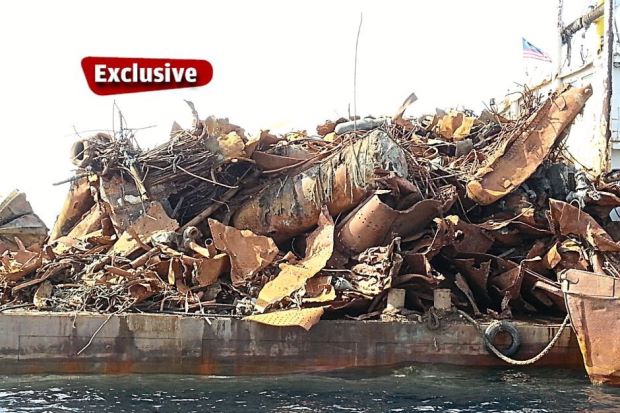
•沈船が漁礁として地元の大切な漁場になっており漁業者に被害が出ている
•大戦中に亡くなった水兵たちの墓標であり慰霊の場であること
などの問題点を同紙は解説し、地元から業者に対する非難や中止を求める声が上がっていることを伝えています
•船型:クレーン船
•建造:2007年中国福建省 FUJIAN XINCHANG SHIPBUILDING
•母港:丹東
•船籍:中国→カンボジア
※引用先(4) ※引用先(5)
PETALING JAYA: A ship that illegally stripped shipwrecks off Penang island for scrap metal has been detained and impounded by the northern region Marine Department.
There was a mountain of rusty ship parts and salvage work was in progress when the agency’s officials boarded the ship, which is equipped with a crane, off Kendi Island.
The agency had been alerted about the illegal operation after The Star first discovered the salvaging there last week.
The Cambodian-registered vessel was caught red-handed dredging the Chosa Maru wreck, better known as the Japanese wreck among locals. The skipper and his nine-man crew, all Chinese nationals, have been arrested.
Aside from seizing the ship, the authorities impounded a workboat that accompanied Hai Wei Gong 889, a Chinese-made vessel that was commissioned in 2007.
“The ship does not have the documents for salvage work and was operating illegally in Malaysian waters,” a marine department official said.
The ship, workboat and its crew had been ordered to sail to Lumut, where the ship is now impounded.
“We are also investigating where the vessel had disposed the scrap metal after salvaging at least five shipwrecks off Penang, including the two Japanese World War II wrecks,” the official said.
At this point, he said, the authorities were investigating who the buyer of the scrap metal was.
“The department is also investigating how long the ship had operated in Malaysian waters illegally and whether it had looted other areas besides Penang.”
The official said the department was investigating if the vessel had plundered other ships, both commercial and military, off the east and west coast of Malaysia.
The Star reported yesterday that illegal salvagers had plundered scrap metal from at least five shipwrecks, including two Japanese World War II vessels, off Penang waters since early this year and their activities had gone undetected by the authorities.
The unscrupulous salvagers were believed to have “cleared up” at least two wrecks – the Japanese gunboat Chosa Maru, called Kapal Jepun by locals, which sunk in August 1943, and Japanese light cruiser Kuma that went down on January 1944 – and had taken away metal worth millions.
The other three wrecks that are being salvaged are Japanese warship Haguro, Kapal Taiwan and Kapal Simen, which are all located off Kendi Island.
韓国の海洋警察は救助活動を行って5人を救助したが、2人は死亡し、追加捜索を行って1人の遺体を引き揚げた。救助された3人と遺体3体は板門店(パンムンジョム)を経由して北朝鮮に送った。海洋警察や麗水警察署などによれば、沈没した船は北朝鮮の清津(チョンジン)港から出発して中国揚州市近隣の江都港へ向けて航海中だった。重油50トンや鉄鉱石などが載っていた。韓国政府は14日、最後の遺体1体を北朝鮮に引き渡した。
グランドフォーチュン1号は海がない内陸国、モンゴル国籍の船だった。船主は香港にある会社だった。海洋水産部などは船主が「便宜置籍」の一環としてモンゴルに船を登録して賃金が安い北朝鮮船員を雇用し、貨物事業を展開していたと推測した。
便宜置籍は、自国船員の義務雇用比率を避けて税金節約のために他国に船を登録することをいう。それ自体は違法ではない。パナマやリベリア国籍の船が多いのは便宜置籍が多い国だからだ。
モンゴルは内陸国だが2003年から船舶登録局を開設して他国の船の登録を受けている。船舶登録を受けて税金を集めて海運産業を育成するためだ。ウィキリークスが2007年に公開した米国大使館の資料によれば、モンゴルには283隻が登録されている。船の主人の国籍はシンガポール(91隻)、パナマ(22隻)、マレーシア(22隻)、香港(12隻)などだった。船主が国籍不明な船も39隻あった。
北朝鮮が香港会社を代理船主として前面に出し、モンゴルに船を登録した可能性を見せている部分だ。外交部関係者は「今回のグランドフォーチュン号は、韓国領海ではない公海上で発見されたので対北朝鮮制裁決議にともなう船舶の捜索や調査を行えなかった」として「すぐに目についた重油や鉄鉱石のほかに、どんな物があったのかは確認できなかった」と話した。
先月出てきた国連安保理の対北朝鮮制裁の専門家パネル報告書によれば、国籍は北朝鮮ではないが実際は北朝鮮の船と疑われるものが最低8隻以上だった。このうちスンリ2号、グンザリ号、クァンミョン号の3隻は、今回発見されたグランドフォーチュン1号のようにモンゴルに登録されている。他国の国籍を持っており、船主は香港人である船も1隻あった。
国連対北朝鮮制裁の専門家パネルは報告書を通じて「安保理の対北朝鮮制裁決議2094号(2013年)が発効された後、北朝鮮は船舶を再登録したり国籍を変更したりして制裁を避けようとする可能性が高い」と指摘した。実際に北朝鮮は昨年だけで4隻の船をカンボジア・トーゴなどに国籍を変更した。
このような前例もある。2011年5月、北朝鮮の南浦港(ナムポハン)からミサイル武器などと推定される部品を載せてミャンマーへ向かった「ライト」号は、米国海軍の追撃を受けると公海上にとどまって回航した。ライト号は2006年まで「ブヨン1号」という名前を使う北朝鮮国籍の船舶だったが、北朝鮮核実験後に対北制裁が激しくなると名前を「ライト」に変えて国籍も中米のベリーズに変更して運行した。「ライト」号は米国の取り締まりがあってから2カ月後、アフリカのシエラレオネで国籍を変えて船の名前も「ビクトリー3号」に変更した。国連の対北朝鮮制裁の専門家パネルは、国籍を「洗浄」した北朝鮮の船が19隻以上に上ると推定している。
The Associated Press
MOKPO, South Korea - Fresh questions arose about whether quicker action by the captain of a doomed ferry could have saved lives, even as rescuers scrambled to find hundreds of passengers still missing Friday and feared dead.
Officials also offered a rare look at their investigations, saying they were looking into whether a crewman's order to abruptly turn the ship contributed to the 6,852-ton Sewol ferry tilting severely to the side and filling with water Wednesday.
The confirmed death toll from Wednesday's sinking off southern South Korea was 28, the coast guard said. Most of bodies have been found floating in the ocean because divers have been continually prevented from getting inside the ship by strong currents and bad weather. But 48 hours after the sinking the number of deaths was expected to rise sharply with about 270 people missing, many of them high school students on a class trip. Officials said there were 179 survivors.
New questions were raised by a transcript of a ship-to-shore exchange and interviews by The Associated Press that showed the captain delayed evacuation for half an hour after a South Korean transportation official ordered preparations to abandon ship.
The order at 9 a.m. by an unidentified official at the Jeju Vessel Traffic Services Center to put on lifejackets and prepare for evacuation came just five minutes after a Wednesday morning distress call by the Sewol ferry. A crewmember on the ferry, which was bound for Jeju island, replied that "it's hard for people to move."
The ship made a sharp turn between 8:48 a.m. and 8:49 a.m. Korea time, but it's not known whether the turn was made voluntarily or because of some external factor, Nam Jae-heon, a director for public relations at the Maritime Ministry, said Friday.
The captain has not spoken publicly about his decision making, and officials aren't talking much about their investigation, which includes continued talks with the captain and crew. But the new details about communication between the bridge and transportation officials follow a revelation by a crewmember in an interview with The Associated Press that the captain's eventual evacuation order came at least half an hour after the 9 a.m. distress signal.
Meanwhile, strong currents and rain made rescue attempts difficult again as they entered a third day. Divers worked in shifts to try to get into the sunken vessel, where most of the missing passengers are thought to be, said coast guard spokesman Kim Jae-in.
Coast guard officials said divers began pumping air into the ship Friday, but it wasn't immediately clear if the air was for survivors or for a salvage operation. Officials said in a statement that divers were still trying to enter the ship.
South Korean officials also offered a glimpse into their investigation of what may have led to the sinking. They said the accident happened at a point where the ferry from Incheon to Jeju had to make a turn. Prosecutor Park Jae-eok said in a briefing that investigators were looking at whether the third mate ordered a turn whose degree was so sharp that it caused the ship to list. The captain was not on the bridge at the time, Park said, adding that officials were looking at other possible causes, too.
Park also said crews' testimonies differed about where the captain was when the ship started listing. As that listing continued, the captain was "near" the bridge, Park said, but he couldn't say whether the captain was inside or right outside the bridge.
The operator of the ferry added more cabin rooms to three floors after its purchase the ship, which was built in Japan in 1994, an official at the private Korean Register of Shipping told the AP on Friday.
The official, who spoke on condition of anonymity because the person was not allowed to discuss matters under investigation, said the extension work between October 2012 and February 2013 increased the Sewol's weight by 187 tons and added enough room for 117 more people. The Sewol had a capacity of 921 when it sank.
As is common in South Korea, the ship's owner, Chonghaejin Marine Co. Ltd, paid for a safety check by the Korean Register of Shipping, the official said, which found that the Sewol passed all safety tests, including whether the ship could stabilize in the event of tilting to the right or to the left after adding more weight.
Ian Winkle, a British naval architect and ferry expert said many ships have such modifications, to increase capacity, for instance. "In this particular case, it would have affected the stability by a small amount, but as it seems from the structure of the vessel, generally, it looks as if it was adequate to meet statutory regulations," Winkle said.
Near the site of the ferry, angry and bewildered relatives gathered on a nearby island watched the rescue attempts. Some held a Buddhist prayer ritual, crying and praying for their relatives' safe return.
"I want to jump into the water with them," said Park Geum-san, 59, the great-aunt of another missing student, Park Ye-ji. "My loved one is under the water and it's raining. Anger is not enough."
Kim, the coast guard spokesman, said two vessels with cranes arrived and would help with the rescue and to salvage the ferry, which sank not far from the southern city of Mokpo. But salvage operations hadn't started yet because of the rescue attempts.
Out of 29 crewmembers, 20 people, including the captain, Lee Joon-seok, 68, survived, the coast guard said.
The captain made a brief, videotaped appearance, although his face was hidden by a gray hoodie. "I am really sorry and deeply ashamed," Lee said. "I don't know what to say."
Kim Soo-hyun, a senior coast guard official, said officials were investigating whether the captain got on one of the first rescue boats.
The 146-meter (480-foot) Sewol had left Incheon on the northwestern coast of South Korea on Tuesday for the overnight journey to the southern resort island of Jeju. There were 475 people aboard, including 325 students from Danwon High School in Ansan, which is near Seoul,
It was three hours from its destination Wednesday morning when it began to list for an unknown reason.
Oh Yong-seok, a helmsman on the ferry with 10 years of shipping experience, said that when the crew gathered on the bridge and sent a distress call, the ship was already listing more than 5 degrees, the critical angle at which a vessel can be brought back to even keel.
The first instructions from the captain were for passengers to put on life jackets and stay where they were, Oh said.
A third mate reported that the ship could not be righted, and the captain ordered another attempt, which also failed, Oh said. A crew member then tried to reach a lifeboat but fell because the vessel was tilting, prompting the first mate to suggest to the captain that he order an evacuation, Oh said.
About 30 minutes after passengers were told to stay in place, the captain finally gave the order to evacuate, Oh said, adding that he wasn't sure in the confusion and chaos on the bridge if the order was relayed to the passengers. Several survivors told the AP that they never heard any evacuation order.
By then, it was impossible for crew members to move to passengers' rooms to help them because the ship was tilted at an impossibly acute angle, he said. The delay in evacuation also likely prevented lifeboats from being deployed.
"We couldn't even move one step. The slope was too big," said Oh, who escaped with about a dozen others, including the captain.
The last major ferry disaster in South Korea was in 1993, when 292 people were killed.
Klug reported from Seoul. Associated Press writers Hyung-jin Kim in Ansan and Jung-yoon Choi in Seoul contributed to this report.
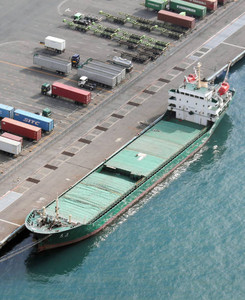
伊豆大島沖で第18栄福丸と衝突事故を起こし、
係留されている貨物船「ジィア・フイ」=1月7日、
静岡市の清水港で、本社ヘリ「あさづる」から
昨年九月に東京・伊豆大島沖で貨物船同士が衝突し、名古屋市の海運会社が所有する「第18栄福丸」の乗組員六人が死亡した事故で、相手方の「JIA HUI」(ジィア・フイ)の中国の船主側が栄福丸の船体補償交渉に応じない状況が続いている。事故当時のジィア・フイの当直責任者で、業務上過失致死罪などに問われた中国籍の夏紅波被告(36)の十四日の判決に執行猶予が付けば釈放になる。栄福丸関係者から、判決後のさらなる停滞を懸念する声があがる。
焼津市の高井智昭さん=当時(40)=ら乗組員六人への遺族補償では、ジィア・フイ側の保険会社が最大五億三千八百万円を提示したとされる。先月の静岡地裁沼津支部の公判で夏被告側が明らかにした。栄福丸を所有する丸仲海運(名古屋市港区)の杉下吉利社長(64)は「具体的な交渉はまだのようだ」と話す。遺族の一人は、公判で提示額を初めて知ったほどで「船主側に誠意ある対応がみられず、夏被告が中国に帰ると話が停滞するのではないか」と気をもむ。
ジィア・フイの船主側との間では船体などの補償も滞っている。栄福丸は船体だけで損失は四億九千万円。積み荷や逸失利益などを合わせると損失は十億円を超えるという。丸仲海運には損保会社から保険金が支払われたが、沈没した栄福丸が稼働できなくなったことによる逸失利益は対象外で、毎月千三百万円の損失が出ている。
ジィア・フイの船主側からは、今も謝罪の電話さえなく、中国の保険会社は、国外での操船免許を持たない夏被告が当直責任者だったことが免責に当たると主張。交渉に入れない状態が続く。損失をわずかでも回収したい栄福丸側は昨年十二月、静岡地裁にジィア・フイの差し押さえを申し立てたが、地裁の決定はまだ出ていない。
丸仲海運に保険金を払った損保会社は先月二十日、夏被告に一億円の損害賠償を求める裁判を起こした。夏被告の過失で事故は起きたとして、船価の一部を請求している。
この訴訟で、賠償命令が出ても日本の判決は中国国内での効力はない。賠償金を得られる見込みは低いが、夏被告を雇う船主側にも責任があると示し、交渉のテーブルにつかせるのが狙い。代理人は「交渉が進まないなら雇用会社側などを相手に中国で提訴するのも選択肢だ」と話した。
(斉藤明彦)
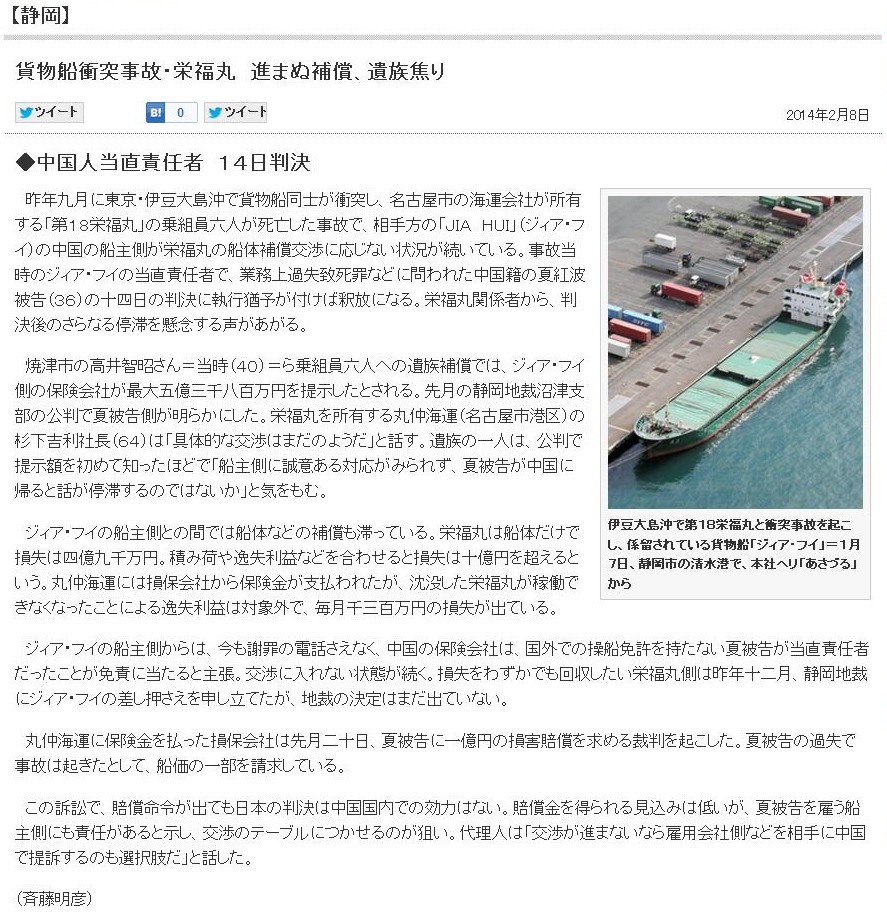
ITFは2009年4月、韓国の平澤(ピョンテク)港の船舶から連絡を受けた。この船の乗組員の1人が、本船には食料も飲料水もない、と連絡してきた。中国・大連の船主、オリエンタル・デベロプメント社からの連絡が途絶えており、乗組員は賃金も受け取っていなかった。
この船は、貨物が損傷していたため、第三者により、3月に差し押さえられていた。
ITFは、船主と連絡を取ろうとしたが、成功しなかった。ソウルの中国大使館は、韓国によって本船が差し押さえられているため、未払い賃金、食料、飲料水の供給など、全ての問題は韓国側が処理すべきである、と支援を拒否した。
インスペクターは乗組員を訪問し、未払い賃金および帰国旅費に関する法的手続きを開始した。同時に、キム・ヘキョンITFコーディネーターは、ITF海事活動部門に連絡するとともに、問題解決のため、中国大使館と話し合った。
ITFと会うことを船主は遂に受け入れたが、問題の解決には同意しなかった。彼らの主要な関心事は乗組員ではなく、船舶にあった。彼らは、食料と飲料水の供給を拒否し、乗組員と会うことさえ拒否した。
乗組員は飢えに瀕している、とITFに伝えられたため、韓国の組合が250米ドル相当の食糧と飲料水を提供した。船主は、数回にわたり韓国を訪問していたにもかかわらず、何の措置も支援も提供しなかった。そのため、韓国のインスペクターは、法的手続きの決着を待たずに、船員たちを帰国させることとした。
韓国海員労組連盟(FKSU)のバン・ドンシク委員長と乗組員の話合いの中で、ITFは9人の乗組員の帰国旅費を負担することに同意した。9人のうちの7人は帰国することを決めたが、船長と機関員は船内に残った。未払い賃金を手にするのは容易ではないと思われるが、ITFは現在、法的措置の結果を待っている。
An ongoing legal process brought against Dongwon Industries by a woman widowed by the June 2010 sinking of purse seiner Majestic Blue is the origin of latest fraud allegations against the South Korean company, owner of US brand Starkist.
Dongwon is accused, in an amended claim filed on Jan. 10 in the US district court for Delaware, of using straw companies to control Majestic Blue and another seiner, Pacific Breeze, to gain access to fishing licenses for which only US citizens are eligible.
Pacific Breeze and Majestic Blue were registered in South Korea prior to 2008 and named Eastern Kim and Costa de Marfil, respectively, which would have excluded them from licensing eligibility, the claim document states.
The allegations contained in the claim, from law firm Moore & Company, are linked to two separate ongoing legal processes around the sinking of Pacific Breeze and the death of its skipper, David Hill.
This was referenced in a statement sent to Undercurrent News from Dongwon on Tuesday.
Moore & Company “is currently representing a client in ongoing, related litigation against Dongwon”, reads the statement from the tuna giant. “The allegations made by the Moore law firm are meritless, and intends to vigorously defend itself in this matter, including seeking a full dismissal of the action”.
The legal action referred to by Dongwon is the lawsuit filed in October 2010 by Amy Hill, the widow of David, alleging wrongful death. Moore are seeking at least $5 million in damages.
On Nov. 5, 2010, Majestic Blue was served with a copy of the summons and complaint, then, on Dec. 9, 2010, filed the instant action seeking limitation of its liability for the claim.
Both legal processes are ongoing.
Moore has “contested Majestic Blue Fisheries’ right to limit its liability for the sinking”, Blair Brogan, of the law firm, told Undercurrent. “The court is currently making its decision on whether Majestic Blue is entitled to limit its liability, all papers and arguments having been submitted.”
In the wrongful death lawsuit, the defendants are Majestic Blue Fisheries LLC and Dongwon, which it is alleged controlled Majestic Blue.
“The wrongful death action, against both Majestic Blue and Dongwon, is currently stayed pending the court’s decision in the limitation action,” Brogan said.
If the ship owner were entitled to limit its liability in this particular case, liability would be limited to the remaining value of the vessel, nothing, the vessel’s equipment and appurtenances ($33,500), and any pending freight, also nothing, said Brogan.
“Thus, the owner would be able to limit its liability to $35,000 in the wrongful death action,” she said.
‘State of the art’ seiner
On Oct. 13, 2009, Hill entered into an employment contract to act as the skipper of Majestic Blue, which was represented “state of the art purse seiner that was 100% owned by United States citizens and “proudly” flew the US flag”, states the claim document from Moore, on behalf of Hill.
Hill’s contract was for three months onboard, followed by a three-month vacation period, after which time his contract contemplated that he would return for another three-month period on board.
Hill was began his second term as captain of the vessel in May 2010, immediately following a maintenance period in a Chinese shipyard. He relieved the former captain, another US national named Thomas Ridenour.
Ridenour directly observed the work done to the vessel in the Chinese shipyard, states the claim document.
According to Ridenour, the vessel had not been well repaired and the work done by the Chinese yard was below industry standard.
Ridenour observed, the document states, that the combination of Dongwon and Majestic Blue not allowing the Chinese shipyard sufficient time, a lack of planning, lack of communication, lack of coordination, and poor quality of work by the Chinese shipyard had caused serious problems for Majestic Blue.
Ridenour observed the vessel would not be able to pass any sort of detailed inspection and doubted any United States Coast Guard inspector would pass it, it is alleged.
Ridenour also commented that he would not work for the company again and that he was “personally ashamed” to have his name linked with the dry-docking of the vessel in China, the document states.
Around May 9, 2010, at the very end of the dry dock period, Hill arrived in Guam to meet the Majestic Blue and relieve Ridenour.
Hill was the only US national and was one of very few people on the vessel who spoke English. Dongwon or Majestic Blue did not provide a translator, “even though it was standard practice on other similar vessels” and despite previous captains having requesting translators, the claim alleges.
All of the officers on the vessel, aside from Hill, were Korean nationals and all of the remaining crew were either Korean nationals or nationals from other Southeast Asian countries, it claims.
The fishing master on the vessel “acted as the de facto captain” and yet was allegedly unqualified for the position. “For instance, when leaving the port of Guam the fishing master went the wrong direction and the vessel was forced to turn back to rejoin the rest of the purse seiner fleet”, the document states.
It goes on to state that the US national captains hired by Dongwon and Majestic Blue “were “window dressing”, brought onboard to meet the crewing requirements of the US vessel registry and not to command the Korean-operated, managed and de facto owned purse seiner.
The Korean “fishing master” was the actual master and captain of the vessel and was, along with the Korean officers, tacitly or in fact authorized by Dongwon and Majestic Blue to ignore the orders of the US captain, Hill’s claim states.
A former skipper of the vessel, Douglas Pine, sued Dongwon and Majestic Blue in April 2010, alleging mutiny, abuse by the crew and pollution violations.
Dongwon and Majestic Blue “also made no effort to correct the shoddy, rushed and low quality ‘repairs’” to the vessel, despite having knowledge of the problems through Ridenour, who admitted it would be unable to pass any sort of detailed inspection, it is alleged.
Around May 20, 2010, Hill and the vessel departed the US territory of Guam to commence a fishing expedition.
The vessel began taking on water around June 13, 2010, in what the claims states were “calm seas and good weather”.
Of the 24 crewmembers on board at the time, 22 abandoned ship and were later rescued by another purse seiner, Pacific Breeze, the other vessel that is the subject of the license fraud allegations against Dongwon and Majestic Blue.
Hill and the chief engineer remained “or were either negligently or intentionally left onboard the sinking vessel, which at some point rolled on its side and sank to the bottom of the Western Pacific Ocean”.
After two days of search and rescue by the United States Coast Guard and certain vessels of the purse seiner fleet, neither the chief engineer nor Hill were found, having drowned with the vessel.
The family of the Chief Engineer, Chang Cheol Yang, filed a lawsuit against Dongwon and Majestic Blue for compensation for his wrongful death on June 11, 2013. This process is also ongoing.
Subsequent to the sinking, it is alleged the defendants retained certain of Hill’s personal effects -- including the personal laptop he carried with him through his tour.
This was kept for nearly two months until they were finally returned to his wife, after repeated calls for their return by her attorneys.
In this time, it is alleged the defendant’s accessed the personal computer of Hill and viewed “intimate correspondences” and emails between the married couple. “The invasion was a gross invasion of privacy into an area any reasonable person would deem private from public gaze and was totally unwarranted,” the claim alleges.
When a memorial service was held for Hill, “without prompting or invitation”, Dongwon and Majestic Blue sent two employees. In addition, agents of the company have Amy Hill with any information regarding her husband’s death, the document states.
Hill ‘responsible for own death’
In its response, filed on May 15, 2013, Dongwon states it was not Hill’s employer and, therefore it cannot be held responsible for the claims presented under the doctrine of un-seaworthiness.
“Dongwon did not own, operate, manage or charter the subject vessel and, therefore cannot be charged with liability attributable and/or flowing from ownership,” it states.
According to the document, “Hill failed to follow lawful orders to evacuate the Majestic Blue and his failure to do so caused his death”.
The sinking and Hill’s “death occurred due to the natural action of wind and wave for which Dongwon has no responsibility”.
He also failed to properly utilize the vessel’s bilge pumps, alarms, communications equipment, life rafts and other safety measures at the time of the sinking, it alleges.
In addition, Hill failed and refused to accept the assistance and instruction of the other crewmembers and his failure solely caused “and/or contributed” to his death.
He was not instructed or directed to remain onboard the vessel, “nor was it necessary for him to remain onboard once all crewmembers had abandoned ship and were disembarked”, states Dongwon’s defense.
Hill “recklessly and/or negligently and/or intentionally remained onboard in open and obviously unsafe conditions without notice of any kind to Dongwon and without the use of safety equipment”, and was “responsible for his own death in that his normal faculties were impaired”.
He also “failed to maintain a seaworthy vessel”, Dongwon claims.
Ship Name:
PACIFIC BREEZE
Type of Ship:
FISHING VESSEL
Flag:
U.S.A.
IMO:
7395624
Gross Tonnage (ITC):
1039 tons
Year of Built:
1975
Builder:
TACOMA BOATBUILDING - TACOMA WA, U.S.A.
Class Society:
KOREAN SHIPPING REGISTER
Manager & owner:
PACIFIC BREEZE FISHERIES - PITI, GUAM
Former name:
- EASTERN KIM until 2009 Dec
- SHIN CHEON NO.2 until 1988 Jan
- JALMI until 1984 Jan
- NIOMRE until 1975 Dec
Ship Name:
MAJESTIC BLUE
Type of Ship:
FISHING VESSEL
Last known flag:
U.S.A.
IMO:
7207358
Gross Tonnage (ITC):
1172 tons
Year of Built:
1972
Builder:
MARITIMA DEL MUSEL - GIJON, SPAIN
Former name:
COSTA DE MARFIL until 1972
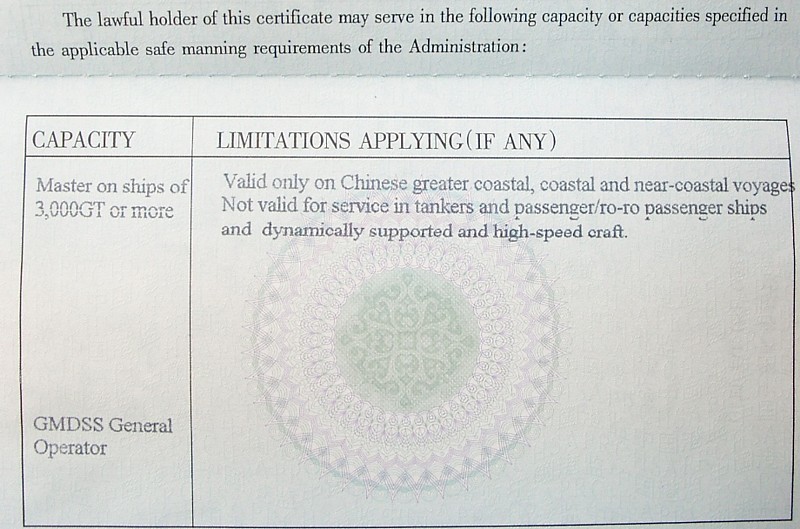
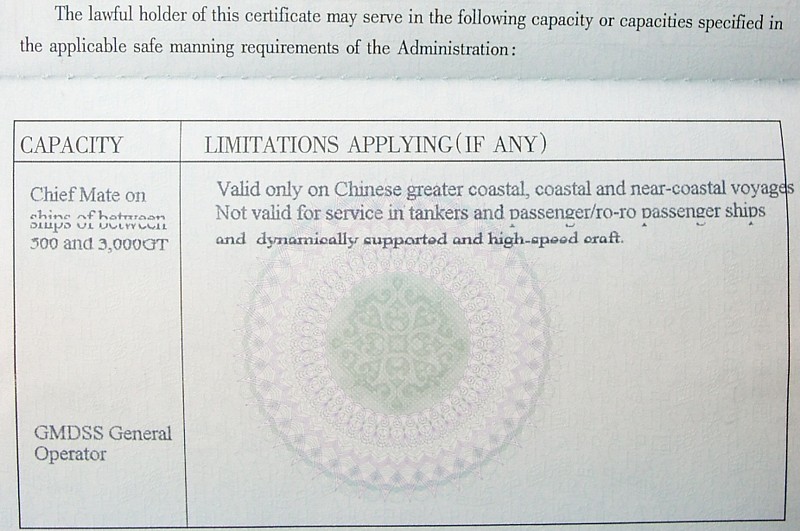
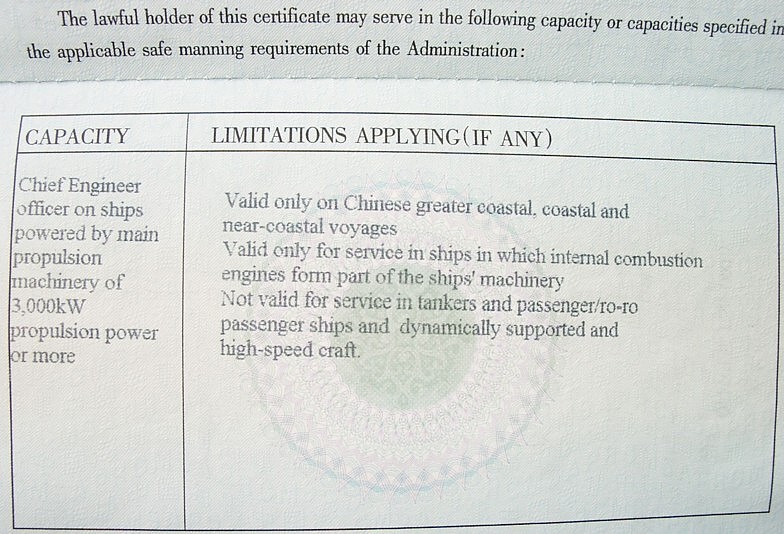
追加情報としては韓国のPSC(外国船舶監督官)は上記の点を不備として指摘し出港停止命令を出したことがある。
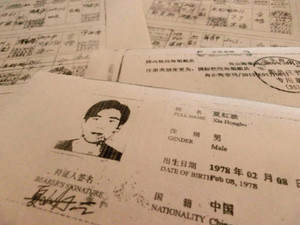
夏紅波被告の船員証書や乗船記録などのコピー。外国で操船する資格は持っていなかった=今村太郎撮影
中国企業の貨物船は、アフリカ・シエラレオネ船籍「JIA HUI(ジィア・フイ)」(二、九六二トン)。衝突は九月二十七日午前一時二十五分ごろ、伊豆大島の西方約十一キロの海上で発生し、栄福丸は転覆した。
ジィア・フイを運航、管理していた中国企業関係者や中国海事当局によると、衝突当時に当直で操船を担当していた夏被告は「丙類二副」という船員資格を持っているが、外国で操船することはできない。さらに、外国での乗船業務は今回が初めてだった。
事故当時の状況では、国際規則に基づき、ジィア・フイが右にかじを切って回避する義務があった。だが、起訴状などによると、夏被告は事故直前、かじを握る船員に左へ切るよう指示したとされており、国際規則を順守しなかったことが事故原因とみられる。
ジィア・フイは浙江省寧海県の「中和海運有限公司」が所有するが、事故当時は同省寧波市に拠点がある「嘉恵海運有限公司」に貸し出され、同社が契約した乗組員十三人が乗船していた。うち三人は操船免許を持っていたが、事故当時はいずれも就寝中だった。
嘉恵海運の楼舟豪・総経理は「夏被告は事務職としてジィア・フイに乗り込んだ。なぜ夏被告が操船していたのか分からない」と話している。
事件をめぐっては、十二月十三日に静岡地裁沼津支部で夏被告の初公判がある。夏被告が操船していた理由や状況とともに、中国企業側の管理責任も焦点となりそうだ。
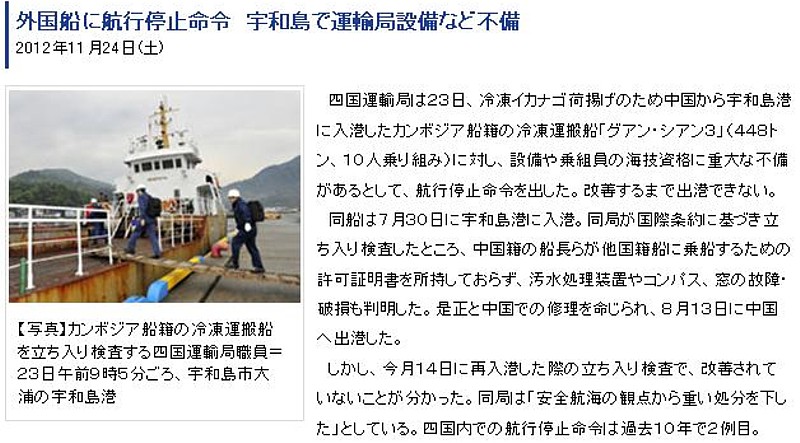
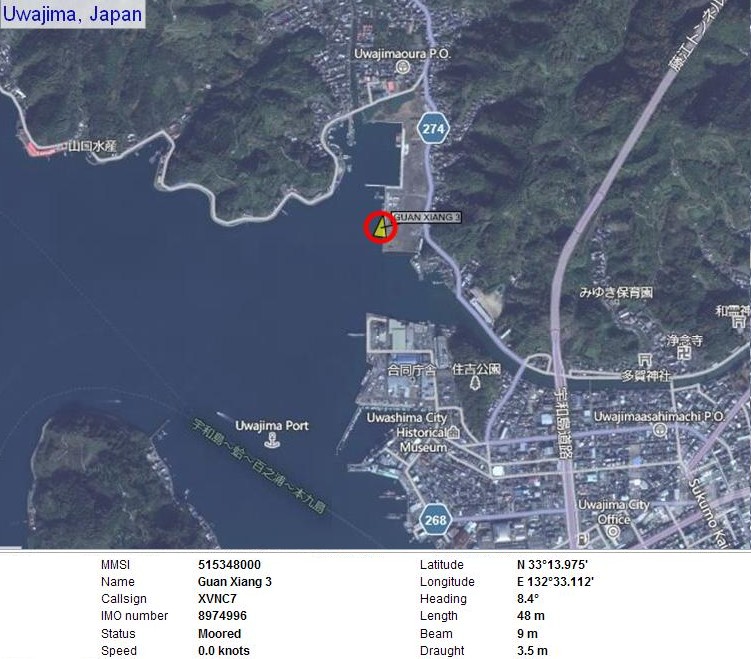

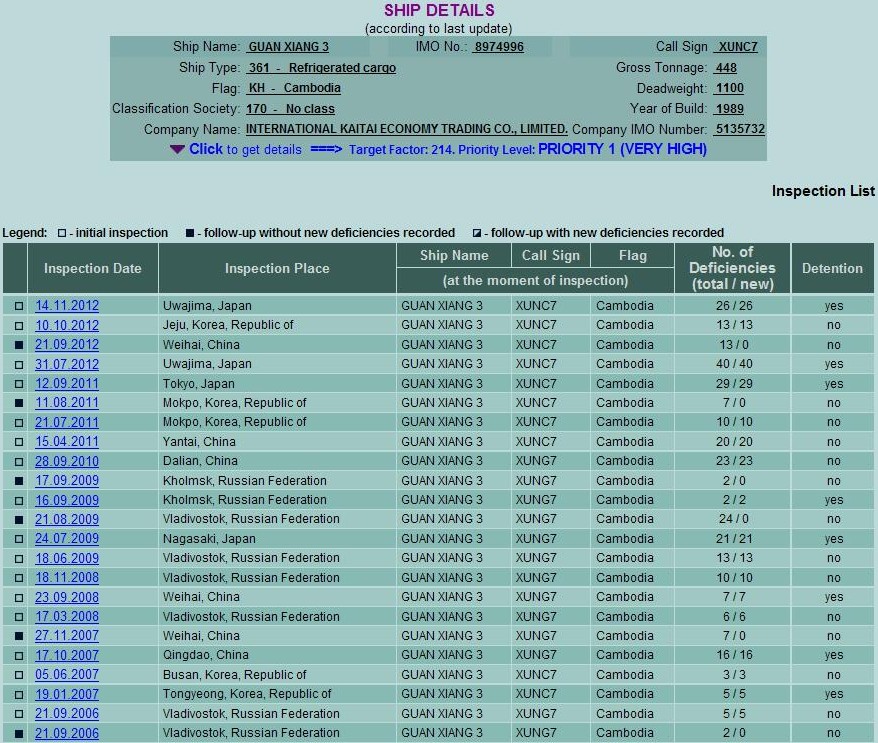
TOKYO MOUのサイトより
同船は7月30日に宇和島港に入港。同局が国際条約に基づき立ち入り検査したところ、中国籍の船長らが他国籍船に乗船するための許可証明書を所持しておらず、汚水処理装置やコンパス、窓の故障・破損も判明した。是正と中国での修理を命じられ、8月13日に中国へ出港した。
しかし、今月14日に再入港した際の立ち入り検査で、改善されていないことが分かった。同局は「安全航海の観点から重い処分を下した」としている。四国内での航行停止命令は過去10年で2例目。
事故に遭遇した東京の自営業の男性(52)は「乗客に避難を促すアナウンスは一度もなかった」と振り返る。座礁の衝撃があったのはレストランにいた13日午後9時半すぎ。船が傾き始めたにもかかわらず「機械のトラブル。心配ない」との放送が2回繰り返された。
約1時間後に突然、緊急を知らせるサイレンが鳴った。レストランの客は一斉に出口に向かって走り、デッキにあった救命具を自力で探し当てて身に着けた。
男性は「指揮命令系統が全く機能していなかった」と指摘。乗客乗員の脱出が完了する前に船長が船から避難していたことについては「われわれを見捨てて逃げるとは腹立たしい」と話した。
地元メディアによると、乗員の多くはフィリピン人などの外国人でイタリア語を話せず、乗客同様パニックに陥る者もいた。避難対応をしていた乗員は救命ボートを海に降ろす方法を知らず、たまたま乗客の中にいた元船乗りの男性に教わる場面もあったという。(共同)
参考情報1、
コスタクルーズ船での避難訓練 (2011年11月にコスタファボローザで旅行したクルミ飴さんのブログ「飛行機大好きクルミ飴 」より)
参考情報2、
船の避難訓練 (AOKAEDE)
一方、沿岸警備隊によると、浸水した船内で15日、新たに2人の遺体が見つかり、事故の死者は5人になった。安否が確認できない人は17人に上る。
地元検察当局は14日、船長の身柄を拘束し、過失致死などの疑いで取り調べを始めた。AP通信によると、船長は乗客の避難が終わる前に船から脱出したとの指摘がある。
避難誘導の不手際も浮上している。事故後、乗員は乗客に「船は安全だ」「技術的な問題にすぎない」などとアナウンスする一方、救命ボートを降ろす作業などが後回しになったとの見方が出ている。船体の傾きが増すに連れて乗客はパニック状態となり、一部はボートに乗れず、海へ飛び込んだ。
ANSA通信などによると、船内では15日、新婚旅行中の韓国人男女2人が救出された。続いて乗員1人も救出された。
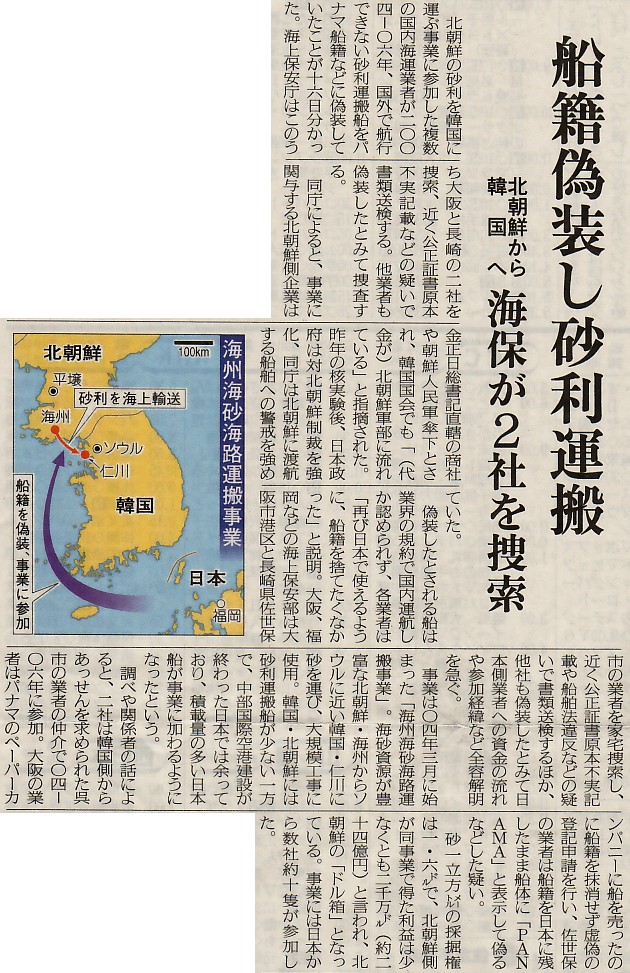
渡井海事のHPより
投稿者:渡井 [2004/12/25 15:49:23]
2002年に国土交通省は、日本の港に入港する船舶の保険の加入状況を調査しました。その結果延べ73%の船舶は何らかの保険に加入していました。入港する船舶の4隻に1隻は未加入のまま航行しているわけです。
改正油濁法で加入を義務付けている保険の内容は、主に港湾施設や漁具などに生じた損害・油濁に関する損害・座礁の際の船骸撤去費用ですが、この加入73%の中にはこれを包括しきれていないものもあり、改正油濁法が施行される2005年3月までに未加入の船舶の加入も含め、適切な保険の加入率が上がるのかどうかは疑問視されます。
なぜ疑問視されるのか?今世界中の海では保険に加入することの出来ない状態で航行を続ける船舶が横行している実態があります。
一つは便宜置籍船(FOC)の存在です。もちろんFOCすべてがそうだとは限らないのですが、船体・機関・通信・救命などの設備が国際条約で定められた基準以下(サブスタンダード)であるため、航行や人命安全の確保の上で問題のある船舶が多いと指摘されています。このような船舶では到底改正油濁法の見合うような保険の加入は出来ません。
発展途上国のように経済的な事情から保険に加入できない、あるいは改正油濁法にある要件を満たしきれない保険にしか入れないというケースもあります。北朝鮮籍の船舶に至っては、前述の調査での加入率はわずか延べ2.8%でした。
元日本国籍船舶もまたサブスタンダード船となっているケースがあります。日本の領海のみを航行区域とする内航船舶は、国際条約に定める基準を満たさなくとも良い部分があるため、これを海外に売却して買い受けた外国の船主がそのまま国際航海させてしまえば、これがサブスタンダード船になってしまうのです。
なぜこのようなサブスタンダード船が世界中を航行するようになってしまったのでしょうか。国際条約に定める基準を満たすための(保険加入を含めた)コストを削ってまでも経済活動を行なう海運業者、それを取り巻く検査会社や造船所もまたサブスタンダードと知りつつその欠陥船に関わり利益を得ている実態。『船舶がサブスタンダードではなく、船舶所有者やそれを運航する者、その船舶のサービスを(欠陥船と知りつつ)利用する顧客、それら全てがサブスタンダードだ』と評する記事もあります。船舶に関わる者のモラル低下、責任感の欠如がサブスタンダード船を根付かせたといっても過言ではないでしょう。
現在日本沿岸には、10隻からの外国籍の座礁放置船があります。これらは保険未加入のため撤去費用を支払えず放置されたか、あるいはもともと保険に入れないサブスタンダード船であった、というものばかりです。船主の社会的責任のなさが表れた具体例です。
重大事故の責任を取ることの出来ない悪質な船舶に対し、世界各国ではPSC(ポートステートコントロール)を厳しく行なうようになりました。PSCとは、外国船が入港する際その寄港国によって行なう外国船舶の監督です。入港してきた外国船の船体構造や諸設備、船員の資格などを厳密にチェックすることで、航行の安全性や人命の安全確保、環境保全を図ることを目的に行なわれます。日本でも北朝鮮の万景峰号の件で注目されるようなりました。現在各地方運輸局等に外国船舶監督官が配置され、この業務を行なっています。
とはいえ、改正油濁法の施行や日本人拉致問題をはじめとする北朝鮮との諸問題に対する経済制裁の一環として法案化された特定船舶入港禁止措置法案が成立しても、日本の経済にとってプラスになるのかという見方もあります。特に日本沿岸ではこのような船舶の輸送する物資で産業を成り立たせている業界があります。北朝鮮からズワイガニを輸入しこれを加工する日本海沿岸地域、ロシアやカンボジアから原木・石炭を輸入する秋田、廃タイヤを輸出する茨城、中国から鮮魚を輸入する福岡などからはこれらの法施行により経済的に大きな影響を受けてしまうとの声が上がっています。これらの業者に関わる港湾関係者も入港料の減少を危惧しています。法規制やPSCの強化で安全な船舶航行のための世界的な動きがあるその一方で、対象船舶の範囲を総トン数1000トン以上にしてもらいたい、中小船舶(上記の業界の原材料輸入には殆ど中小船舶が利用されています)の規制は緩やかにしてほしい等の関係業界の意見も出ています。杓子定規に法を適用することで、逆に国内からの反発も考えられるのです。
法規制を強めたところで、様々な思惑や利害が取り巻くサブスタンダード船はなかなか根絶できない状況にあるようです。何しろ、サブスタンダード船の殆どはPSC(役所)の動かない週末や夜間を狙って入港するんだそうです。確信犯としか思えない。
しかし、船の国籍を選べば、
PSC(外国船舶監督官)
が問題を指摘しない現状では逃げ道があるのです。
検査会社が検査を見逃してやり、お金と引き換えに証書を発給するから多くの船が日本に入港出来るのです。
事実を知らないから、上記のような発想が出来るのでしょうね。
産地偽装問題
も同じですが、正直者がばかを見るのが現在の日本です。
外国人に対して強い対応が出来ない日本の公務員が生み出した矛盾です。
これを読んだ人達の中には割り切れない矛盾を感じる人がいるかもしれません。しかし、これが現実です。
セウォル号事故は韓国で起こった。韓国はアジアの中では経済的に上位の国である。海運会社の姿勢、行政との癒着、癒着によるチェック体制の機能不全など
信じれない事が公になった。実際の問題を理解しなければ、「安全基準や検査制度自体」の整備と言っても絵に描いたもちになる可能性が高い。
国立研究開発法人海上技術安全研究所海難事故解析センター長◆田村兼吉
フェリーでは、車輌デッキの存在から、一旦事故が起きると大事故に繋がることが多い。
IMOはフェリーに関するSOLAS条約の改正を行ってきたが、各船の運航状況により水密扉の開放による復原性の問題が残る等、まだ課題は多い。日本はIMO等での安全性向上の先進的議論に参加しながら、その成果を積極的にアジアに還元していく取り組みを継続していくべきであろう。
フェリーの安全性
韓国の大型旅客船セウォル号が転覆・沈没した事故から一年以上が経過した。事故原因については韓国政府の正式な発表を待たねばならないが、過積載とバラスト水の意図的な操作、運航会社と船員の安全管理体制、不適切な船体改造と船体検査制度の不備、といった複数の要因が指摘されている。
セウォル号は日本国内では旅客船兼自動車渡船、いわゆるフェリーに分類される船舶であり、英語圏では、自走で乗用車やトラック・貨物が乗り降りするという意味のRoll on/Roll offからROPAX VesselやRo-Pax Ferryと呼ばれている。こうした「RoRo貨物スペースを持つ客船」と定義されるRoRoフェリー(以下フェリー)は、比較的短い航路で利用され、戦後、自動車交通の発達と共に大成功を収めてきた船種である。しかし、表に示すようにその過程で海外では大事故も起きている。
フェリーの事故率は特に大きい訳ではないが、事故の重要度に着目すると様相は変わってくる。図は1995年から2011年の17年間の海難事故データを分析し、F-N線図にしたもので※1、横軸に死者数、縦軸に超過頻度(1隻の船舶が1年間にそれ以上の規模の事故を起こす確率)をとっている。一般客船に比べてフェリーの超過頻度は高い。死者数の大きな事故ほど両者の差が開き、百名規模の事故では一桁近く高くなっている。つまり、フェリーでは一旦事故が起きると、多くの死者を出す大事故に繋がってしまうことを示している。
この最大の要因は、フェリーの特徴である複数層の巨大な車輌デッキの存在にある。デッキ内部は車輌の走行の利便性から、横隔壁が極端に少ない大空間となっている。そのため、一旦デッキ内に浸水すると、自由水は大きく動いて復原力を低下させるし、浸水の広がりも速いので、短時間で浮力を失う危険性も高い。内部の車輌や重い貨物は、大傾斜時に片舷に移動して傾斜を助長させる。火災も広がり易い。大きな外扉は、波にたたかれると損傷し易い。
水密扉の問題
問題点の一つは、損傷時復原性に関係する水密扉にある。車輌デッキの下層部は、水密隔壁で細かく仕切られている。隔壁には水密性を低下させる水密扉は設置しない方が理想的だが、乗組員の往来や非常時の避難経路確保を目的として、船主側はその設置を求めることになる。しかし、European Gateway号、Estonia号、Express Samina号の事故では、事故時に水密扉が閉まらなかったことから車輌デッキに浸水、船の転覆や沈没を招いたものと指摘されている。また、海外の調査では、航行中、日常的に水密扉が開放されたままだったり、整備不良だったりする違反は数多く報告されている。
国内でも同様の事故例もある。セウォル号事故の直後に徳島でおきたフェリー座礁事故では、岩礁との接触により右舷船底部にできた亀裂とフィン・スタビライザーの根元に開いた穴から浸水し、車輌デッキに通じる水密扉が開放されていたため、吹き上げてきた海水が最下層車輌デッキの腰の高さまで流れ込んだ。幸い、乗員乗客は無事で、船は自力航行により港まで戻ったが、車輌デッキへの浸水は重大な結果につながりかねなかった。
フェリーの安全性向上に、IMO(国際海事機関)が手をこまねいていたわけではない。水密扉や外扉が開放されたままでの上記の事故を受けて、1988年のSOLAS条約改正では、ブリッジに扉の開閉表示装置や漏水感知装置の設置を義務付けた。その後も、1992年に現存フェリーの損傷時復原性要件の導入、防火措置の改善・強化、1995年に損傷時復原性の水密性要件の強化、脱出経路要件の追加、1996年に貨物区域の防火措置、と矢継ぎ早に改正を行ってきた。
SOLAS条約には航行中にすべての水密扉を常時閉めておくことが規定されているが、多数の例外規定がある。2010年12月に導入された「航行中の船の扉の開放を許可する場合のガイダンス」でも、常に水密扉が開放された状況が各船の運航状況により生じるため、安全性向上が疑問視されている。こうした曖昧さを排除するために、2013年にIMOではSOLAS条約とガイダンスの全面的見直しが提案されており、日本としても、フェリーの安全性向上のための重要な取り組みとして注目している。
アジア視点の安全対策と日本の役割
セウォル号の事故時に「日本の内航フェリーではこのような事故は起きない」という声をよく聞いた。SOLAS条約の改正は直接適用されるものではなく、各国の国内法に反映された後に適用されるものである。国土交通省は、2009年のフェリー「ありあけ」の大傾斜事故時に、操船による大傾斜回避や貨物の固縛方法の改善等、いち早く再発防止策を講じるなど対応してきた。事業者側も、任意ISM※2コードの導入など、安全管理体制の充実を図っている。こうした日本独自のきめ細やかなソフト面での対策に加え、SOLAS条約の国内船適用や一般旅客船に比べ復原性要件を強化する等のハード面の対策も積極的に実施しており、こうした対応が自信の声につながっているのだろう。
一方、ASEAN諸国に目を向けると、経済発展とともにフェリーによる輸送需要が急速に高まっているが、安全基準や検査制度自体が整備されていないため、船舶事故が多発している国も多い。こうした国々では、日本から売却された中古フェリーも多数航行している。そのため、わが国はIMOとともにASEAN諸国の国内フェリー復原性ガイドラインを策定する等の協力を進めており、本年4月にもマニラで開催されたIMO内航フェリー安全セミナーに参加している。フェリー全体の安全性向上には、アジアという視点が必須である。IMO等での安全性向上の先進的議論に参加しながら、その成果を積極的にアジアに還元していく取り組みを、わが国は継続していくべきであろう。(了)
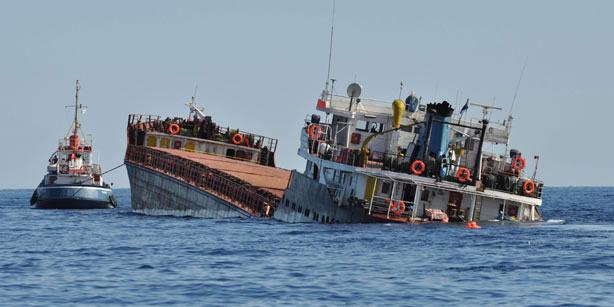
In June last year, ITF and affiliated unions published a brochure “Black sea of shame”, slating regional ship owners as irresponsible greedy flock, and the whole coastal shipping in Azov-Black sea area as extremely dangerous for the seafarers working on board of regional coasters.
On the wake of Volgo-Balt 199 disaster, ITF and affiliated unions, mainly SUR (Seafarer’s Union of Russia), are launching a news campaign aimed at what they call, “substandard shipping” in Azov-Black sea region. To comprehend the problem and the safety risks, one must scrupulously consider all known facts and statistics, avoiding emotions which prevail in media coverage of the Black sea disasters, and in Trade Union’s proclamations and allegations.
m/t Volgo-Balt 199 was vessel of river-sea type, widely spread in European waters. The owner of the vessel operates 5 other vessels, also coasters. The only criteria available for the assessment of the safety of those vessels, is the detention history. All 6 vessels, including the ill-fated Volgo-Balt 199, have a good history in this regard, after they were obtained by the owner in question. Before the present owner, their history wasn’t so good. Together with other information gathered after the disaster, including the Ukrainian Shipping Inspection statements, it may be presumed, that Volgo-Balt 199 was up to the required standards, or to put it short, as seaworthy, as the river-sea type vessel may be. The question is, what is seaworthiness of the river-sea type vessel, and why technically nonfaulty vessel sank in though strong, but still, regular for this region and this time of year storm?
The river-sea type was developed in former Soviet Union sometime back in the late 50-th, with the main idea of creating a vessel capable of navigating both inner waterways and the coastal seas. There are many projects of those vessels, they are widely built since the 60-th up to the present days, but whatever is project or year of built, the vessels still, are not seaworthy in a generally accepted meaning of seaworthiness. By Class requirements they’re restricted in navigation and can’t sail further than 50 nautical miles from a refuge, but in fact, such a restriction is a dissimulation. The vessels are too long, flat-bottomed and not strong enough in terms of structural strength.
The meaning of it is very simple – vessels are prone to capsizing even in fresh weather, if they become disabled and open the side to the waves, and prone to hull breaking in more or less strong storm, even if they’re under power and can keep against wind and sea. Vessel may be more than 50 miles off the coast, or less than 5 miles, it doesn’t actually matter. What matters is the sailing itself – river-sea type can’t sail into any storm, it’s mortally dangerous.
River-sea type in this respect, is similar to a soldier in battlefield, who’s moving around by short spurts from one shelter to another, during the short periods of fire cease. River-sea type has to sail from one port to another, from one area to another with enough places of refuge, during the periods of safe weather conditions, depending on favourable weather forecasts and captain’s knowledge and feeling of local weather. To be caught in storm is, if applied to river-sea type, an accident in itself, requiring an investigation, even if the vessel managed to survive. The long-term statistics show, that 2 out of each 100 river-sea type vessels sink due to unfavourable weather conditions.
“Substandard ship” term is widely spread and believed to be understandable without need for any further clarifications, but is it so? Some define substandard ships as “seaworthy but with conditions on board the ship which are clearly hazardous to safety or health”. Some define substandard ships in quite a different way:
“A substandard ship under our standing point is the one that falls under at least one of these criteria:
a. Poor Shipbuilding Quality
b. Poor Maintenance
c. Under qualified crew”
Generally, it is understood or accepted, that substandard vessels are the vessels mainly of coastal trade, aged and registered under FOC. As such, they’re believed to be risky for crews, cargoes and environment. Let’s look into the ITF brochure “Black sea of shame”. ITF and affiliated unions describe the Black sea coastal shipping as mainly substandard one, trying to prove their allegation by the following statistics:
“There are some 2,400 dry cargo vessels trading in the area, of between 2,000 – 12,000 dwt. Close to 1,000 vessels are of 2,000 – 4,000 dwt. Trade is dominated by the vessels over 20 years old, with some 800 vessels being over 30 years old, and only some 500 vessels are of 10 years old, or newer”.
ITF obviously considers the above figures to be so frightening, that there is no need for any other argumentation. For a superficial reader, for general public, yes, there is no need for anything else, such ages seem to be very frightening indeed. For an industry insider, the figures ITF is operating are hardly frightening or alarming. Just for one reason – if we check the world merchant fleet statistics, we’ll easily figure out, that some 62% of global fleet of dry cargo vessels of 2,000 – 12,000 dwt are 20 years old or older, the remaining 38% being 0-20 years old, and this proportion exactly correlates with Black sea figures. But there is another reason, too. There is no need in scrapping general cargo vessels of 2,000 – 12,000 dwt achieving10-15, or even 20 years, ages. They’re not state-of-the-art floating wonders of high-tech, and they don’t have to be such. They’re basically rather simple devices, which may be safely exploited for 20-30 years period, providing they’re properly maintained and operated. Coastal shipping doesn’t need modern vessels, it needs safe, sound and reasonably cheap vessels, easy to operate and maintain. In this respect, river-sea type has an advantage of sailing at least one third time of their lives in fresh water, which is much more merciful to the hull than sea water.
Most owners of the river-sea type vessels are small and middle-sized companies, struggling for survival in hostile business environment of Russia and Ukraine. They have to fight for the survival on the market outside their countries, and simultaneously, they have to fight the almighty bureaucracy and all-embracing corruption inside their countries. What’s worse, they are not sure of the future, especially middle and long termed. The rules of the game which is called “private business”, both in Russia and Ukraine, may change overnight, leaving the ship owners with little choice except either fleeting the country, or selling out everything and leaving shipping for good. One can hardly expect them to invest all capitals they have into modern vessels, let alone ordering newbuilds. Still, many of them manage to modernize their fleets, like for example, the company which owned ill-fated Volgo-Balt 199. Of course the pace of modernization is very low, but keeping in mind, that the States in question do everything they can to make the owners life short of unbearable, it’s a wonder how the owners manage to do what they do.
The river-sea type is risky in comparison with any other type of purely sea-going vessels. They are risky not because of age, but because of their basic conception. The vessels are a compromise between seaworthiness and an ability to navigate inner waterways, and technically speaking, the vessels are not satisfactory both to river and sea standards. But there is one advantage, which makes up for all other lacks and flaws. Economically the vessels are very effective, bringing profits to the whole number of other industries except shipping. A river-sea type vessel may reach towns which lay far inland, and carry goods at unrivalled cost and time. Volgo-Balt may sail to Ural, load cargo of steel from Perm steel mills, and deliver it directly to Italy or Algeria, to Rostock or to Birmingham, saving fortunes on transportation costs. On a return voyage vessel may deliver goods to Kazakhstan or Iran, again with great savings for shippers.
There is only one guaranteed way to make river-sea vessels as safe as any other sea-going vessels, it is banning them from sailing in high seas. But such a ban will have negative effect for many industries and economy in general, which will bear the burden of raised transportation costs. There is another, social aspect, too. Nearly all the companies which own and operate river-sea type vessels are considered by seamen community as “start-up” or “final stop” grounds. Young and ambitious start their ocean-going careers, turning from green rookies into professionals on board of coasters, which is especially true for the Ukrainian and Russian ratings. Aged ones find their final employment with not too educationally demanding coaster positions, which is especially true for officers, as the officers of river-sea type vessels, mostly, don’t have such profound education and knowledge of English, as officers of ocean-going vessels.
Statistically, river-sea type is barely more risky than any other type of the cargo vessels. Technically, it’s much more risky. The river-sea type risk is derivative of seamanship of the captain and the responsibility of the operator. In other words, ocean-going vessel may survive the mistakes made by operator or captain by sailing through storm, while river-sea vessel may not. There are ways of course, to make river-sea type vessels safer than they are now, by applying mostly, more strict regulations. For example, to prohibit the vessels to leave the port in bad weather or if forecast is promising storm, making it the responsibility of port administration, or PSC, and making the new regulation compulsory throughout all Europe. That alone will make river-sea type about as safe as any next type in coastal waters.
What is definitely not bound to make the river-sea type safer, is the new campaign the ITF and affiliated unions are trying to launch, using the Volgo-Balt 199 tragedy as a pretext. Their true concerns lay elsewhere, but not in the spheres of safe and socially responsible shipping. The SUR for example, bluntly declared, that the only way to make Black sea shipping safe, is to force the ship owners operating in the region to sign the ITF collective agreement with those trade unions in their States, which are affiliated with the ITF. The SUR as bluntly said, that there are no parties around capable of making Black sea shipping safer, except seamen and dock workers unions. It’s an alarming, worrisome claim, because the safety of the shipping is strictly professional matter to be attended to exclusively by authorized organizations, not by any self-proclaimed well-doers. And because, alas, the trade unions enjoy too much power nowadays.
Voytenko Mikhail
フィリピンは7000余の島で構成される国で、その内、4000島に人間が居住しているというから、船は重要な交通、移動手段になっている中の大惨事である。
フェリーには800人以上の乗客が乗っていて、金曜日の夜にしてはずいぶん多いと思って聞いたら、フェリーはマニラ行で、ミンダナオ島北部のブトゥアン市から出港、途中セブに寄港するスケジュールで、セブで週末に買い物などをして遊んで過ごし、また夜行便で帰る乗客が結構多かったらしい。
写真はセブ市の反対、西海岸にあるトレドという町から出ているフェリーでネグロス島行東海岸行き。写真には遠くの雲の下にネグロス島の島影が薄黒く写っている。
このフェリーには車ごと乗船したことがあり、2時間弱で対岸に着く。使っている船は日本の瀬戸内海で運航していた中古船で、船内に掲示してある日本語のプレートなどそのまま残っていた。
船齢はどのくらいか分からないが、恐らく40年以上にはなるのではないか。日本でスクラップにされるような船でもフィリピンでは商品価値があって、日本の中古船が相当数運航されている。
そういえば以前、青函連絡船がセブ・マクタン島に回航されて『浮かぶホテル』として営業していたが、いつの間にか居なくなった。この船は北海道の人には思い出深いらしく、セブに遊びに来た北海道出身の人が見たいといってわざわざ連れて行ったこともあった。
今回の沈没したフェリーは1973年、尾道で建造、日本国内で運航後1992年にフィリピンへ転売、既に船齢40年である。船の場合は手入れ次第で寿命は結構延びるが、それもよりけりで、人命を大量に運ぶ船には老朽船は相応しくない。
今回の事故を起こした船会社は、5年前の2008年に2万4000トン弱の国内最大級のフェリーを沈没させる事故を起こし、800人以上の死者・行方不明者を出している。この時のフェリーは日本のテレビCMで有名になった『サンフラワー』だったが、あんな巨船がいとも簡単にひっくり返るとは信じられない事故で、今もって原因は藪の中。
ただ、今回の事故のフェリーと前回のフェリー事故の共通点は、日本で走っていた頃と船の外観がかなり変わっていて、これはフィリピンに来てから乗船人員と積載量を増やすために上部、船内を改造したためで、これがどうも当初の設計安全係数を駄目にしてしまい、簡単に横転、沈没する船となったのではないかと推察する。
セブのフェリーの場合、いくらなんでもあれだけの巨船が魚雷攻撃を受けたならともかく、単なる衝突によって20分程度で水没してしまったというのはどう見てもおかしい。相次ぐフィリピンの事故は、運航会社の利益追求による安全性無視の改造によると、多少船のことを知る者としては指摘したいが、フィリピンの船会社の改められない利益優先態度からは、何度でもこういった事故は繰り返されるのではないか。
事故調査の審問が始まって、衝突の原因を巡って双方の船長は、『船を認めて無線で連絡を取ったが応答がなかった』と互いに主張、『相手が悪い』と責任を擦り合っているらしいが、無線に頼る海域でもないし、双方が視認しているなら早めに互いに回避措置を取れば良いだけの話で、荒天でもない夜の9時台、あれだけの巨船同士、『双方の見張りの怠慢』と断定しても良いだろう。
フェリー沈没余波として、フェリーには燃料など油を10数万リットル積載していて、これがタンクから漏れて海面に広がり漂着し、沿岸ではこの油除去で大騒ぎ。セブ州当局は『被災地宣言』を出す始末で、沈没海域はマクタン島のリゾート地域にも近く、潮の流れによってはビーチの汚染も考えられ、リゾートは戦々恐々。
また、この海域で獲れる魚にも影響が出ていて、そういえば我が家でも家人が事故以来魚を買っていないが、これも油汚染を避けているためと思うが、いつもの市場で買っている魚はセブ島北部の、今回事故が起きた海域とは全く影響のない海域で獲っているから大丈夫な魚だが、それでも魚を食べないセブ人が多く、これはいわゆる『風評被害』の典型になる。
それでも福島原発の放射能汚染水を海に垂れ流している日本と比べれば、どこか余裕がある。
− O号のISM証書問題に関する論争を経てパナマ政府は
検査代行機関をどのように監督するかという難しい問題に直面している −
(2001年7月31日付ロイズリストより)
--------------------------------------------------------------------------------
パナマ海事局は、O号事件の再発を防ごうと、世界各地の公認検査代行機関を監査しようとしている。
英国のドーバー港でクルーズ船O号が拘束検挙されたことにより、パナマの検査代行機関が野放しでろくに監督されていないという事実を白日の下にさらす結果となった。
O号はパナマ海事局が公認したPanama Register Corporationという会社が発行したISM証書を所持していた。ISM証書を発行する権限を有する公認代行機関として、ウェブサイトに掲載されているにもかかわらず、パナマ海事局は去年の4月にその権限を剥奪したと主張している。
ISM証書の発行権限があろうがなかろうが、証書は発行されるべきではなかった。品質管理プログラムでそのような過ちは防止すべきであった。
「ほとんどの船籍国は世界中に展開する全船舶を検査する能力を有してはいない。」「それゆえに、それらの船籍国は検査権限を民間会社に委託するのである。」「これらの会社が実行する検査、監督の密度は委託元の船籍国によって異なるのである。しかし、ひとつ確かなことがある。検査代行機関に対する監督は品質管理保証の一環なのである」と元パナマ海事局の職員で今は競合する船籍国の職員として働いている人が証言している。
現行の手続き体系の下では、海事局は船級協会や検査代行機関が発行した証書についての報告書及びサーベイヤーの検査報告を受け取ることとなる。その手続きはIMOの書類の中で定められている。しかし、それは常にガイドラインであって強制力のあるものではない。
今年始め、数海運国の認証印のある大量の偽造船員免状が発見されたが、これによって検査代行機関は十分な監視を受けていないのではないかとの非難がますます 高まることとなった。
フィリピンからの新聞報道によれば、マニラの2つの非公認会社が1日に200件ないし300件免状申請を処理していたという。その一つ、Maritime Services Inc.は、10%の市場シェアを持っていたといわれている。パナマ海事局長、Jerry Salazar氏は、調査団をマニラに派遣したが、既に、会社のオフィスは蛻の殻であった。
評判の良い法律事務所では、公然たる汚職というのは決して一般的なものではない。「この種の報告書は誇張されている。」とパナマのDe Castro & Robles法律事務所の海上弁護士、Cesar Escobar氏は言っている。「もし、誰かが賄賂を持って役所にやってきたら、はたして法に反する不正を犯す誘惑にかられる役人が一人もいない国があろうか?」
Escobar氏の主張によると、検査規準もまた問題である。「監督を強化すべきだ。」とEscobar氏は言った。「私たちはその圧力を強化しなければならない。パナマは海運産業にサービスを供給する立場にある。パナマは、海運業サービスが国家財政に貢献しているので、検査規準を維持することに大きな関心を持っている。」
スキャンダルがあらわになったとき、海上弁護士は依頼人に諸説明をする責任があるとEscobar氏は指摘している。
便宜置籍船の評判が落ちた場合、それは置籍船の減少という商売上の損失になって しまうのだ。このスキャンダルがパナマ海事局のイメージを著しく傷つけて以来、パナマ置籍申請の照会が50%も減少したと一人で法律事務所を経営しているRuben J. Levy弁護士は報告している。
「私は、言うべき前向きなことがないときには、船主には話しかけるのをなるべく避けることにしている。」とEscobar氏は言った。
「パナマ政府は本当に海事行政のことがわかっていないし、担当官吏は公衆がこの問題にどのくらい敏感であるかを理解していないように感じられる。海事局は混乱の極に達している。担当官吏達は、自分達がどのように大きな損害を引き起こしているかを知らない;彼等はパナマの収益源をめちゃめちゃにしているのだ。」
Escobar氏はまた、スキャンダルが白日の下にさらされたことによって、便宜置籍引受商売が顕著に減少している事実を報告している。「現在の顧客よりも将来パナマ置籍を利用している潜在的顧客に対する影響の方が大きいと考えている」と同氏は述べている。
海事法律協会の会長である、Juan Felipe Pittyは、海事局が決然とした行動をとるよう促した。
「私たちは、30日以内に徹底的な調査が行われることを期待している。」「たとえ、結果としてパナマの船舶検査行政を代行する会社やサーベイヤーの認可を取り消すということになろうとも、違反を犯した個人と法人の全員に見せしめとしての処分を期待する。」とPitty会長は言明した。
「海事当局はこれら一連のスキャンダルを便宜置籍制度を攻撃する機会を待っていた反政府勢力にそのチャンスを与える絶好の機会としてはならない。反政府勢力が舌なめずりしている様子が手にとるようにわかる。」と。
「パナマ当局とパナマ当局が監督している便宜置籍制度は多数の船籍登録を誘致するのに大成功を収めてきた。昨年この世界最大の便宜置籍制度は、実際に第二の便宜置籍国リベリアに大きく水をあけた。
「過去5年間に亘って、パナマ海事当局は繰り返しもはや便宜置籍国の悪い評判は過去のものとなった。」と強調していたが、一部の代行業者にはこのメッセージは届いていなかったようだ。
以上
<日本船主責任相互保険組合>
韓国が欧州委員会(E.C.)から違法操業国に指定される理由や背景
The warnings, or yellow cards, give the states six months to address EU criticisms of governance of their fishing fleets and their waters. Failure to do so could result in sanctions, including a full ban on importing seafood to the EU.
“We applaud the Commissioner’s commitment to preventing illegally caught fish from entering the EU,” said Tony Long, director of Pew’s ending illegal fishing project. “However, small island developing states often have limited resources and so expertise and capacity-building is vital to ensuring their full compliance with the law.” He added.
IUU fishing depletes fish stocks, damages marine ecosystems, puts legitimate fishers at an unfair disadvantage and jeopardises the livelihoods of some of the world’s most vulnerable communities. IUU fishing is estimated to cost between €8 and €19 billion annually, representing 11 to 26 million tonnes of catch.[1]
The EU’s IUU regulation, which came into force in 2010[2], aims to keep illegally caught fish out of the EU market by requiring “catch certificates” for seafood imports and exports. The law also bars the import of fish from states and vessels known to be involved in IUU fishing. The regulation and the EU’s enforcement of it are unique among market-leading states.
“Ending illegal fishing is about safeguarding fishermen who play by the rules in both the EU and internationally,” said Andreas Baumüller, Head of the Natural Resources Unit at WWF’s European Policy Office. ““The Commission must continue to make public the context and reasons for issuing yellow-cards and the remedial action required of the affected states.”
Since it began issuing yellow cards in 2012, the EC has warned 17 countries, including those cited December 12th 2014. The Commission eventually banned imports from three of the yellow carded States - Belize, Cambodia, and Guinea - although the EC in November proposed removing the sanctions on Belize due to that country’s advancements in combatting IUU fishing.
In October 2014 the European Commission lifted the threat of sanctions from four other yellow carded states following improvements in how they fight IUU fishing. The remaining warned states are working with the EU to transform their fisheries management and enforcement schemes in hopes of avoiding a full import ban.
Under a revision to the law on deep-sea fishing, already submitted to the National Assembly, the country seeks to increase the minimum fine for illegal fishing to 500 million won (US$448,350), according to the official from the Ministry of Oceans and Fisheries.
"Maintaining a constant watch against illegal fishing in high seas is not easy as such activities are done in distant waters," the official said, asking not to be identified. "The most effective way to prevent repeat offenses is to increase punishment."
The move also comes as South Korea seeks to erase its name from the European Union's preliminary list of illegal fishing nations.
Its efforts have so far included boosting the maximum fine for illegal, unreported and unregulated (IUU) fishing from 30 million won to 200 million won, along with a fine of up to three times the value of the catch, which had not existed until the latest revision to the law on deep-sea fishing was legislated in July 2013.
Under the newly proposed revision, the country again seeks to increase the minimum fine to five times the value of the catch resulting from IUU fishing, according to the ministry official.
The United States has also included South Korea on its preliminary list of IUU countries, but its latest report, published last month, noted the efforts taken by the South Korean government may effectively curb illegal fishing.
Both the U.S. and the EU are expected to announce their final lists of IUU countries early next year.
Once a country is officially named an IUU state, the country's fishery products may be barred from the U.S. and European markets while their vessels believed to be engaged in IUU fishing may also be prohibited from making port calls in those regions.
bdk@yna.co.kr
(END)
こうした事態は現行の日韓漁業協定が結ばれた1999年以降では初めてのことだ。交渉がまとまらない背景には韓国側に原因があるようだ。
タチウオの割当量を1120トンから8000トンにするよう要求
日韓漁業協定は毎年7月からの漁期に合わせて、日韓の担当者が4~6月にかけてお互いに相手のEEZ内での漁獲割当量や何隻の漁船を入れるかなど、操業条件を決めるために交渉が行われる。
これまでも割当量のトン数などをめぐって、お互いの意見が衝突して6月末までに交渉がまとまらないことはあった。しかし、今年はいつもよりも「溝は深い」(水産庁担当者)という。
原因の1つに韓国側の違法漁業がある。水産庁によると、一部の漁船が定められた以上の量を獲ったり、漁獲量を正確に報告しなかったりすることが近年続いている。日本側はルールの順守や正確な報告を行うよう求めているのだが、韓国側からは具体的な対策を取るどころか、今後改善策を取るという明確な回答すら得られない状況だ。
ルールを守らない一方で、韓国側はタチウオの漁獲割当量について昨年の1120トンから8000トンにするよう要求。日本側も少ない漁獲高の中で頑張っているだけに、担当者は「まずはルールを守ってもらわないと」と困っている。
交渉がまとまらないため、現場でも影響が出ている。例年10、11月になると、日本の巻き網漁船はサバ漁のため長崎から韓国・済州島沖あたりまで向かうのだが、2014年は協定が妥結していないため、相手国のEEZ内で操業することができない。日本のEEZ内でもサバ漁は行えるが、例年より漁獲量が落ち込む可能性はある。
次回協議の日程も決まっていない
水産庁が違法漁業のため拿捕する外国漁船は毎年、韓国船籍のものが最多だ。今年は、許可を受けずに操業したり、実際の漁獲量を少なく記録していたりするなどの原因で、すでに7隻を拿捕。全体の拿捕件数の半数が韓国漁船だ。20隻中18隻(08年)、12隻中11隻(11年)など、ほとんどを韓国が占めることもある。
韓国漁船は日本だけではなく、世界からも警戒されている。欧州連合(EU)では韓国を「違法漁業国(IUU)」に指定しようという動きが出ている。遠くアフリカ沖に渡り、西アフリカ沿岸国近海での違法操業、漁船位置追跡システムの未装着や操業監視センター設置の遅れなどが問題視されているのだ。
2013年11月にガーナやキュラソー島などと一緒に予備指定を受けたが、改善の兆しが見えたとして、最終決定は15年1月に延長された。もし指定を受けた場合は韓国で生産、加工した水産物のEUへの輸出が全面禁止される。
また、環境保護団体グリーンピースからもマグロの違法乱獲をしていると批判を浴びている。
日本と韓国の漁業協定をめぐる交渉は10月7日、約3か月ぶりに再会された。しかし事前協議の場である小委員会ですら協定内容は固まらなかった。協議は引き続き行われることになったが、次回の小委員会開催の日程も決まっていない。
Related articles
Southern Storm Fishing Ltd chartered the Oyang 75 and the Oyang 70 that sank in 2010 off Otago with the deaths of six crew members. The five Oyang 75 crew members were convicted for and face fines of up to $250,000 after throwing 405 tonnes of low-value fish, still worth as much as $1.4-million, overboard and not reporting it.
Southern Storm Fishing Ltd was formed as a joint venture between a South Korean born New Zealand citizen, who owned 75.1 percent, and the South Korean Oyang Corporation, which owned the remainder, according to Southern Storm’s submission to the 2011 Ministerial Inquiry into Foreign Charter Vessels. In late 2006, South Korean seafood corporation Sajo Industries bought the Oyang Corporation. The Southern Storm submission said that for about 10 years to 2011, the company had caught over 40,000 tonnes of fish and generated exports of $250-million. (2)
The South Korean born majority shareholder restructured his way out of Southern Storm last year, around the time of the Ministerial Inquiry into Foreign Charter Vessels, and said he was no longer involved.
The South Korean entrepreneur was also listed as a director of Tu’Ere Fishing Ltd along with a person associated with Te Runanga o Ngati Tama, the tribe that lost all of a $14.5-million Treaty of Waitangi payout it received in 2003 in failed investments. Tu’Ere, which was dissolved on June 20 last year, (3) chartered the ShinJi, which became the subject of a Department of Labour investigation of claims of abuse and underpayment of crew. Crew members said they left the vessel in Auckland due to underpayment and mistreatment. (4)
In May 2011, Southern Storm Fishing held a “media event” in Dunedin where television journalists from both main networks were invited on board to inspect their new replacement vessel, the Oyang 75. That event was conducted by a publicist who had attracted attention by working a dual role as a ministerial press adviser while doing publicity for the Treaty of Waitangi Fisheries Commission and speaking at a pro-whaling conference. (5)
Maritime Union of New Zealand General Secretary Joe Fleetwood said the union is pressing for an overhaul of fisheries regulations and the removal of foreign charter vessels from New Zealand fishing. “We see crews taking the rap and getting charged, but everything they do will be a result of getting immense pressure on from the charterers and the ship owners who demand profit at all cost.” (6)
As a result of the 1992 commercial fisheries settlement, tribes control 37 percent of the fishing quota. Maori formed Aotearoa Fisheries Limited, made up of a 50 percent shareholding in Sealord Fisheries, plus ownership of four other companies. The other 50 percent shareholding of Sealord is held by Nissui, a major shareholder in Japan's Antarctic whaling fleet.
Most tribes rent out their right to catch a certain tonnage of fish in a particular year to operators of foreign charter vessels. The catch may be processed in New Zealand or shipped to China for processing. Maori Affairs Minister Pita Sharples has defended their use, saying it "would not be appropriate for the Government to interfere in their decision-making" over the use of foreign charter vessels.
Reporter Michael Field has covered this story over several years. He found that Ngati Porou Seafoods in Gisborne uses foreign vessels, including, at one stage, the ill-fated Korean Oyang 70. Tainui's Raukura Moana Fisheries uses ageing Ukrainian boats, while Ngai Tahu no longer engages directly in deepwater fishing. Ngapuhi has a 50/50 joint-venture company, Northland Deepwater JV Ltd, with DSM Ltd, an Auckland firm. Hawke’s Bay's Ngati Kahungunu opted out of fishing its own quota, in favour of a deal with Northland Deepwater (7)
The Southern Storm Ltd submission to the ministerial inquiry blamed Daren Coulston and his Keep It K-iwi campaign for adverse publicity.
Coulston says “around 45 percent of all New Zealand’s deep sea quota is caught by foreign-crewed vessels, nearly all of iwi deep sea quota is caught by foreign crewed vessels and about 65 percent of all New Zealand fish caught is processed in China and Thailand. This is the great New Zealand scandal, as New Zealand has the capability to catch all of its own fish – we don’t need foreign crews here at all.”
“The scary thing is that if we let foreigners catch our fish for another 10 years we will loose the capability to do it ourselves. We will be trapped into foreign fishermen catching New Zealand fish for decades to come. Is that the way it is meant to be?” he said. (8)
Sources:
1. Govt seeking return of Korean trawler, Three News, http://www.3news.co.nz/Govt-seeking-return-of-Korean-trawler/tabid/423/articleID/259047/Default.aspx
2. Submission by Southern Storm Fishing (2007) Ltd to the mistrial inquiry into foreign charter vessels. October 7, 2011.
3. Tu’Ere Fishing Ltd, http://opencorporates.com/companies/nz/1744321
4. Fishing charges for Oyang 75 officers point to industry wide failings, http://www.munz.org.nz/2011/10/16/fishing-charges-for-oyang-75-officers-point-to-industry-wide-failings/
5. Banned PR man quits for job with Maori, http://www.nzherald.co.nz/nz/news/article.cfm?c_id=1&objectid=153425
6. Fishing charges for Oyang 75 officers point to industry wide failings, http://www.munz.org.nz/2011/10/16/fishing-charges-for-oyang-75-officers-point-to-industry-wide-failings/
7. Iwi blamed for state of fishery, http://www.stuff.co.nz/national/4976300/Iwi-blamed-for-state-of-fishery
8. Move to stop foreign fishing, http://www.wainuibeach.co.nz/stories1-beachli.html#daren
ニュージーランド海事安全局の救難センターは、沈没した漁船の乗組員のうち44人は近くにいた漁船に救助されたと伝えた。事故原因は不明だとしている。センターは午前4時40分ごろ、漁船の位置を知らせる無線信号を受けすぐに捜索命令を出した。続いて、この無線信号とほぼ同じ位置、ニュージーランド南島ダニーデンの東約400海里から船舶遭難の通報を受けたが、これは乗組員らを救助した漁船が「オヤン70」の沈没を知らせたものだった。
現在、事故海域では漁船7隻が行方不明者の捜索に当たっている。ニュージーランド空軍の偵察機も事故の通報を受けただちにオークランド基地から出動しており、午前10時ごろ事故海域に到着する予定だ。ニュージーランドは現在冬のため大変水温が低く、霧がかかっており気温も低いが、気象状態は良いほうだと伝えられた。
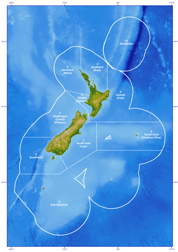
New Zealand Seafood Industry Council
New Zealand Ministerial Inquiry
Selected Submissions to the Ministerial Inquiry on the Use of Foreign-Chartered Vessels
http://www.hokkaido-np.co.jp/cont/suisan-oukoku/14119.html
安定供給を口実に、現状の過剰な漁業者による、過剰な漁獲を正当化するロジックがいかにデタラメかは自明である。水産庁だけでなく、組合も、漁業者も、御用学者も、みんな言っている。安定供給を口実に、業並みの手厚い保護を勝ち取ろうとしているが、実に浅はかである。漁業者が多すぎるから魚が減るという当たり前の事実に、納税者は遅かれ早かれ、気づくだろう。補助金依存度を高めたら最後、補助金なしには存続できない産業になってしまう。そして、補助金はいつまでも出せる国家財政ではない。補助金おねだり作戦のもたらす結果は、漁業の延命ではなく、確実な破滅なのだ。
船舶法違反などの疑いで書類送検されたのは、長崎県佐世保市にある海運業者です。
この業者は、所有する日本船籍の砂利運搬船の船体に、パナマ船籍だと虚偽の表示をしていたほか、日本沿海しか航行できないこの船を北朝鮮と韓国の間の国際航路で使用していた疑いが持たれています。
この船は、北朝鮮の海で取れた砂利を韓国に運搬する事業に使われていましたが、この事業には日本船籍の船が使用できない取り決めになっていたため、船籍を偽装していたとみられています。
また、大阪市の海運業者も、この事業に参入するため船籍を偽装していた疑いが持たれていて、海上保安庁は、近くこの業者も書類送検する方針です。
逮捕されたのは、パナマ船籍の貨物船、「STAS」の2等機関士で、ロシア人のリバルコ・オレグ・ユーリエビッチ容疑者(50)です。
秋田海上保安部によりますと、ユーリエビッチ容疑者は殺傷能力のある空気銃1丁と弾丸819発を秋田市の秋田船川港に停泊していた貨物船の部屋に隠し持っていたとして、銃刀法違反の疑いが持たれています。
2月9日、秋田海上保安部などがベニヤ板の荷揚げのために停泊していた貨物船を立ち入り検査したところ、空気銃などが見つかったということです。
調べに対し、「自分のものだ」と供述し、容疑を認めているということです。
秋田海上保安部は、空気銃を持っていたいきさつなどについて詳しく調べています。
他の3容疑者はナイジェリア、ロシア、フィリピン国籍。
オークワン容疑者のリュックサックに覚せい剤を持っていたが、4人とも「なぜリュックに入っていたか分からない」と容疑を否認
しているという。「下船後は岡山空港から東京に行き、飛行機で母国に帰るつもりだった」と供述しており、県警は4人が国際的な
密売組織の「運び屋」とみて、日本側の受取人など背後関係を調べる。
4人の逮捕容疑は、昨年12月22日午前11時20分ごろ、バミューダ船籍のタンカーで水島港に寄港し、覚せい剤を密輸
した疑い。水島税関支署の職員が港内の手荷物検査場(倉敷市水島福崎町)で、リュックから不審なビニール袋2個を
発見し、県警に通報した。
県警によると、タンカーは液化天然ガス6万200トンを積載して昨年11月24日、ナイジェリアを出発。12月21日、水島港に
到着した。4人は荷降ろしが終わった翌22日、休暇を取り下船した。
水島税関支署は12日、関税法違反(禁制品輸入未遂)容疑でオークワン容疑者を岡山地検に告発した。
約6キロ(末端価格約4億2000万円)を持ち込んだ疑い。
<山陽新聞デジタル 2016年1月12日配信記事より転載>
4人は他にロシア、フィリピン国籍で、リュックサックに隠して運び込もうとしたとみられ、「なぜ覚せい剤がリュックに入っていたか分からない」などと容疑を否認しているという。4人は「岡山空港から飛行機で東京まで行き、母国に帰る予定だった」とも話しているといい、県警は4人が密売組織の「運び屋」で、日本側に受取人がいたとみて、背後関係や流通ルートの解明を進める。
4人の逮捕容疑は、昨年12月22日午前11時20分ごろ、バミューダ船籍のタンカーで寄港し、同市水島福崎町の水島税関支署の手荷物検査場から覚せい剤を密輸した疑い。逮捕は同日付。
同支署職員がオークワン容疑者のリュックの中に、ビニール袋などで何重にも巻かれた覚せい剤の袋2個を発見、県警に通報した。
県警によると、タンカーは液化天然ガス6万2千トンを積載して昨年11月24日、ナイジェリアの港を出港、同12月21日水島港に到着した。4人は荷降ろしが終わった同22日、下船した。
水島税関支署は12日、関税法違反(禁制品輸入未遂)容疑でオークワン容疑者を岡山地検に告発した。
県内の覚せい剤密輸事件では、岡山空港で2010年と12年に1回ずつ計約5キロを摘発。新岡山港では11年11月、貨物船の中国人船員が仲間に約3キロを手渡す事件が起きている。
押収された覚醒剤の量は末端の密売価格で4億円あまりと県内では過去最多で、4人はいずれも容疑を否認しているということです。
逮捕されたのはナイジェリア人のオークワン・ゴズタイム・チディマ容疑者(30)らナイジェリア人とロシア人、それにフィリピン人の船員4人です。
警察によりますと、12月22日、オークワン容疑者ら4人はバミューダ船籍の貿易船から降りて日本に入国しようとした際、覚醒剤およそ6キロ、末端の密売価格でおよそ4億2000万円分を密輸した覚醒剤取締法違反の疑いが持たれています。
入国する際の税関の手荷物検査でオークワン容疑者のリュックサックの中からポリ袋などで何重にもくるまれた覚醒剤が見つかり通報を受けた警察などが逮捕したということです。
4人の乗った船は去年11月にナイジェリアを出発し水島港まで液化天然ガスを運んできたということで、船長など29人の乗組員がいましたが4人だけが水島港で入国しようとしたということです。
警察の調べに対し、オークワン容疑者は「なぜ覚醒剤が自分のかばんの中に入っているのかわからない」などと供述し、ほかの3人も「知らない」などと容疑を否認していて、岡山空港などを経由してそれぞれ帰国する予定だったと話しているということです。
警察では入手ルートや覚醒剤の販売先などについても調べを進めることにしています。
岡山県警察本部によりますと、押収された覚醒剤の量は統計が残っている昭和54年以降で県内では過去最多だということです。
押収された覚醒剤の量は統計が残っている昭和54年以降で、岡山県内では過去最多。
昨年の2015年12月22日の午前11時20分ごろ、ナイジェリアから岡山県倉敷市の水島港に入港していたバミューダ国籍のタンカーから降りて、共謀して結晶状の覚醒剤約6キロ(末端価格約4億2000万円)を密輸したナイジェリア国籍とロシア国籍とフィリピン国籍の船員の男4人。
入国する際の手荷物検査で、水島税関支署の職員が港内の手荷物検査場(倉敷市水島福崎町)でナイジェリ国籍の船員(30)のリュックサックから不審なビニール袋2個を発見。
ポリ袋などで何重にもくるまれた覚醒剤を発見し、通報。
昨年の2015年11月24日、ナイジェリア国籍らの船員4人を乗せたバミューダ船籍のタンカーは液化天然ガス6万200トンを積載してナイジェリアを出発。
2015年12月21日、岡山県倉敷市の水島港に到着。
荷降しが終わった翌、12月22日、ナイジェリア国籍ら船員4人は休暇を取り下船。
船長など29人の乗組員がいたが、ナイジェリア国籍ら船員4人だけが水島港で入国しようとした。
ナイジェリア国籍らの船員4人が国際的な密売組織の「運び屋」とみて、日本側の受取人など背後関係を調べる。
逮捕されたのは
ナイジェリア国籍の船員、オークワン・ゴズタイム・チディマ容疑者(30)。
他にナイジェリア国籍、ロシア国籍、フィリピン国籍の船員の男3人。
合わせて船員の男4人。
ナイジェリア国籍のオークワン・ゴズタイム・チディマ容疑者(30)は「なぜ覚醒剤が自分のリュックの中に入っているのかわからない」と容疑を否認。
他のナイジェリア国籍、ロシア国籍、フィリピン国籍の船員の男3人も「知らない」などと容疑を否認。
「下船後は岡山空港から東京に行き、飛行機で母国に帰るつもりだった」と供述。
ナイジェリア国籍、ロシア国籍、フィリピン国籍の船員は岡山空港から東京へ行き、飛行機でそれぞれの国へ帰国するつもりだったらしい。
これまでもナイジェリア人、ロシア人の覚醒剤密輸が発覚してる。
日本国内に仲間がいて、大量の覚醒剤を「運び屋」として密輸。
東京に密売組織の仲間がいたのだろうか。
門司税関などは密輸の背後関係を詳しく調べている。
逮捕容疑は4月14日、北九州市の門司港で、自身が機関長を務める貨物船に重さ約1キロの板状の金塊4枚を積み、税関に申告せずに輸入した疑い。門司税関によると、ユー容疑者は4枚を靴の中に入れたり、ベルトの裏側に貼り付けたりしていたという。挙動を不審視した税関職員が任意で身体検査して発覚した。
3人の逮捕容疑は共謀して4日午前11時半ごろ、同所の大型スーパーで、お茶や菓子パンなど食料品11点(販売価格計3336円)を万引。さらに、1人は犯行を目撃し追い掛けてきた警備員女性(56)の手を振り払う暴行を加えた疑い。
同署によると、2人は逃走したが、取り押さえられた1人が持っていた運搬船の乗員上陸許可証から割り出した。1人は容疑を否認。他の2人は認めている。(本紙、千葉日報オンラインでは実名報道)
開けない人はここをクリック
脅された!!
内容の一部
海洋汚染の防止に関する大臣共同声明
日本船主協会:環境コーナー
経済協力開発機構
違法許した甘い監視
「危険と隣り合わせ 東京湾」
4カ国造船首脳会議、初の議長声明で合意
指摘されなければ、問題ない!!古い体質は、どの業界も同じか??
◆サブスタンダード船
◆サブ・スタンダード船と旗国の関係
◆なぜ、サブ・スタンダード船?
◆サブスタンダード船の見つけ方
◆サブスタンダード船の写真
◆検査会社の問題
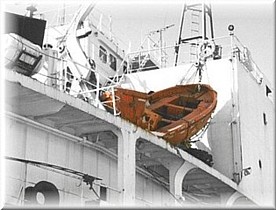
★HOME
◆海運関連業界
◆なぜ、サブ・スタンダード船?
◆BLUE OCEAN(ブルーオーシャン)の事故
◆座礁船及び放置船
◆PSCによる検査の現状
◆船舶油濁損害賠償保障法
リンク先の中には繋がらないものもあると思いますが、ご容赦ください。
 カンボジア籍船
カンボジア籍船 トーゴ籍船
トーゴ籍船 モンゴル籍船
モンゴル籍船 シエラレオネ籍船
シエラレオネ籍船 フィジ籍船
フィジ籍船 ベリーズ籍船
ベリーズ籍船 ミクロネシア籍船
ミクロネシア籍船 パナマ船籍
パナマ船籍 フィリピンでの船舶による油流出事故
フィリピンでの船舶による油流出事故 韓国客船 Sewol沈没
韓国客船 Sewol沈没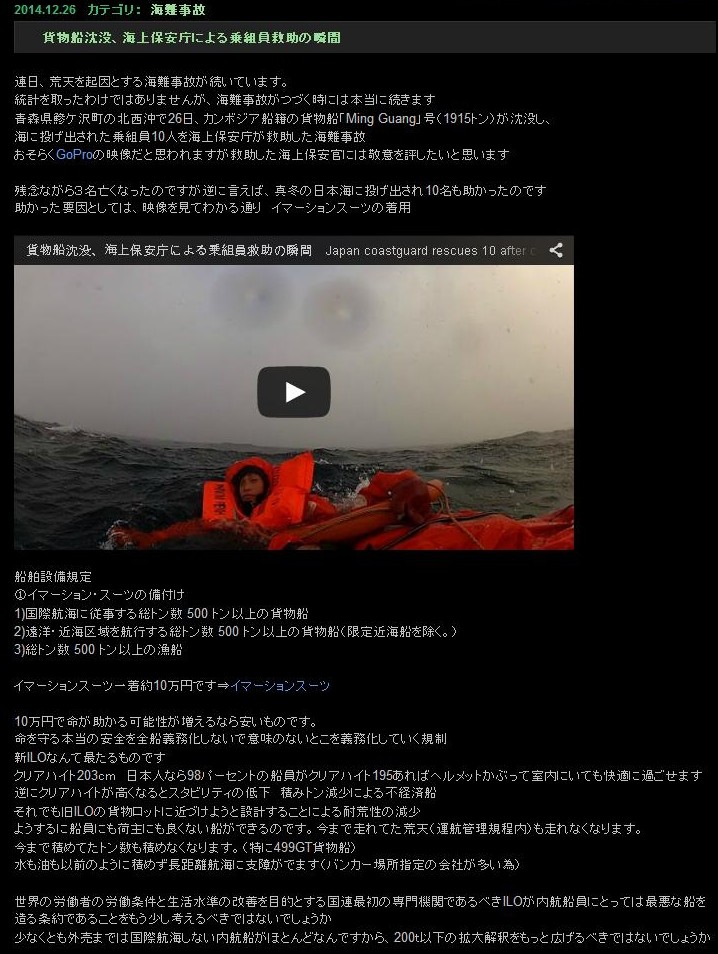
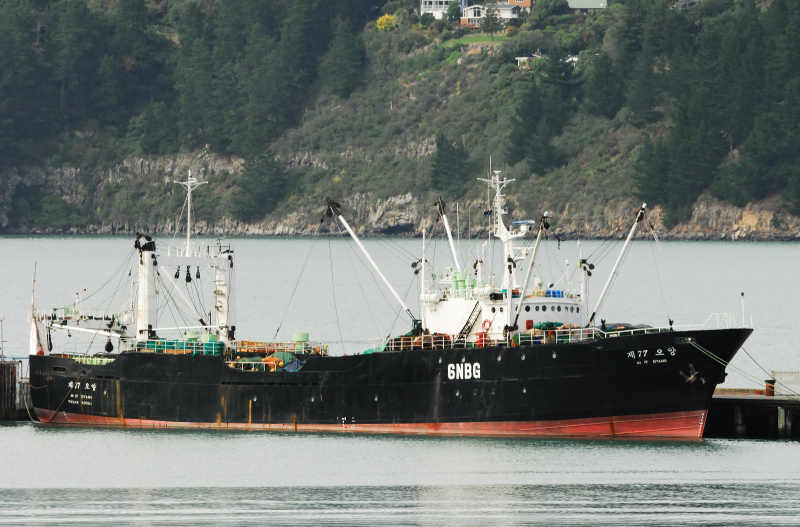
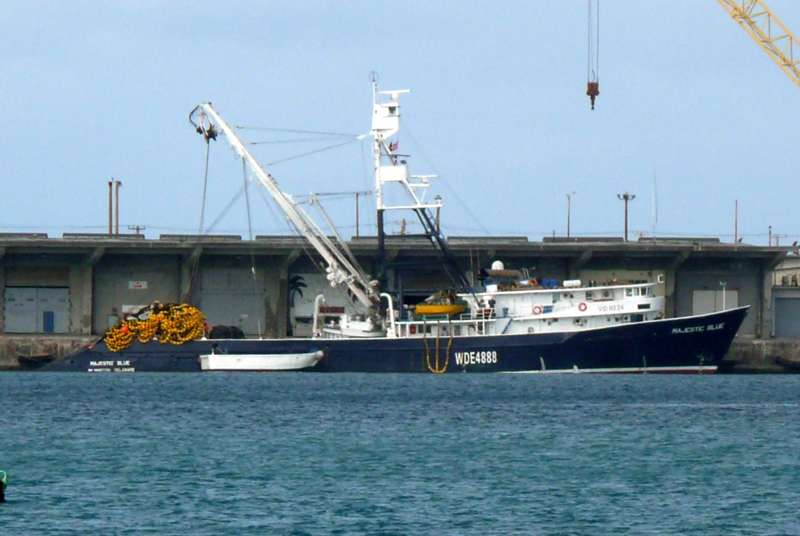
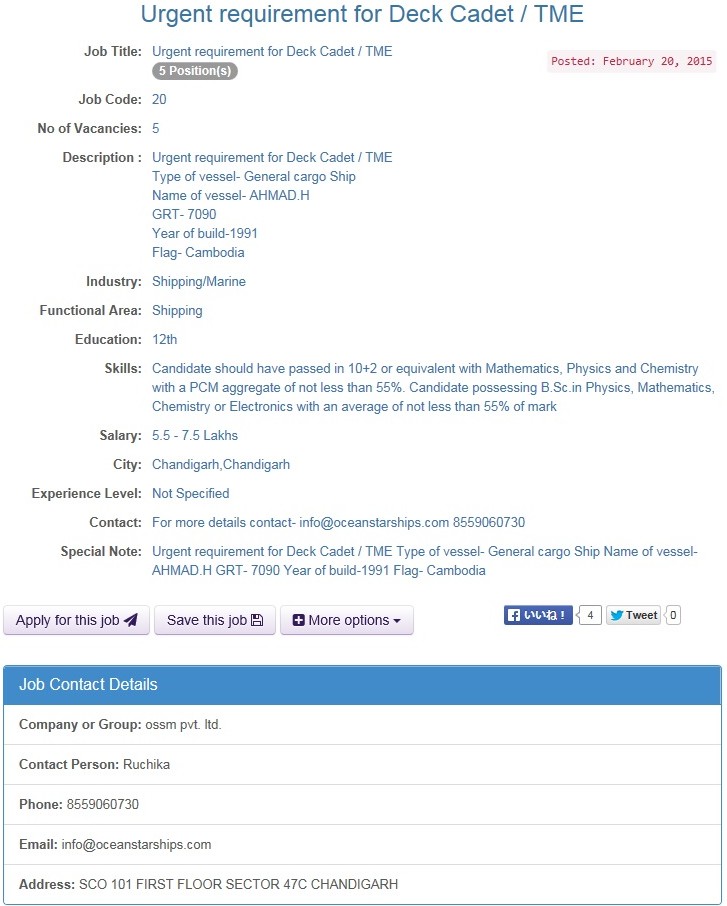 Urgent requirement for Deck Cadet / TME (Sirjobs)
Urgent requirement for Deck Cadet / TME (Sirjobs)